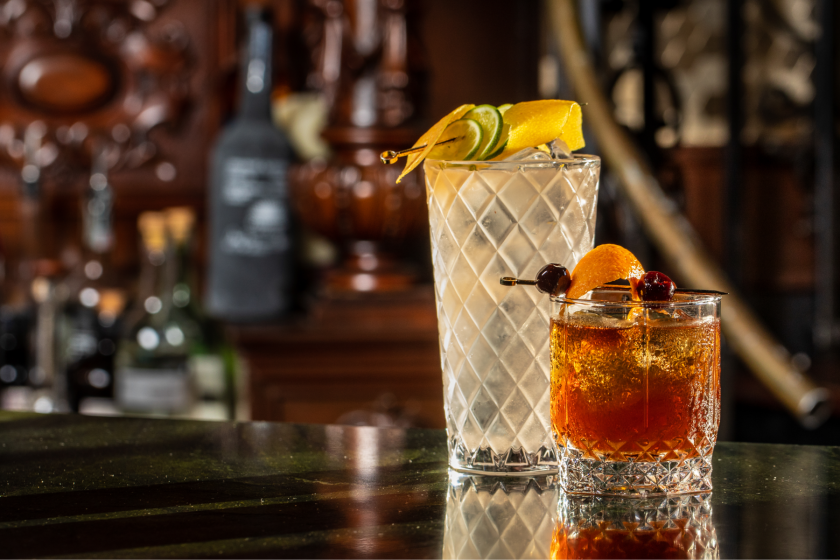These are the 101 best restaurants in Los Angeles of 2022
Welcome to the 10th annual L.A. Times guide that attempts to answer a delicious, impossible question: What are the 101 restaurants that best embody excellence and convey the essence of our food culture?
No matter what fresh flavors and hot openings the year brings, a guiding premise holds fast: L.A.’s astounding dining scene is a sum of California’s farmlands, the region’s pluralism and the city’s unique shimmer of possibility — the sense that an original personal narrative expressed through noodles or a stew’s secret ingredient is waiting just off the next freeway ramp.
Restaurant critic Bill Addison and columnist Jenn Harris rank the 101 best restaurants in Los Angeles.
Restaurants appearing for the first time comprise more than a quarter of the 2022 list. Among them are a Malaysian cafe in Alhambra where the power play is coffee and toast; a streetside taqueria in Highland Park where a quesotaco’s first bite delivers eight flavors at once; and a sprawling bilevel space in downtown L.A.’s Arts District where two chefs, who are married, explore Korean American identity via congee pot pie with roasted abalone and biscuits smothered in curry gravy.
Three other newcomers announce the city’s golden age of pizza, and that’s not counting the label-defying sports bar in Silver Lake where the saucy, cheesy pies can arrive crowned with tandoori onions or chicken tikka.
Some places that previously dropped off have returned. This is a living document. It happens. The occasion is particularly joyful when a favorite like Here’s Looking at You in Koreatown bounces back; it reopened in January after the pandemic forced a 17-month hiatus.
Feeling thirsty? Here are the 10 best places around Los Angeles for drinks.
And yes, the restaurants are ranked again for the first time since 2019.
Jenn Harris joins me in naming 10 places we’re excited to be drinking right now. After a two-year break we’ve also brought back our Hall of Fame, with 14 new inductees so intrinsic to our dining culture that they deserve their own category.
These restaurants are so defining of what it means to eat and live in Southern California — that they’ve earned a place of honor for all time.
Is that cheating? So be it. This is my fourth year agonizing over the 101, and the fixed number feels shorter every go-round. There’s simply too much to celebrate.
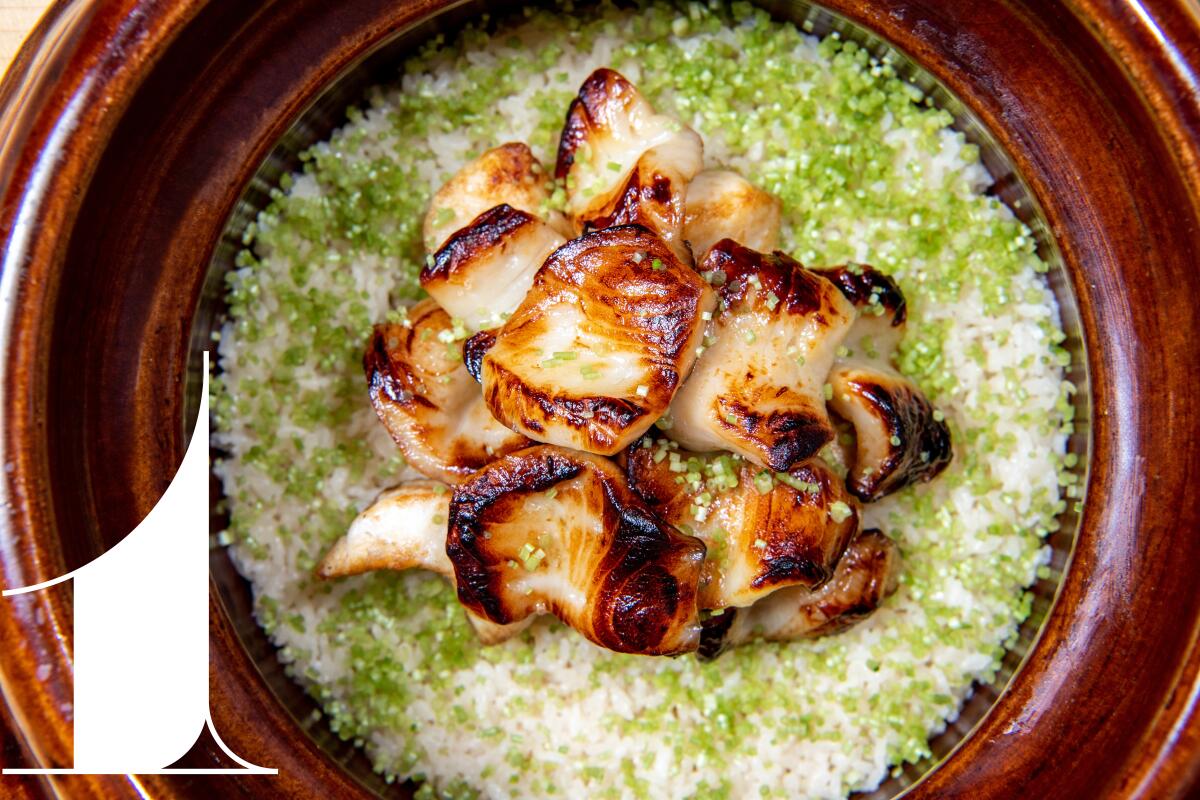
Hayato
There is no fourth wall at Hayato. With seven diners seated along a cedar counter, Go and his small crew stay in continuous motion for several hours, composing more than a dozen courses. Washoku (a broad term for traditional Japanese cooking) and kappo ryori (in which the chef prepares a series of refined plates in front of the customer) inform his style of cooking. The meal’s structure loosely follows kaiseki, emphasizing varied cooking techniques served in ceremonial order. Whether Go has bound together scallops and corn in the laciest summertime tempura or steamed the sweetest fall Hokkaido crab, whether he’s grilled rockfish and lotus root to a smoky copper sheen or presented a lacquered bowl of dashi with an orb of shrimp that’s equal parts snap and silk, the quality of the seafood is profound.
Go began working at his father’s sushi restaurant in Seal Beach when he was 15. He’s been cooking in front of people for nearly 30 years. He can be at once immersed in his tasks and disarmingly relaxed. He tells funny travel stories; people lob out random questions about his favorite places to eat in Los Angeles. Bottles of wine may be shared among customers who arrived as strangers. By the time there are seconds (or thirds) of black cod and rice, followed by muskmelon and matcha for dessert, the group can be almost slaphappy from elation. It’s happened at each of my handful of meals at Hayato, this dinner-party-of-the-gods moment Go creates without forcing or staging a mood. I drift into the night always with the same feeling: That was some serious food, but that was also a seriously fun evening.
Read the full review of Hayato
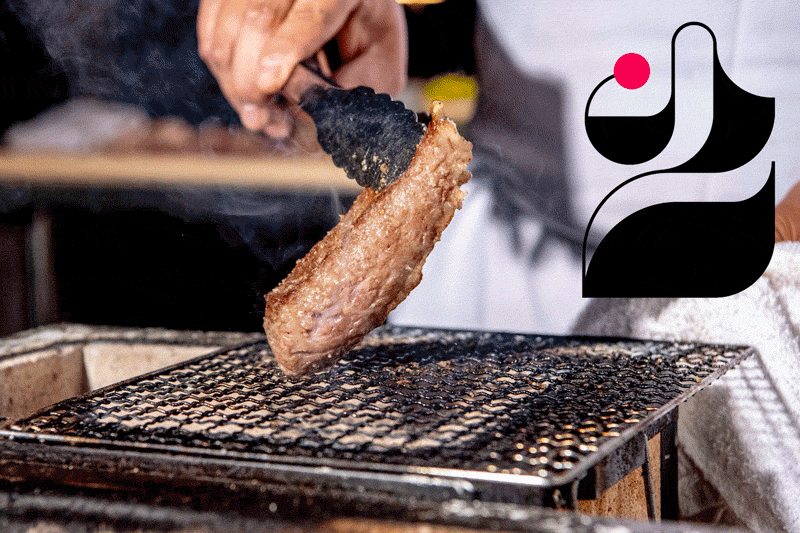
Anajak Thai
At Thai Taco Tuesday, or #TTT as Justin tags it on Instagram, expect weekly whims — perhaps blue corn tortillas cradling Ora King salmon dressed with purple cabbage, a slick of mayo, chili crisp and nam jim, or tostadas overlaid with rounds of lap cheong, brightened with mint, or lobes of kanpachi dotted with salmon roe. All the while, the restaurant’s primary menu is tighter, truer, stronger. Fried chicken wings have a tauter sour-sweet edge in the tamarind glaze; Massaman brisket curry, lush and aromatic, comforts profoundly. Fried chicken, a newer restaurant staple, is sheathed in rice-flour batter and scattered with fried shallots. The bird is prepared in the style of Nakhon Si Thammarat, a city in Southern Thailand where Rattikorn Pichetrungsi, Justin’s mother, has family. An optional side of caviar is very much Justin’s idea of embellishment.
The cooking, in whichever format you experience it, evinces skill and delight. In July we named Anajak Thai as the L.A. Times’ Restaurant of the Year.
Read more about Anajak Thai:
Why we chose Anajak Thai as Restaurant of the Year
Your next great L.A. meal will probably be a tasting men
What makes an L.A. restaurant?
How this L.A. chef made Thai Taco Tuesday a thing
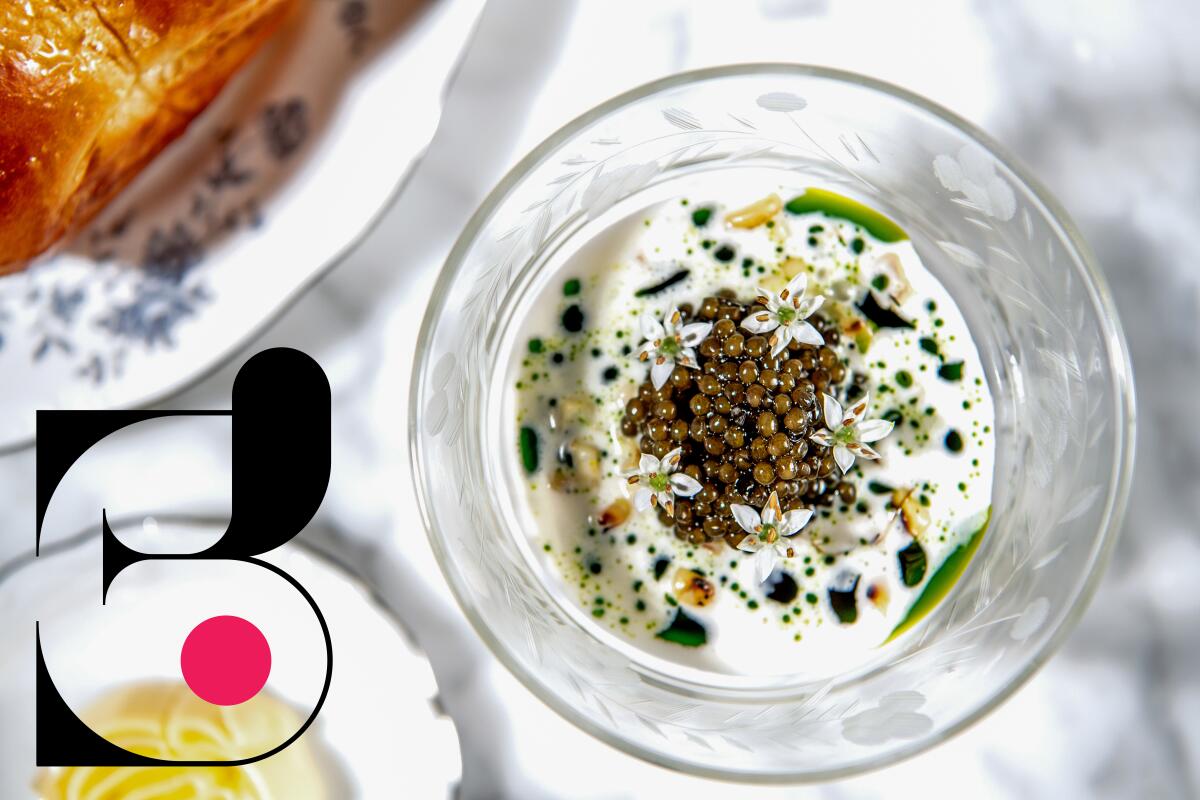
Kato
Kato 2.0 has grown in every way possible since its move nearly a year ago. With the expansion comes an all-in beverage program, including a 60-page wine list, steered by new partner Ryan Bailey. Bar director Austin Hennelly mixes some of the city’s brainiest cocktails. Even if you don’t spot it on the menu, see if he’ll make you a Bamboo; his martini-like blend of sake and vermouth tinged with tomato brandy and soy nicely readies the palate for the meal ahead.
From the kitchen, scallops or other seasonal seafood will arrive in a fish-fragrant sauce, the perfumes of garlic and ginger blazing like a comet’s twin tails. A hot brown-butter doughnut with uni and Ibérico ham will precede a showstopper of Dungeness crab and spinach in a wild butter sauce that involves mussel liquor, fermented cream and smoked onions. Caviar crowns the dish, of course. The cost is $225 per person. It’s a worthy splurge, however you consider Yao’s food. If you’re looking to parse the almost clinical dissection of nostalgia, identity and luxury, the intellectual fodder is there. If you want simply to savor a beautiful, thoughtful sequence of plates, he can make you feel nourished on many levels.
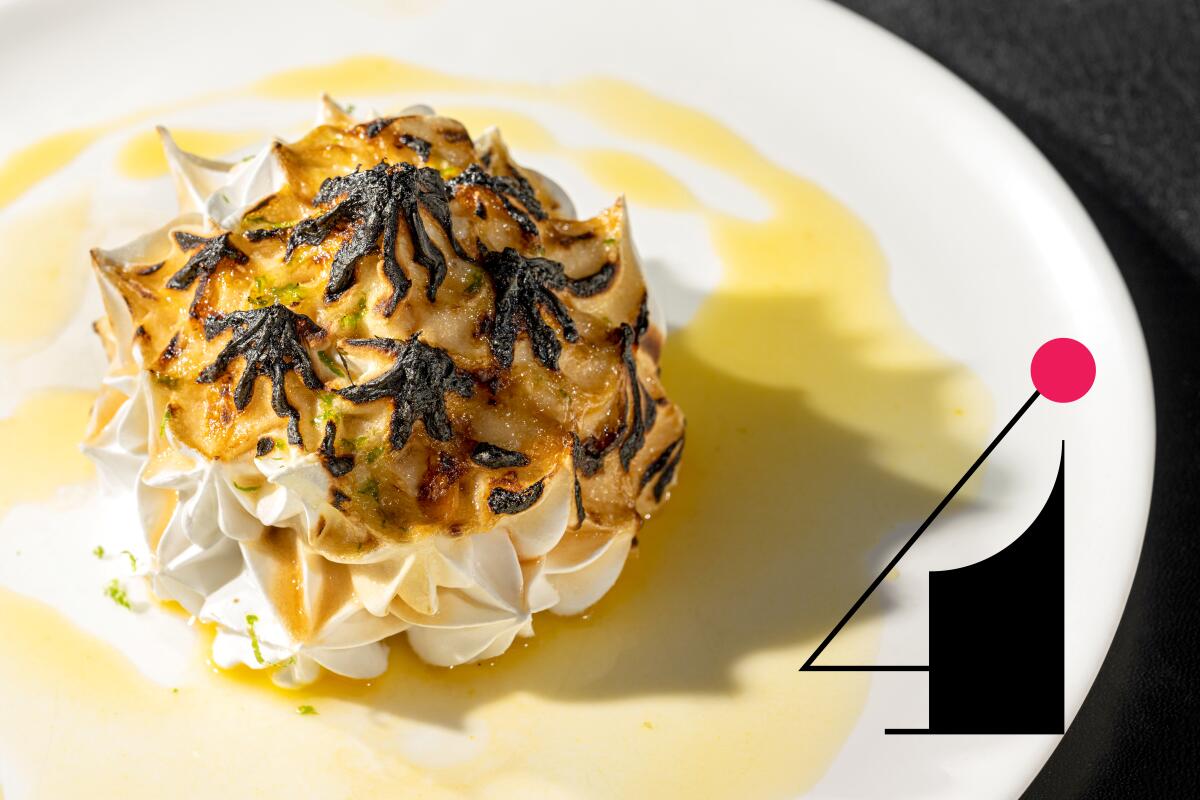
République
First things first: Margarita and her team lay out one of the country’s finest pastry selections. They fill the counter with cakes, sweet and savory pies, canelés, fruit-filled tarts and laminated doughs so finely structured their layers can be stretched like an accordion. It’s a whirl of gracious plenty. Arrive early and round out the morning with a pale omelet, billowing French toast or the signature kimchi fried rice with short rib and poached eggs. Break away from Zoom for a couple of hours at lunch and meet someone for salads and a dry-aged burger.
At night the restaurant transitions elegantly to formal dinner service. Start by indulging in Normandy butter and pan drippings (imagine gravy distilled from a thousand roasting pans at Thanksgiving) served with one of Margarita’s baguettes. Walter uses meticulous technique, grounded in French tradition, to both comfort and startle. His gifts are as evident in a farmers market salad with precisely vinegared dressing as they are in the deft snap of grilled spot prawns and the goodness of roasted duck among a fall collage of squash, apples, onions and drizzles of peppery cider jus. Wine director Sarah Clarke has just the right Burgundy in mind. Need it even be said that dessert is all but mandatory?
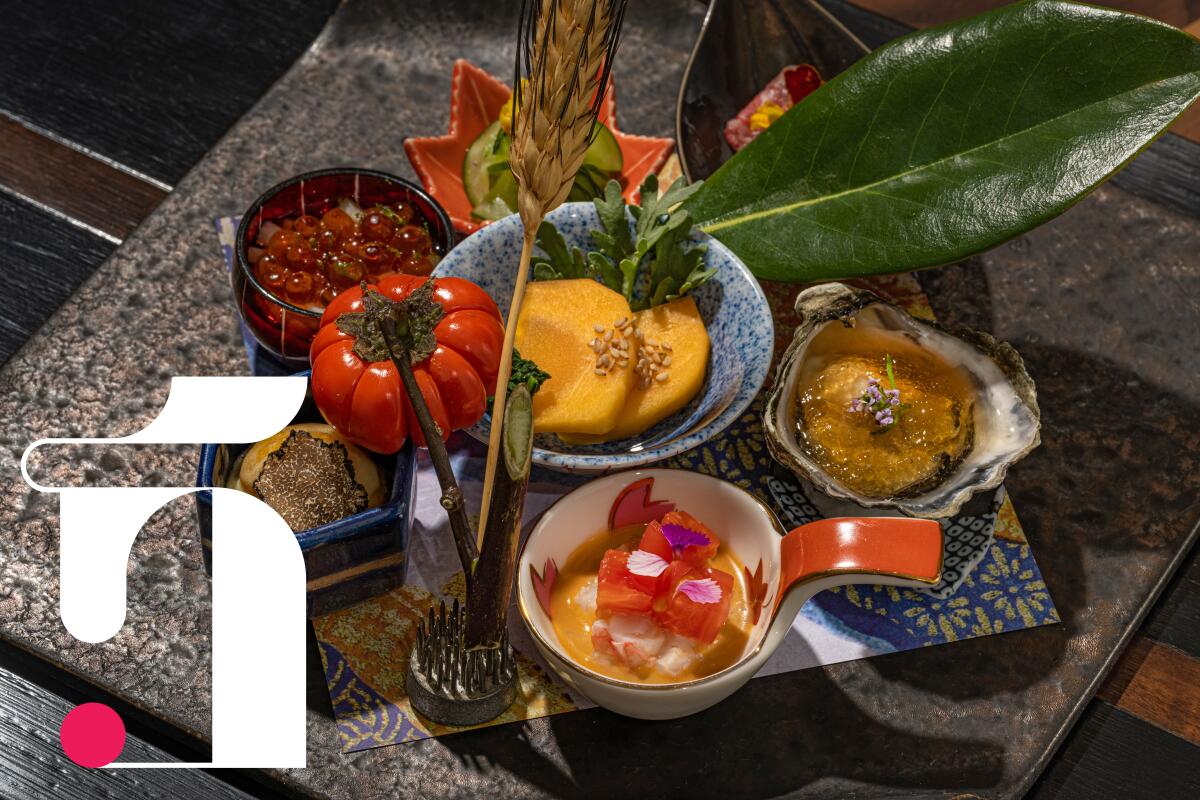
n/naka
Niki Nakayama composes her tasting menus around the precepts of kaiseki, which evolved out of Japanese tea ceremony traditions, but she isn’t confined by its structure. Along with Carole Iida-Nakayama, her wife and fellow chef, she follows an Angeleno’s regard for the farmers markets and for her own unmovable individualism. Their plates revise the notion of “what grows together, goes together” into Mary Oliver poems. Forests and seas of vegetables, noodles, seafood and broths appear as distinct habitats. It’s as if they’ve somehow occurred naturally, though the skill involved is also obvious and tremendous.
You will need to fight like hell for a reservation at n/naka. It will be worth it.
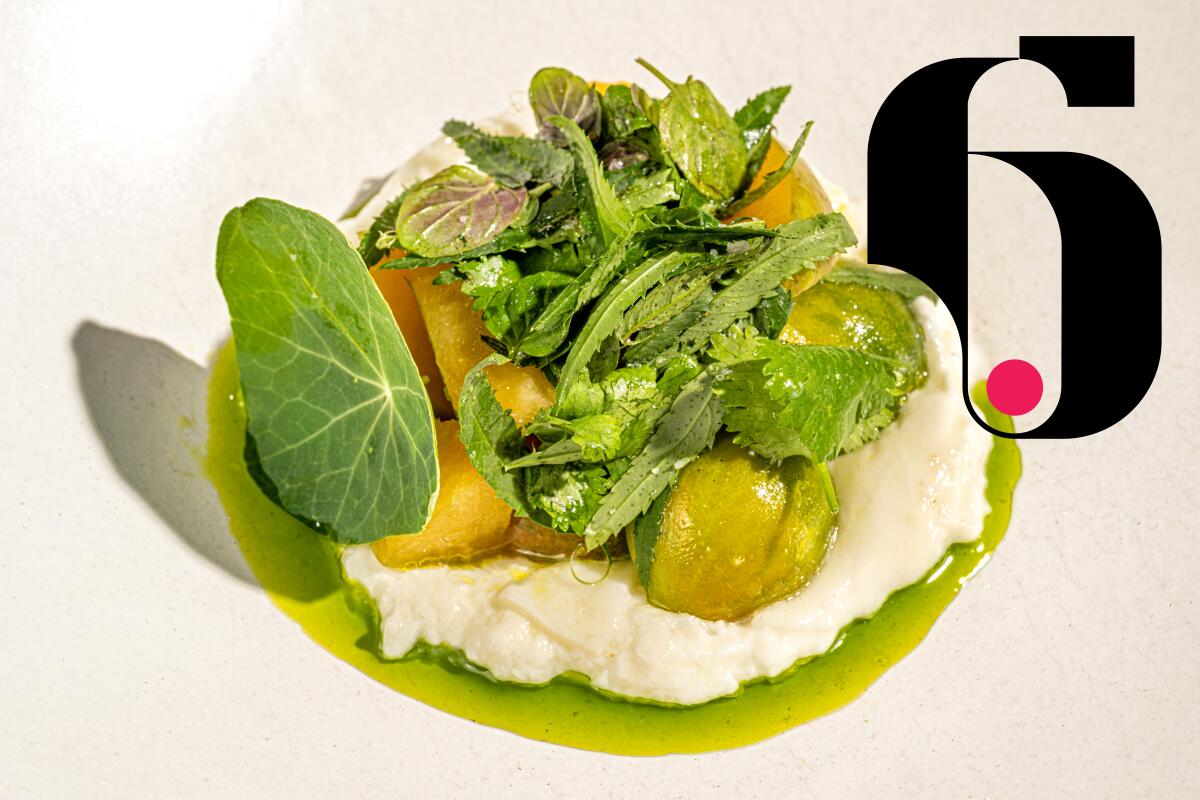
Taco Maria
Since Taco María opened in 2013, Salgado has been working with small farms in Mexico to obtain superior maíz varietals that he and his restaurant staff nixtamalize and grind into masa. In philosophy and practice, masa anchors Taco María’s Alta California cuisine. Somewhere between campechano reimagined with tomato consommé gelee and a block of pork belly served over meaty cocoa beans and grilled nopales strips, you will hold a blue corn tortilla in your hands. Its color will be as inky as the face of a new moon. Inhale its aromas, then tear into it and marvel at the nuances. The tortillas alone are worth the evening traffic from whichever county you may be driving. To experience Salgado’s influential genius and his small, spare indoor-outdoor restaurant, you must navigate through warrens of design stores in a fancy Costa Mesa mall. This is Southern California. No one thinks twice.
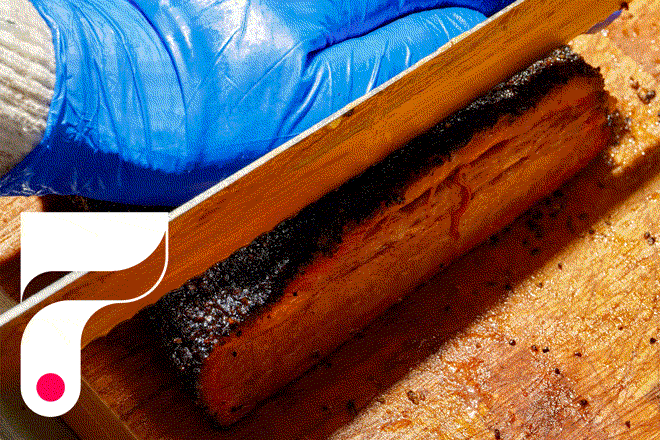
Moo’s Craft Barbecue
So yes, Andrew rightly acknowledges the Lone Star roots of his craftsmanship. He renders brisket nearly to pudding; the meat on his pork ribs, with their barky crust, nicely tugs back a little. But their efforts are not solely about homage. They’ll glaze pork belly burnt ends with gochujang as a special, and the tres leches strawberry bread pudding served on the weekends sells out fast. The thick, campfire-scented burgers have their own cult. On the shoulders of Mexican and Indigenous pit-cooking traditions and the Black barbecuers who arrived in Southern California as part of the Great Migration, the Muñozes are setting the tone for a new school of Los Angeles barbecue.
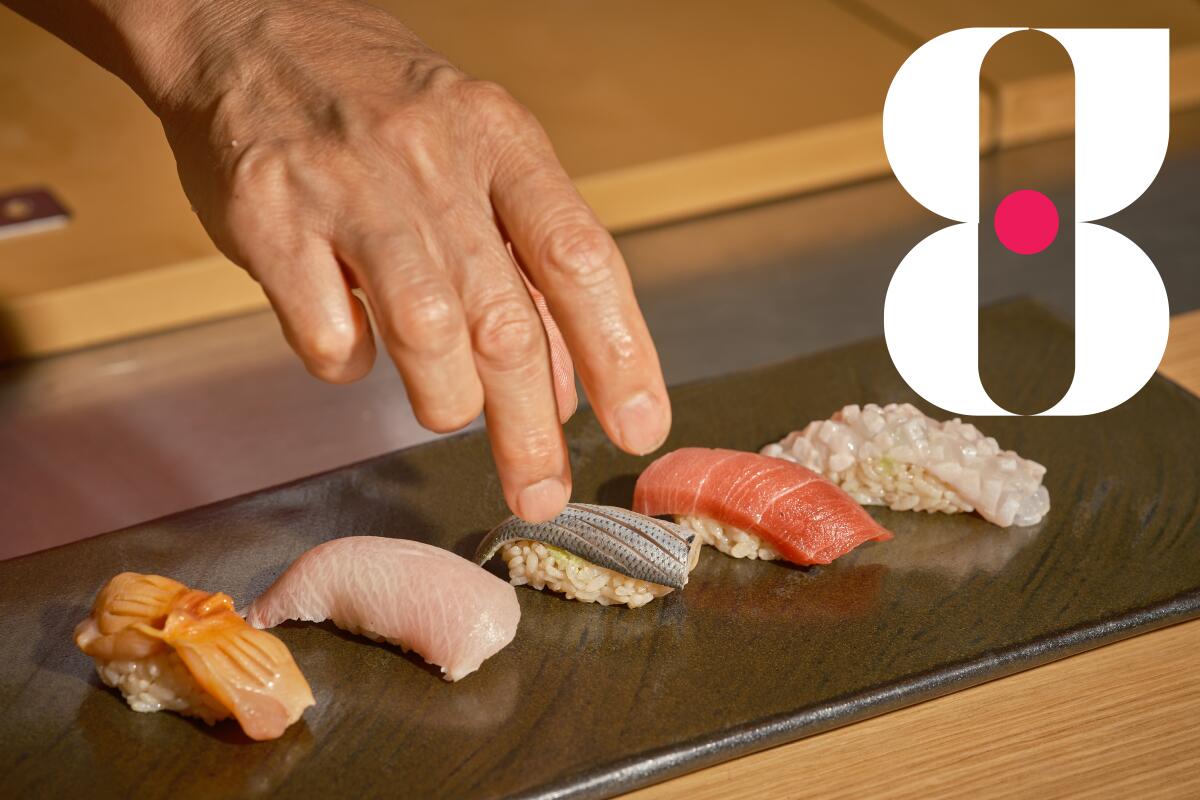
Morihiro
Onodera has a special place in L.A. His splicing of traditions and innovations, his quest for the perfect sushi rice and his talents as a ceramist have made him a legend. Some sushi bars radiate serenity, or gravity. His tiny place exudes a chaotic sort of warmth. Seiichi Daimo, a certified sake sommelier, pours the most compelling pairings of any sushi bar in L.A. When I joked with Onodera once that he serves so many opening omakase courses that maybe some customers could leave satisfied without any nigiri, he bellowed back, “No way. This is a sushi restaurant!” You will leave very full and deeply aware that this is what fine dining in Los Angeles is all about.
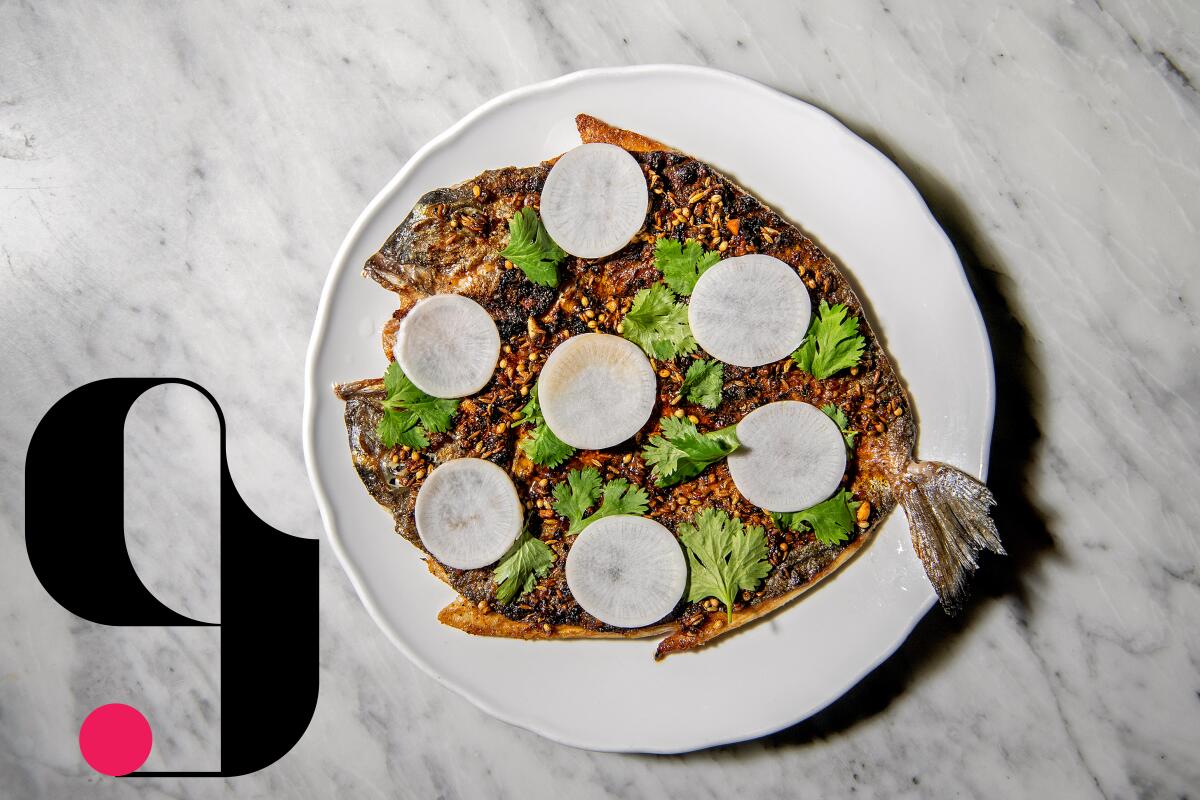
Bavel
From iterations of hummus and baba ghanoush at their silkiest to chicken liver pâté sequined with tarragon leaves and pickled blueberries, the spreads with their sides of hot pita or buckwheat toast are the menu’s nucleus. Anchoring ingredients — roasted cauliflower, grilled prawns, lamb chops both charred and blushing — are canvases for brushstrokes of chile pastes, herbs and many forms of deliciously soured dairy. Of the three restaurants she and Menashe run, Gergis chooses Bavel as the most dazzling showcase for her pastry skills. Finales like licorice root ice cream bonbon (try it to understand) or clove-scented chocolate doughnuts with sherried cream deserve their due attention, even after all the amazing bread. Also, after four years and a pandemic, it’s lovely to see the vines that trail from the dining room rafters looking so healthy.
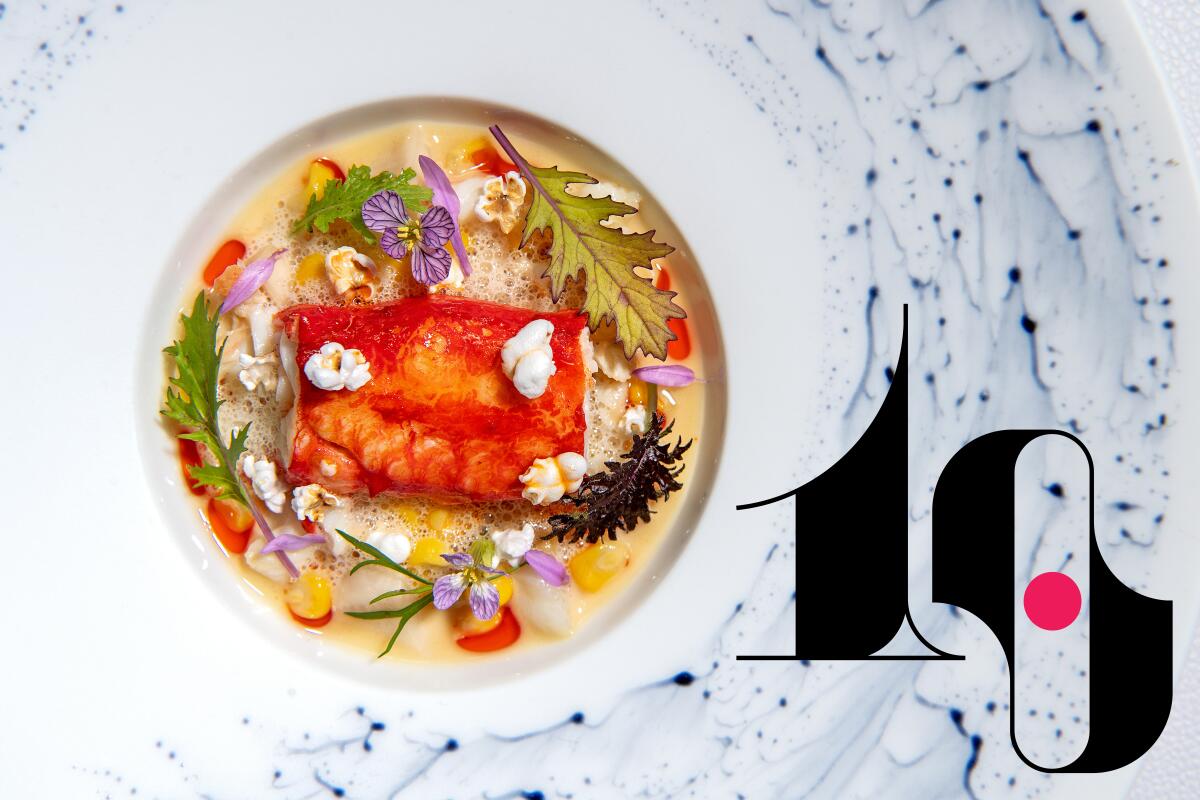
Providence
If you desire, white truffles will rain down over risotto or golden scrambled eggs; cocktails can be made tableside; and a sommelier might arrange a parade of wine pairings that costs nearly as much as the tasting menu, which is $295 per person. Go ahead and splurge on the optional uni egg gilded with Champagne beurre blanc. Fanciness without human connection feels vacant, and the warm, alert individuality that Providence’s service team brings to the experience has contributed as much to the restaurant’s longevity as the brilliant food. I recently brought a 30-something Times colleague (who doesn’t work on the Food team) for his first dinner to Providence, and at the end of the evening he said, “If I make it to 80 I’m still going to be thinking about this meal.” I sat with his words for a minute, and then I thought: Same.

Sonoratown
Díaz Rodriguez and partner Jennifer Feltham rose to national prominence at the taqueria they opened in 2016 in DTLA’s Fashion District. This year we gained a second location in Mid-City. Same menu; same brilliance.
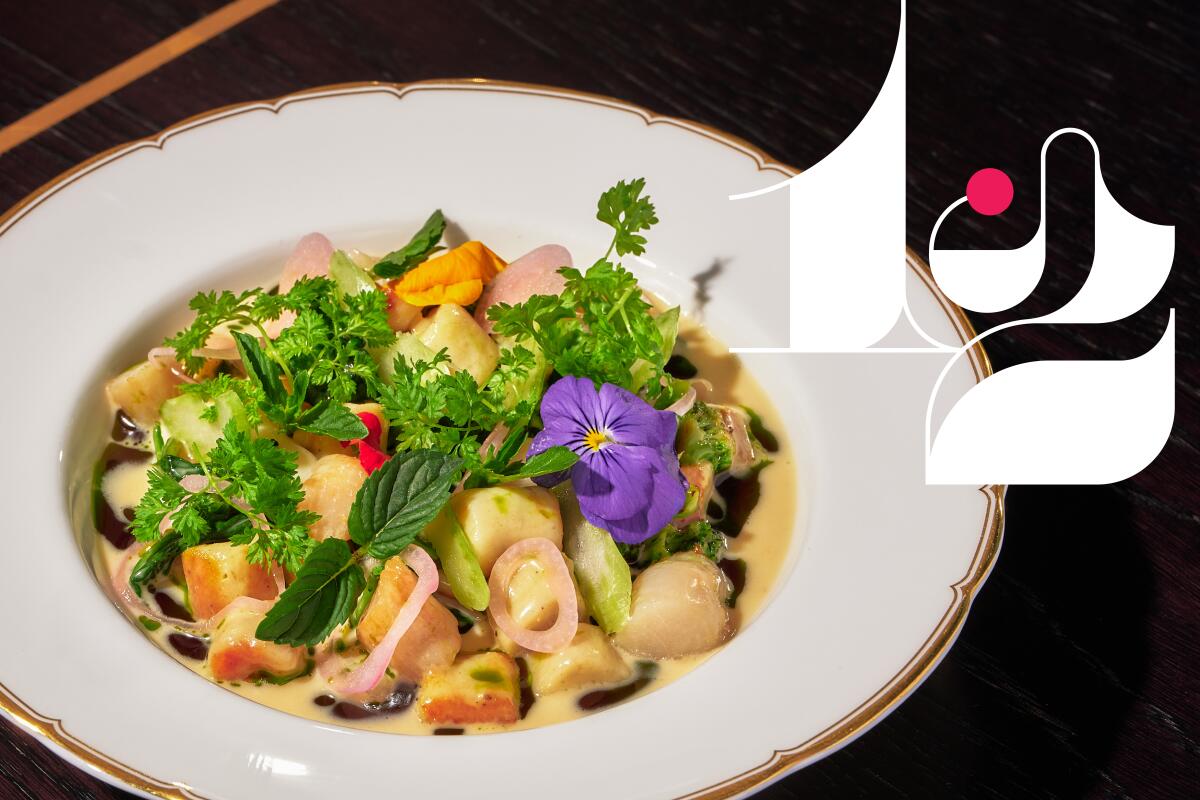
Pasjoli
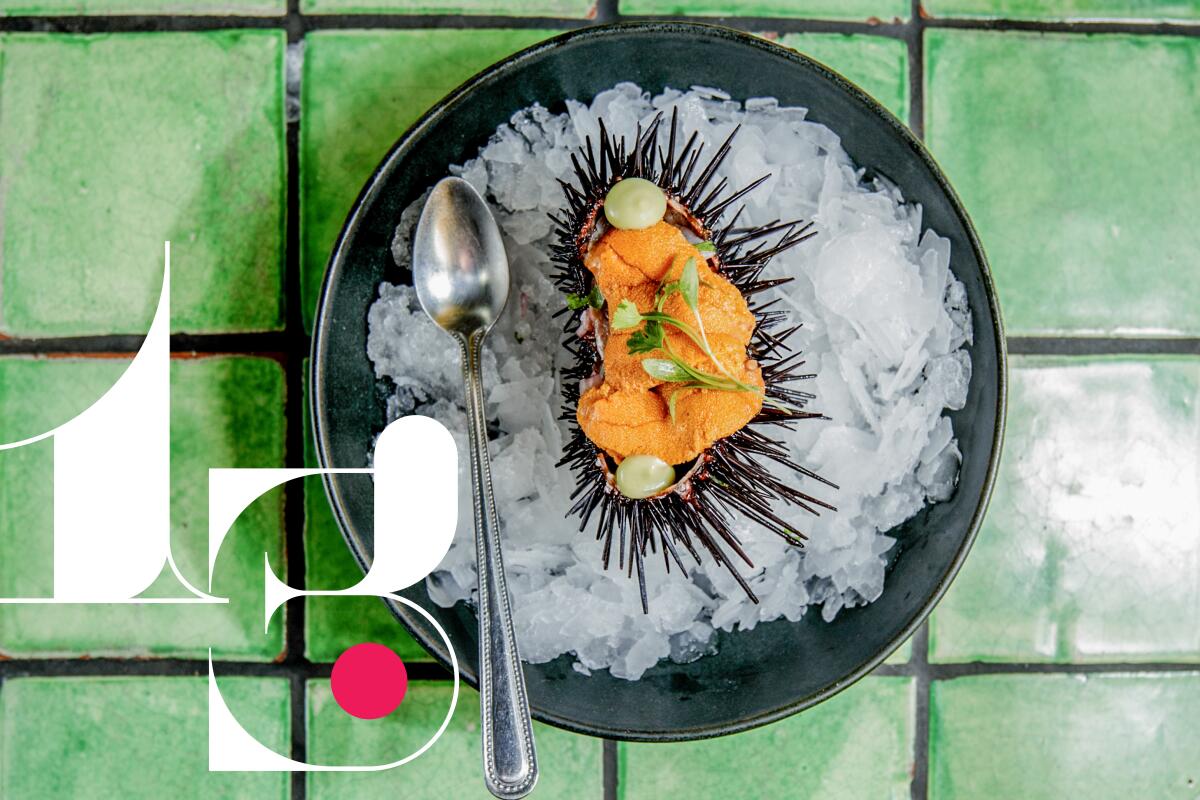
Holbox
The best news? After a two-year absence Cetina has revived his weekly six-course tasting menu. Holbox’s 10-seat counter takes on the intimacy of a sushi bar as he passes out aguachile in wincingly tart citrus marinade, the better to offset the sweetness of scallops and spot prawns, and a fried taco filled with Dungeness crab and smoked yellowtail. The cost is currently $95 per person. I’ve paid twice as much in Los Angeles for meals half as revelatory.
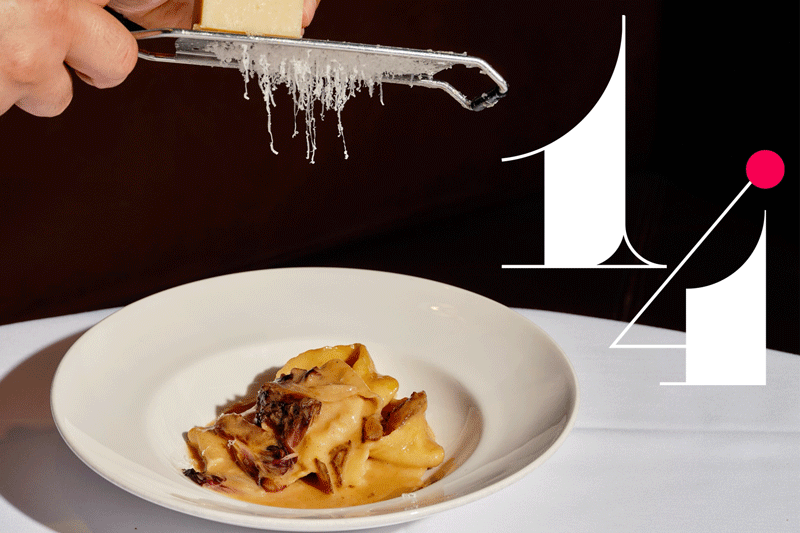
Osteria Mozza
Osteria Mozza, under the current guidance of culinary director Liz Hong, heralded the decade when Los Angeles became one of the world’s most exciting dining cultures. Silverton is a global culinary ambassador these days. I haven’t seen her behind the bar in years. Still, when mozzarella di bufala meets the papery cruschi peppers that almost rustle against the teeth, and the yolk bleeds into the brown butter under the raviolo, I feel the same Mozza excitement. More than 15 years since its debut, a little is lost but a whole lot remains.

Orsa & Winston
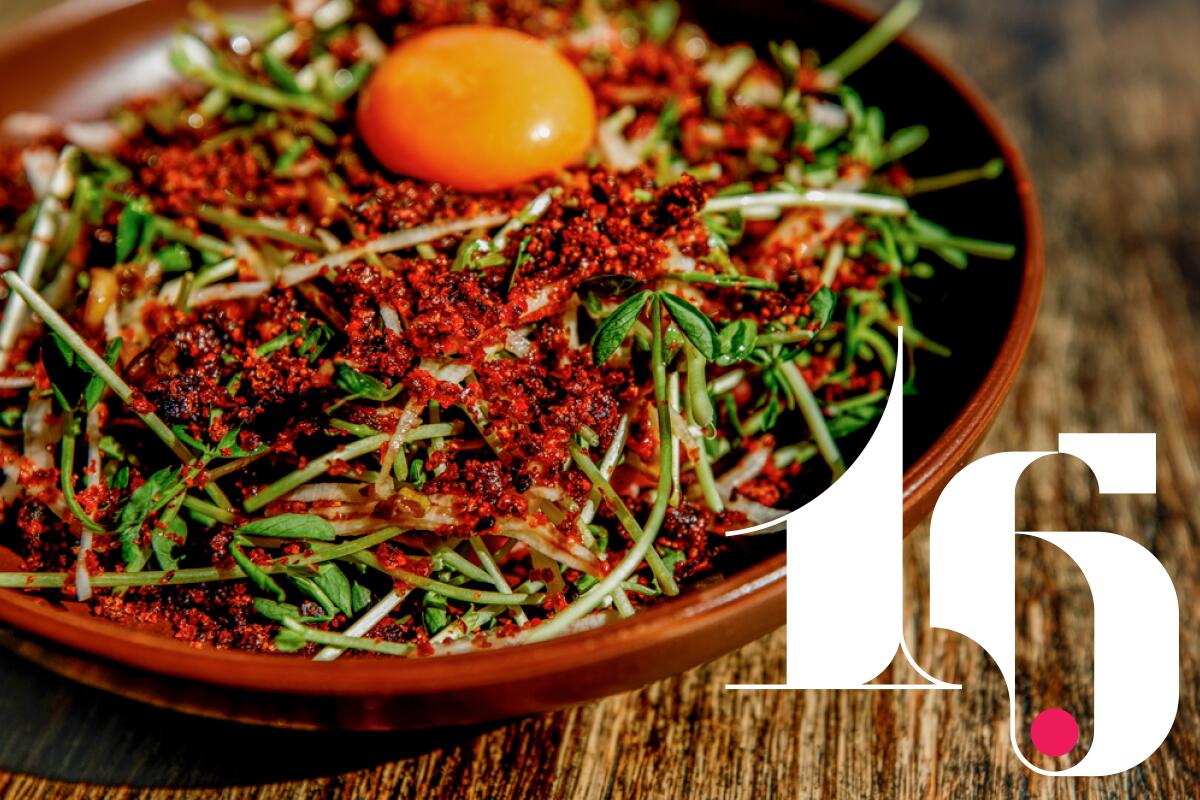
Here's Looking at You
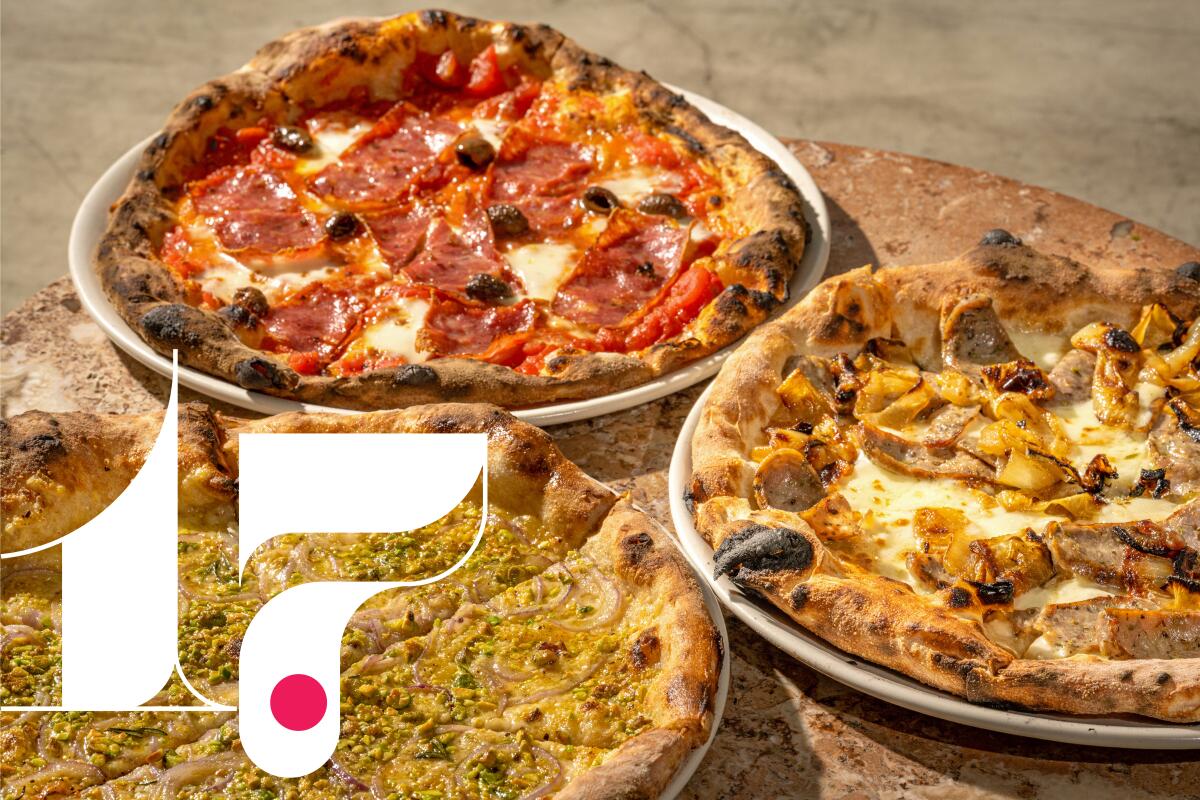
Pizzeria Bianco
When you do finally inhale these pizzas, with their balanced restraint and structured crust, you understand why Bianco is the most revered pizzaiolo in the United States. The Wise Guy (a pie with rough hunks of fennel sausage covered in smoked mozzarella) and the Rosa (slivered red onion, Parmesan, rosemary, crushed pistachios) brought me the same heart-pounding joy as the first time I ate them in 1997, half my lifetime ago. Head chef Marco Angeles ably translates Bianco’s genius at the pizza ovens, and right now the man himself is spending much of his week in town. Keep checking for chance availability. We have a living master in our midst.
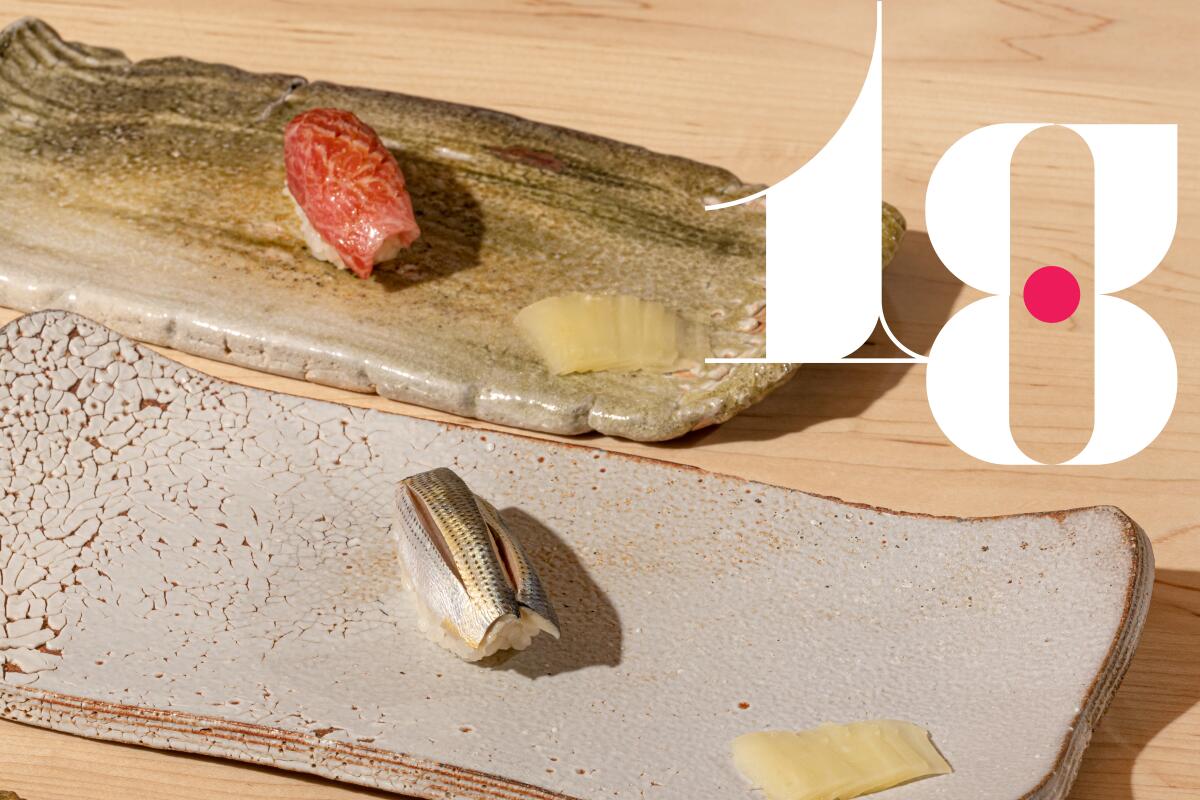
Sushi Kaneyoshi
A few preambles might include grouper karaage; citrusy chawanmushi laced with matsutake mushrooms; and ankimo (monkfish liver) dressed in sweet miso and paired with a tiny log of green onion. Then Inoue and his assistants launch into a procession of edomae-style nigiri, each seasonal seafood aged (or perhaps cured or marinated) and lightly seasoned to magnify its flavors. At one point he’ll likely hand each person pressed sushi folded into a sheet of nori that crunches like a potato chip. By the final piece you’re in the master’s trance. This is sushi for connoisseurs, many of whom, at $300 per person, are already regulars.
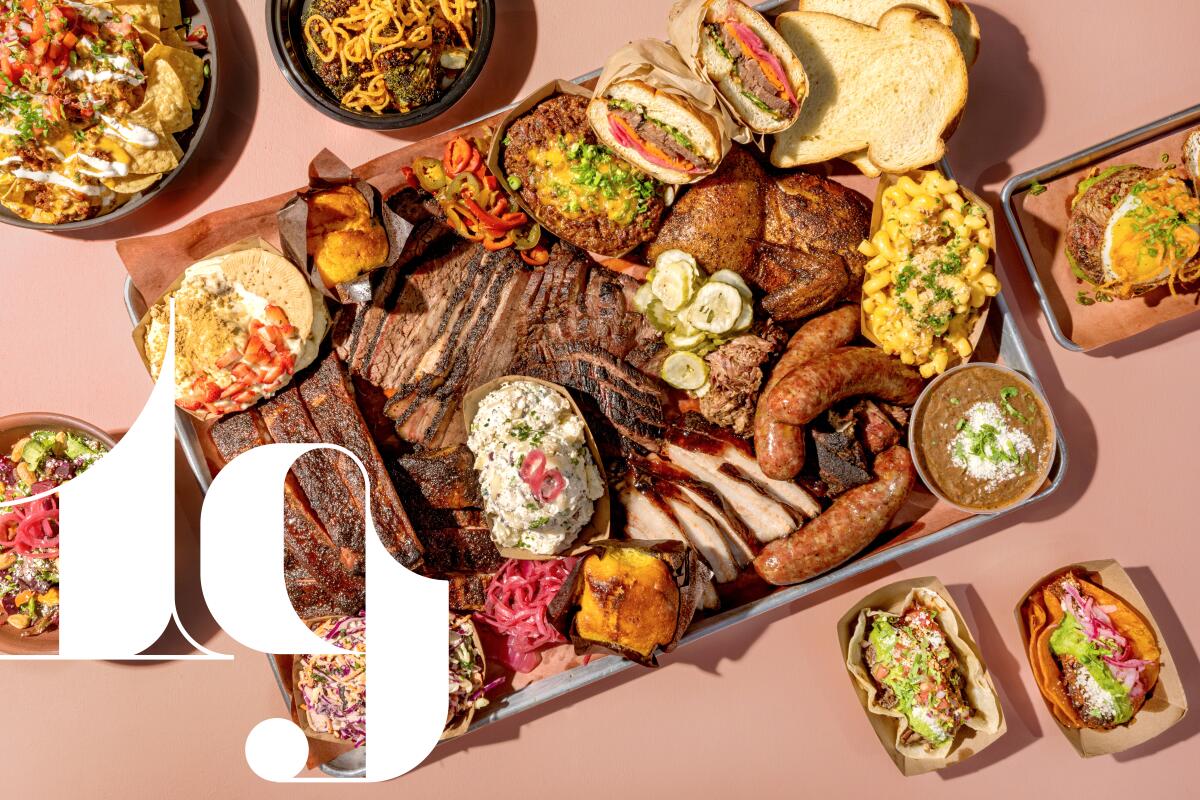
Heritage Barbecue
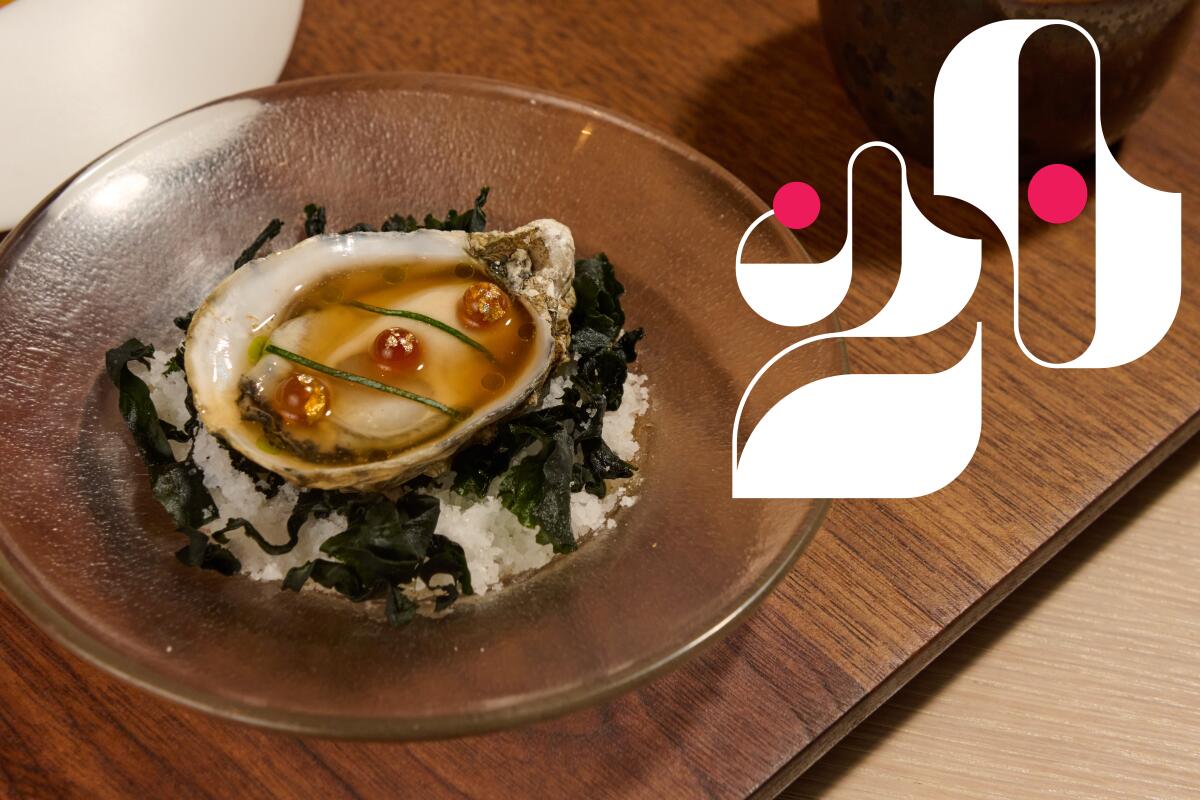
Mélisse
For this venture, Citrin recruited two talents who make Mélisse’s price of admission — currently $325 per person— worthwhile for celebratory occasions. Chef de cuisine Ian Scaramuzza has fine-dining credits that include In Situ, the now-closed restaurant in the San Francisco Museum of Modern Art that rotated the masterwork dishes of 80 chefs like a gallery collection. I recognize a similar range of his virtuosity at Mélisse. It’s there in the parade of luxury ingredients; in its one- or two-bite wonders displayed on textured plates and mini pedestals; and in the leaps in perspective, from crab intensified with finger limes and house-made XO sauce to smoked quail arranged among ripe pluots, matsutakes and bacon gastrique.
Scaramuzza has a fitting counterpart in wine director Matthew Luczy, a showman, at turns serious and playful, who is a blur of motion making everyone in the room feel special at once. He orchestrates a brainy wine pairing of side-by-side glasses per course for comparative tasting, though he’s equally game to help you choose a spot-on bottle. He’ll uncork it as soon as he flips the Sade LP playing on the restaurant’s sterling sound system.
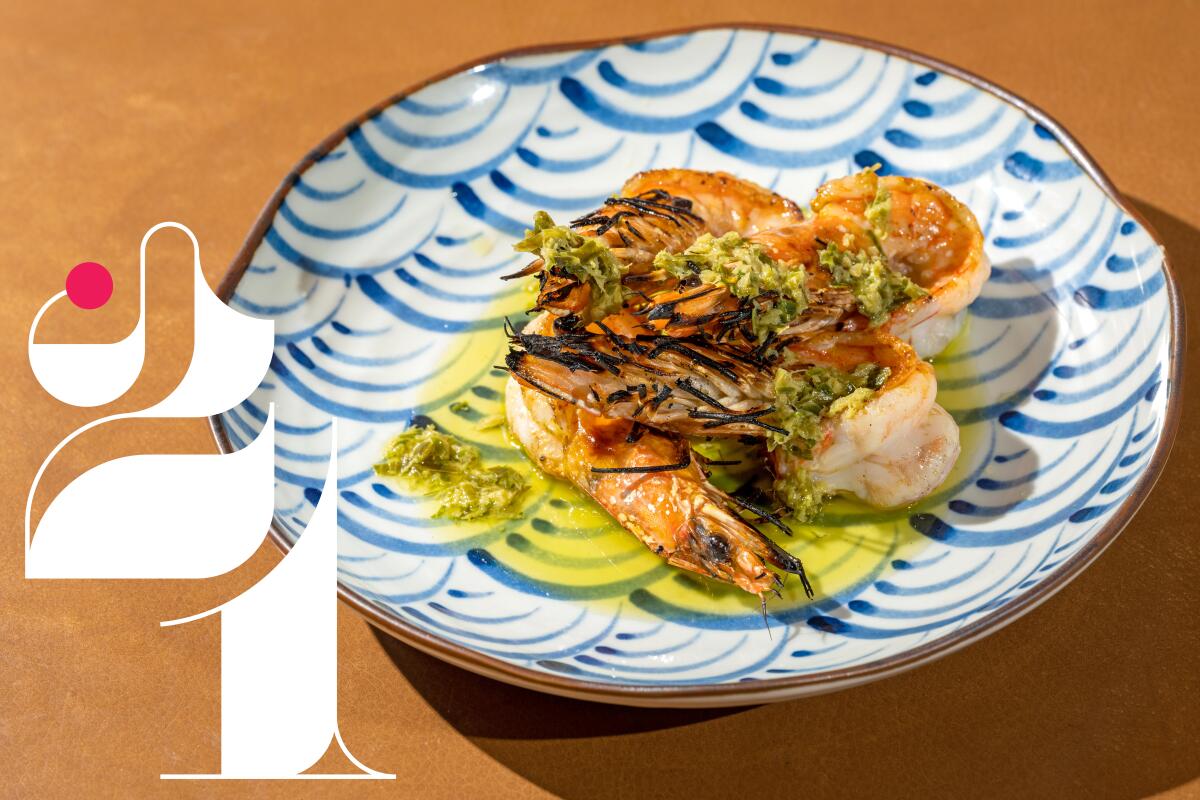
Tsubaki
Kaplan’s selection of sake is one of the deepest and most exciting on the West Coast. I brought a visiting friend here after he gave an incredible performance in a staging of Haydn’s “The Creation” at Disney Hall. I asked Kaplan if she could recommend a sake that felt as celebratory as Champagne. When she poured a golden sparkling liquid that tasted of melon, my friend’s eyes popped with joy, and I was reminded why I often bring out-of-towners here. An even more immersive imbibing experience awaits next door at the couple’s sake bar, Ototo, where the finesse of the okonomiyaki and other drinking foods has all but caught up to the cooking at Tsubaki.
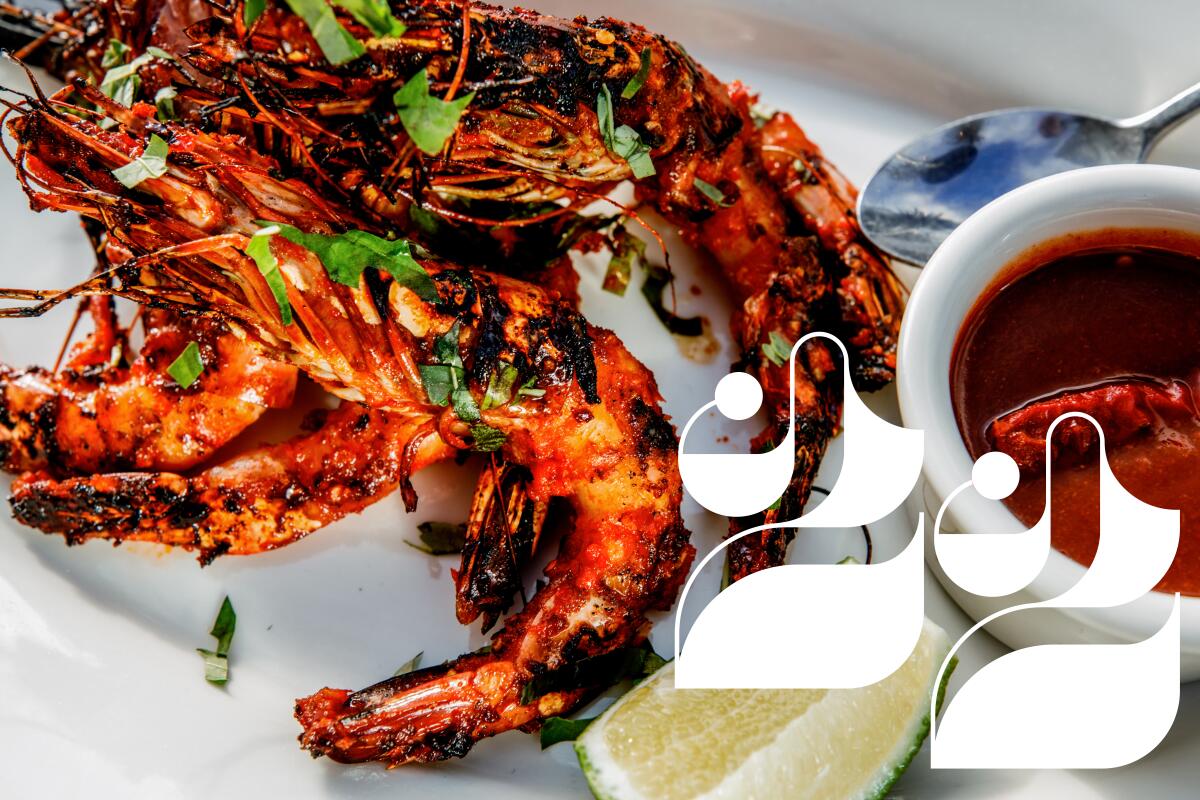
Cassia
Ace sommelier Marianna Caldwell leads her wine list with a section labeled “What I’m Drinking Now.” Let it direct you to offbeat options — like a Hungarian orange or a lemony Alpine white from Switzerland — that meet the food in all its superb complexities.
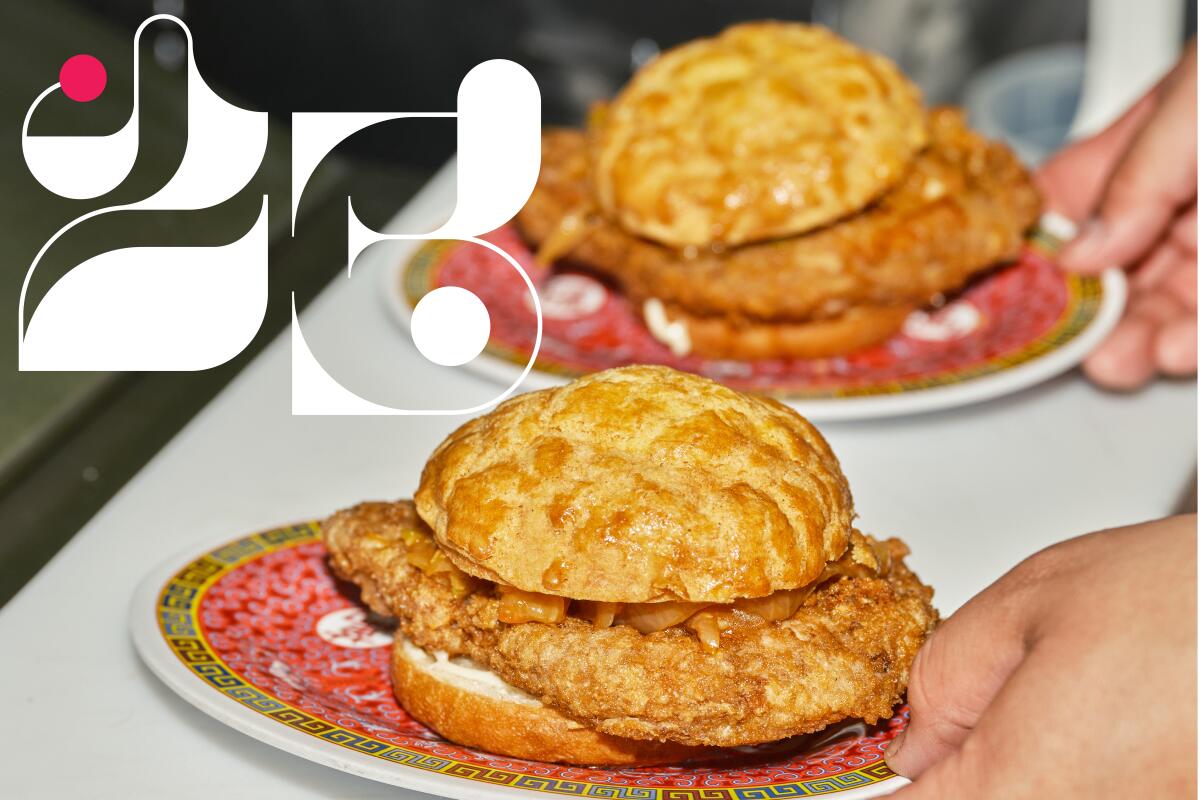
Pearl River Deli
True to those words, no single label neatly defines Pearl River Deli, though Lee devised it foremost as a personal expression of Cantonese cooking. There will likely be char siu, the rendered slices of pork belly glossy with five-spice glaze on a plate of either rice (ideal for soaking up the meat’s juices) or egg noodles (pleasing in their tangled, textural contrast). Legions of us will be bereft if the extraordinary pork-chop bun, slicked with tomato-onion relish and mayo umami-boosted with Maggi seasoning, disappears for long. Otherwise, we embrace the creative anarchies of Lee and chef de cuisine Laura Hoang, who is responsible for the case full of pandan chiffon cake and char siu bao. They are two of her most masterful creations. Will she still be baking them by the time you read this? I wish I could tell you.
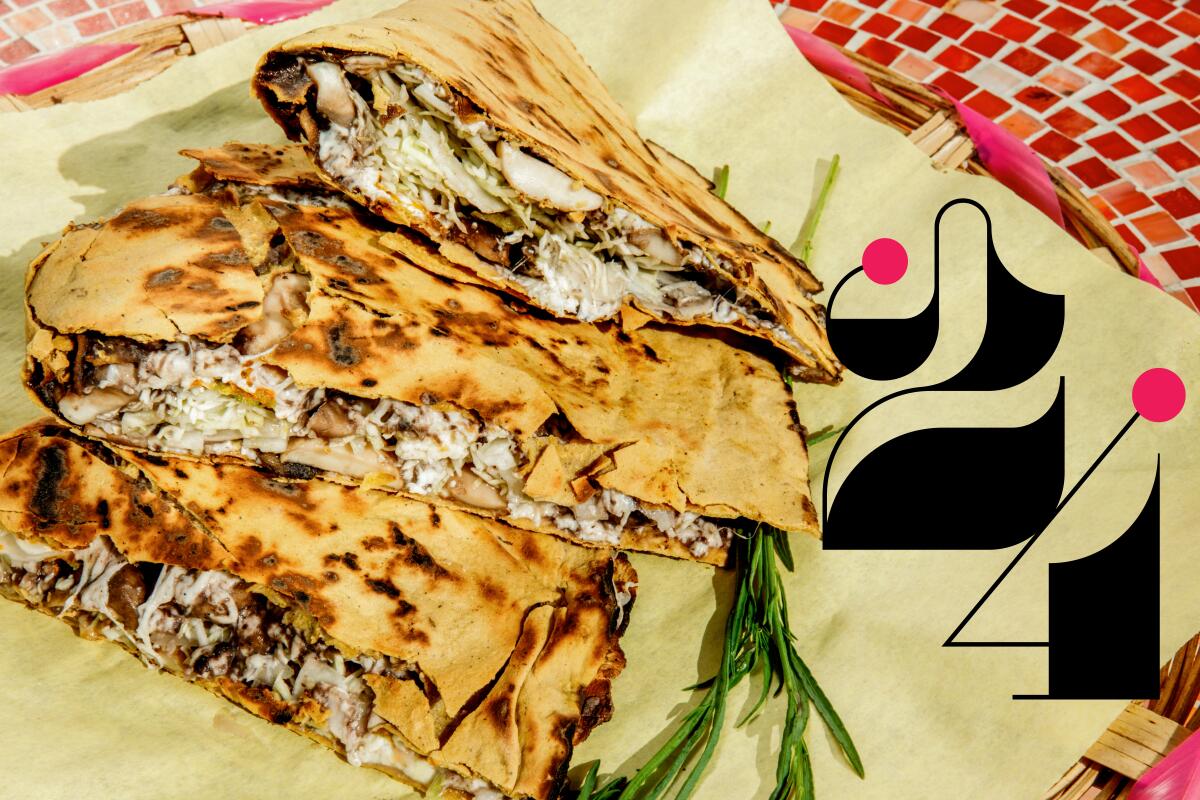
Poncho’s Tlayudas
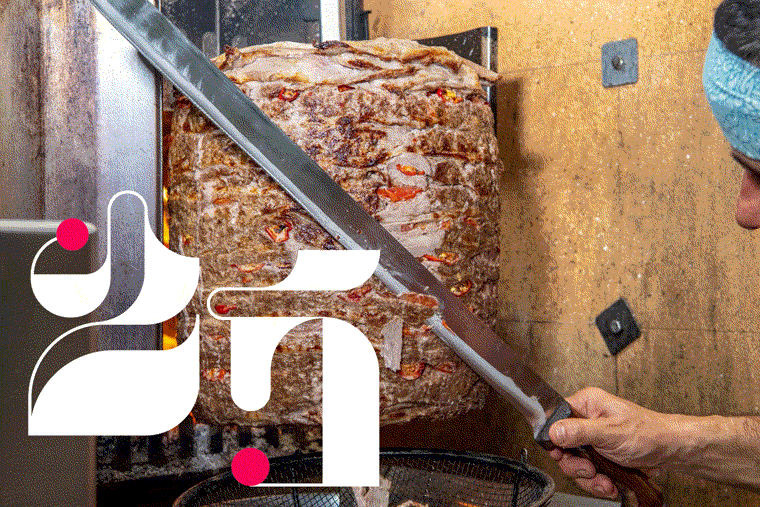
Saffy's
Ori Menashe and Genevieve Gergis’ third restaurant, in an Art Deco space across from the big blue Church of Scientology building in East Hollywood, follows their downtown successes with Bestia and Bavel. Given Saffy’s focus on kebabs and a dozen or so California-inflected small plates, it may have appeared that the couple was striving for something more casual. One can argue how “casual” may be best defined these days; I certainly wouldn’t label Saffy’s as inexpensive. And really, given the ambition on display, Menashe and Gergis don’t quite seem capable of a stripped-down, laid-back style of restaurateuring. It’s largely to our benefit. Check out their small daytime bakery next door for excellent ham and cheese biscuits.
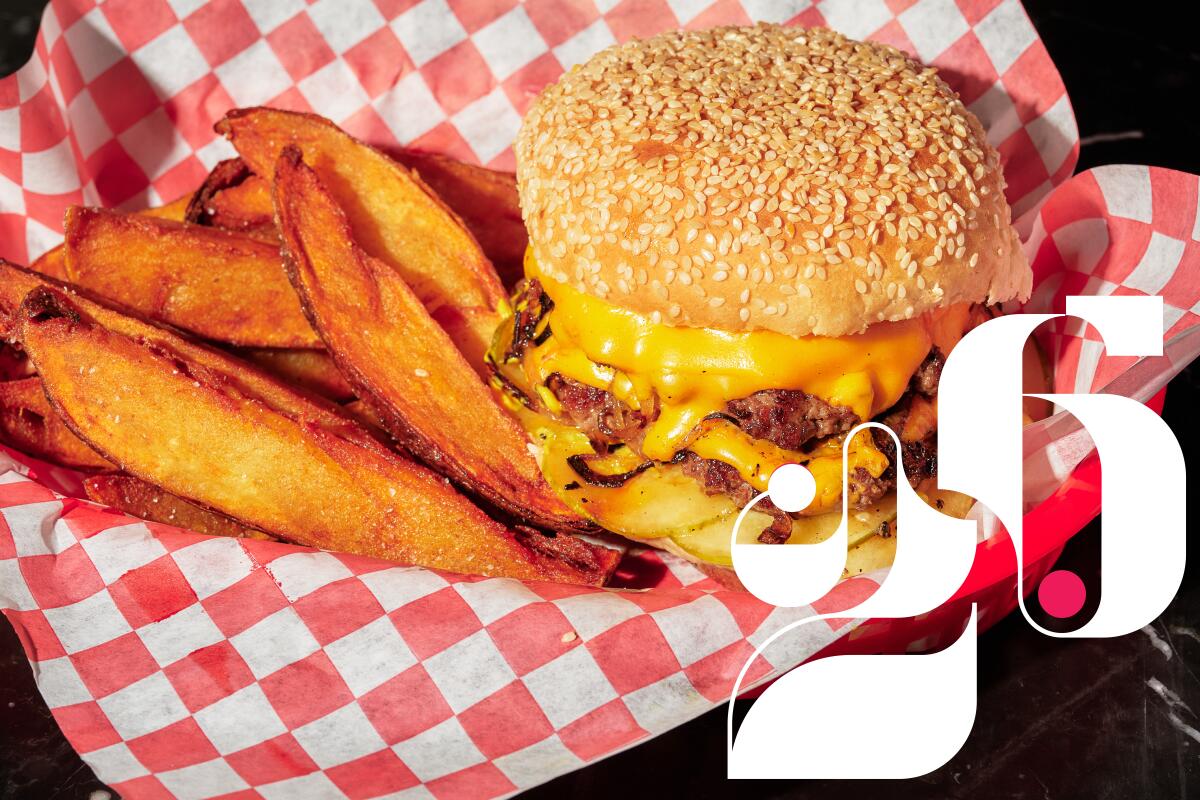
Chi Spacca
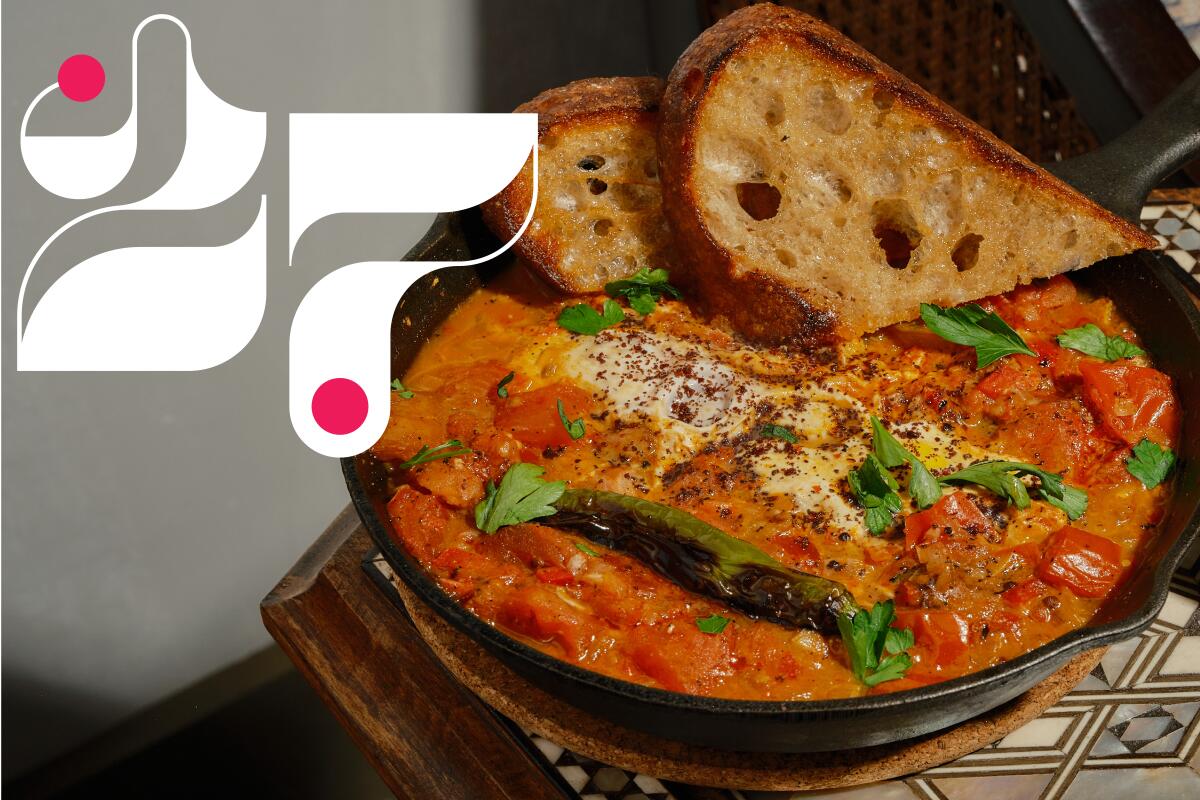
Ammatolí
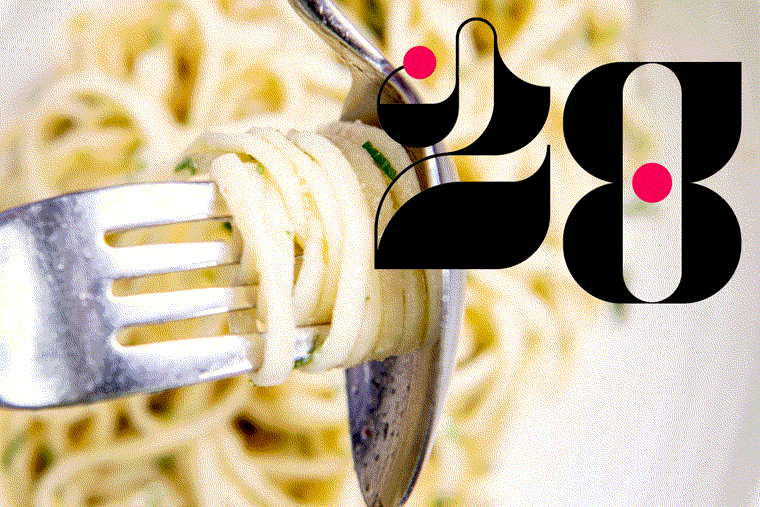
Felix Trattoria
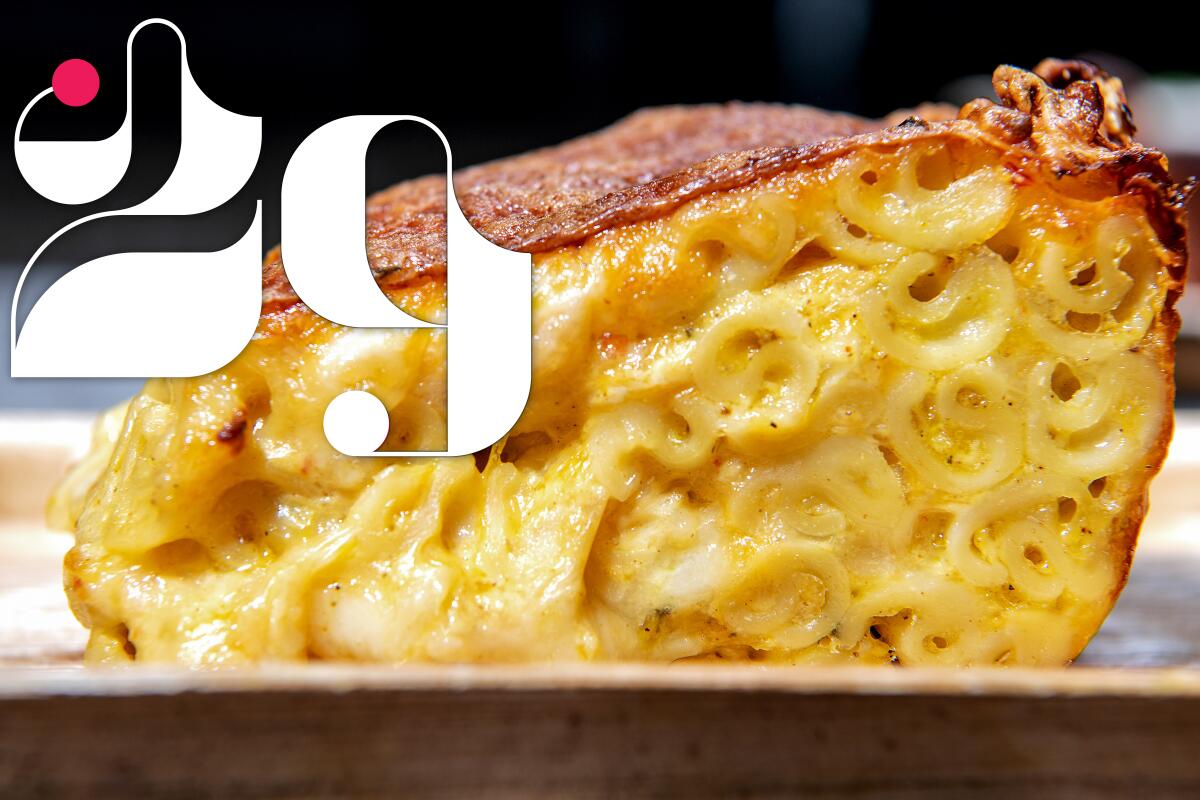
Bridgetown Roti
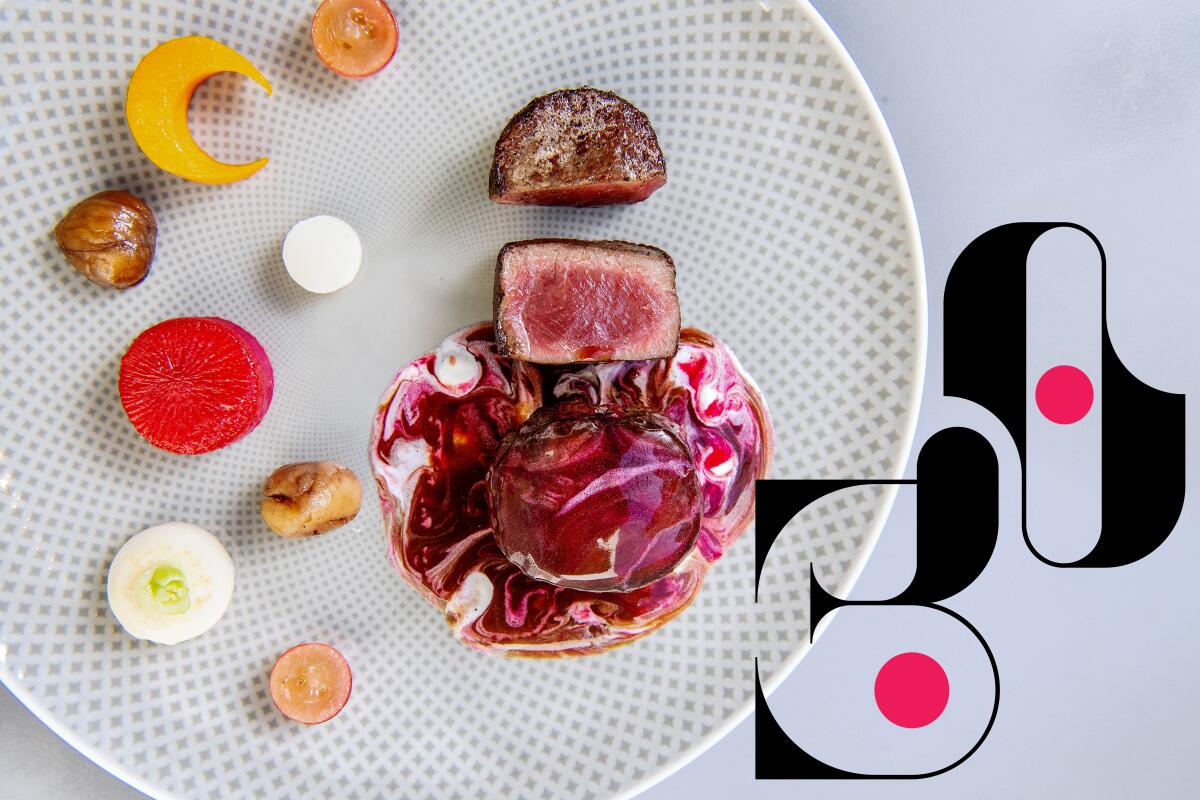
Knife Pleat
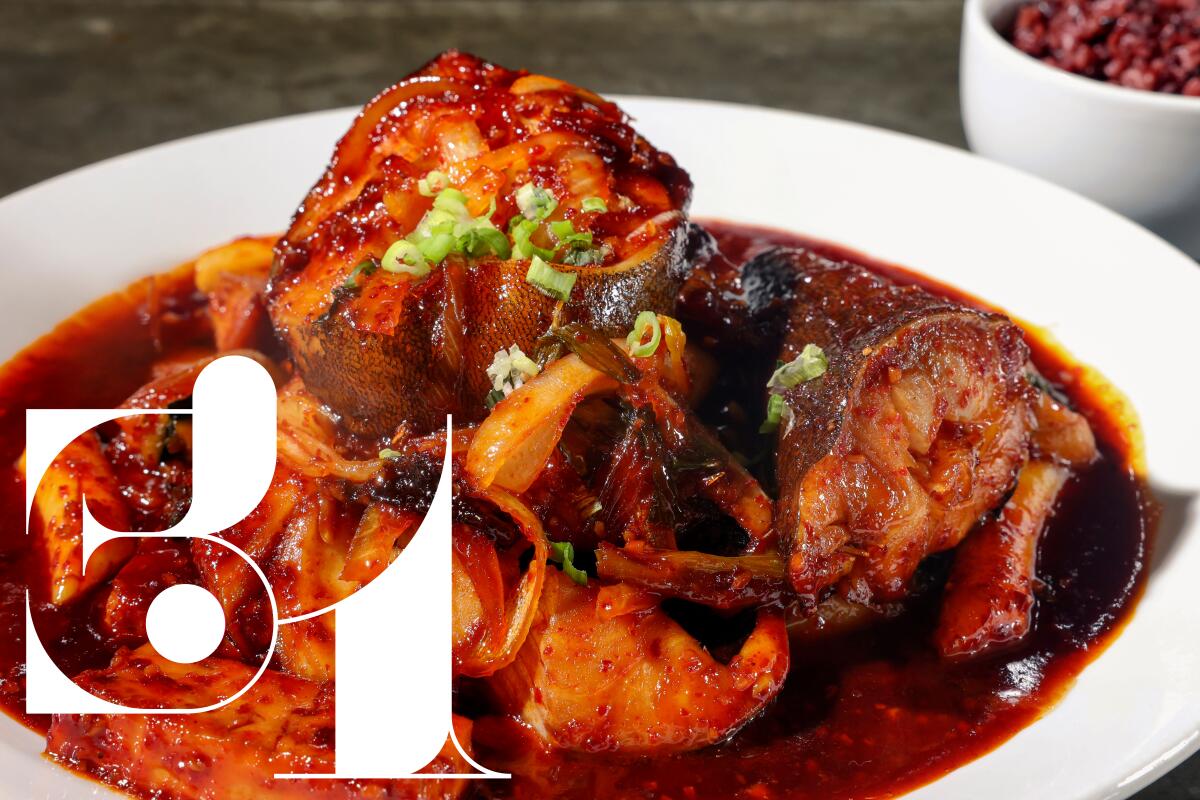
Soban
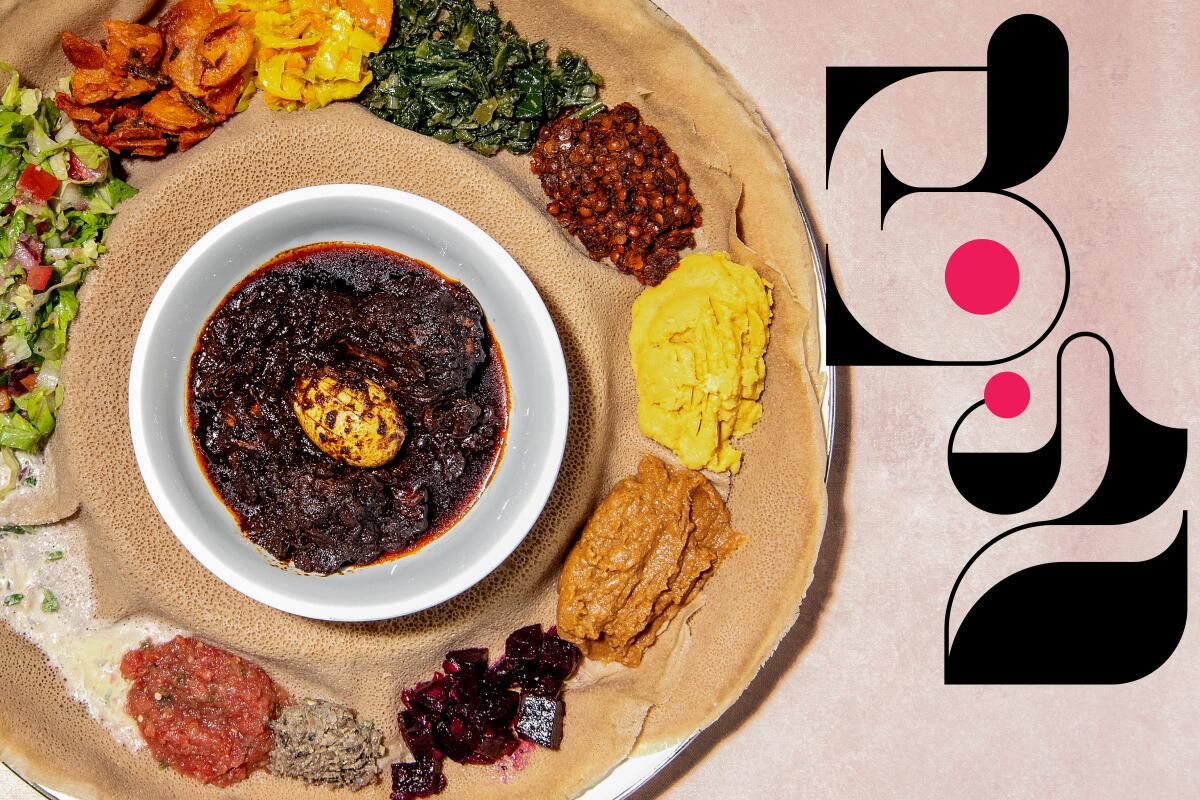
Meals by Genet

Bicyclette
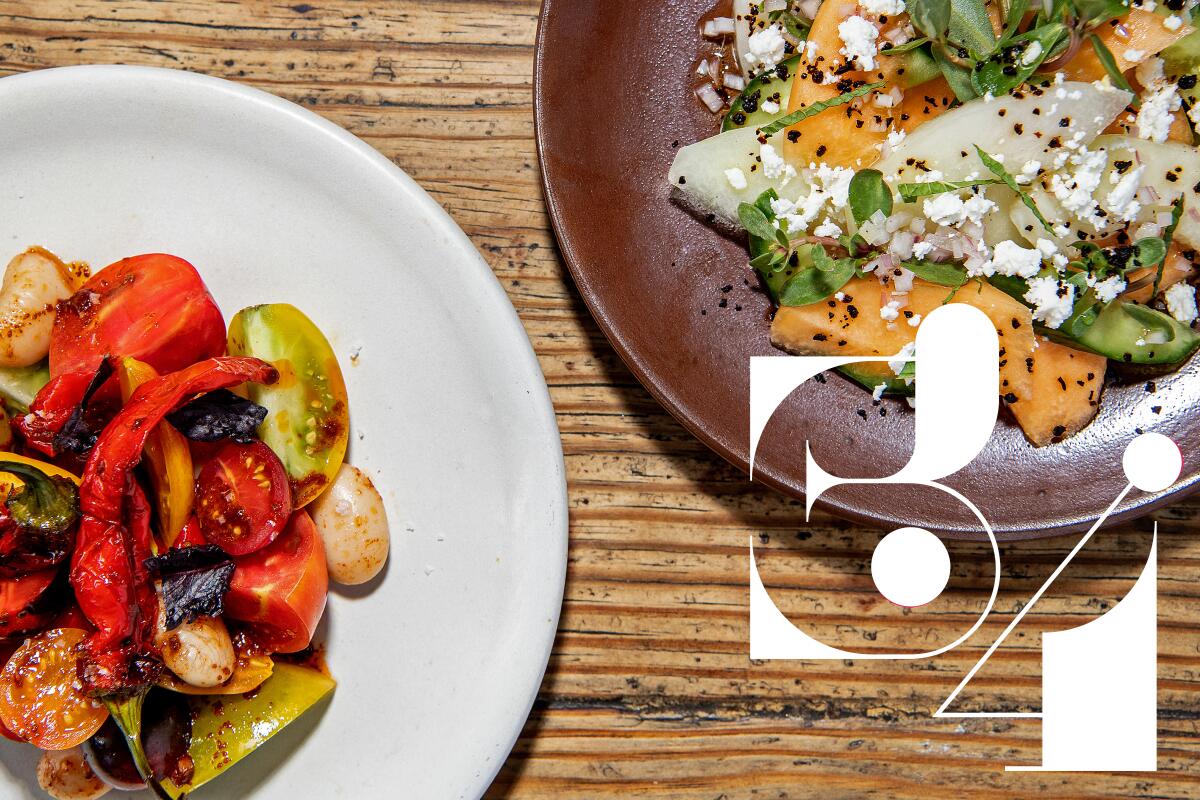
A.O.C.
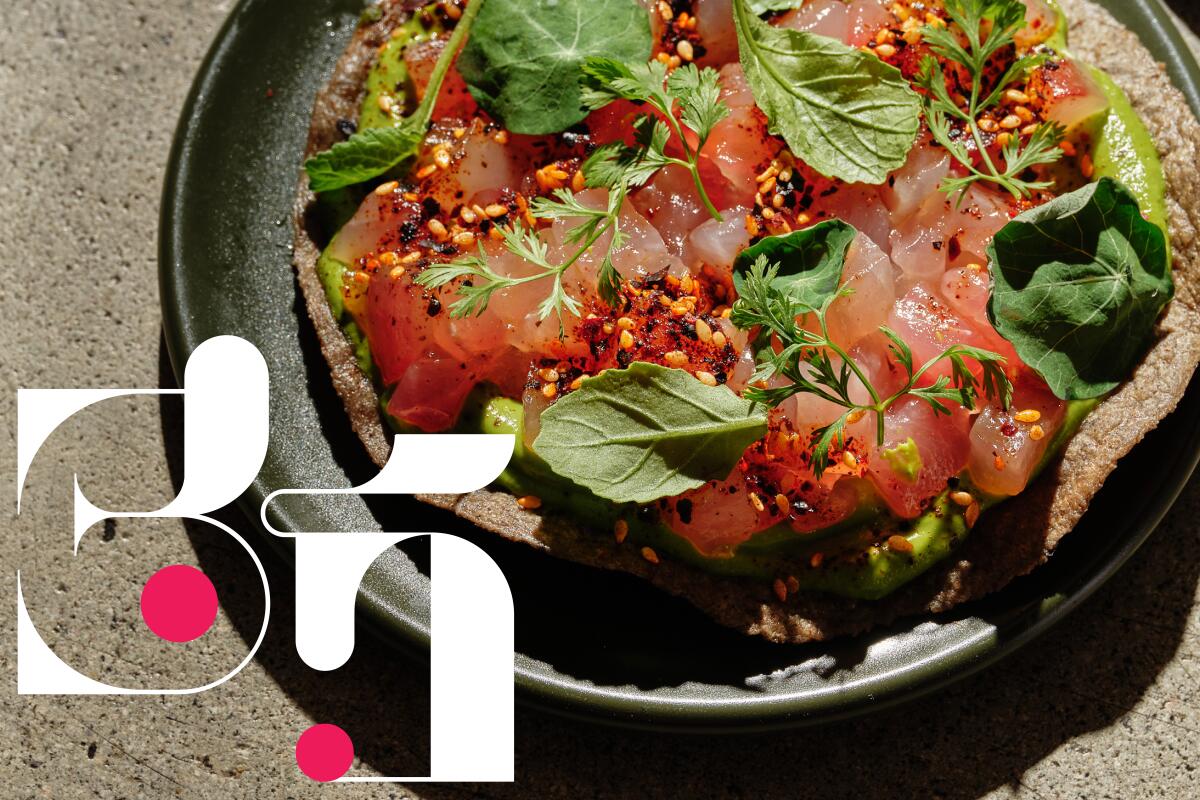
Damian
Housed in a former Arts District warehouse, the interior is mod and moody, though the terrace is especially stunning. Architect Alonso de Garay and designer Micaela de Bernardí have turned the area — amid industrial decay, offset with fresh planters built above winding banquettes — into something exhilarating: part art installation, part urban haven.
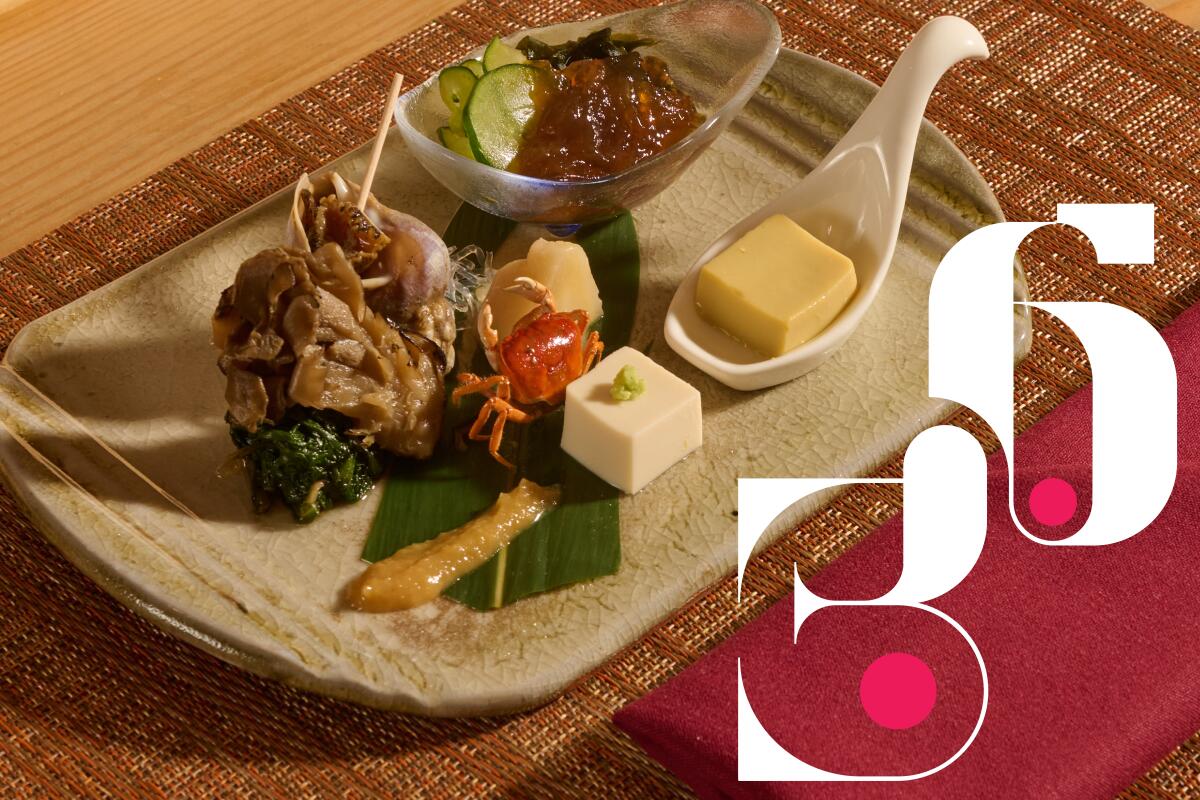
Shin Sushi
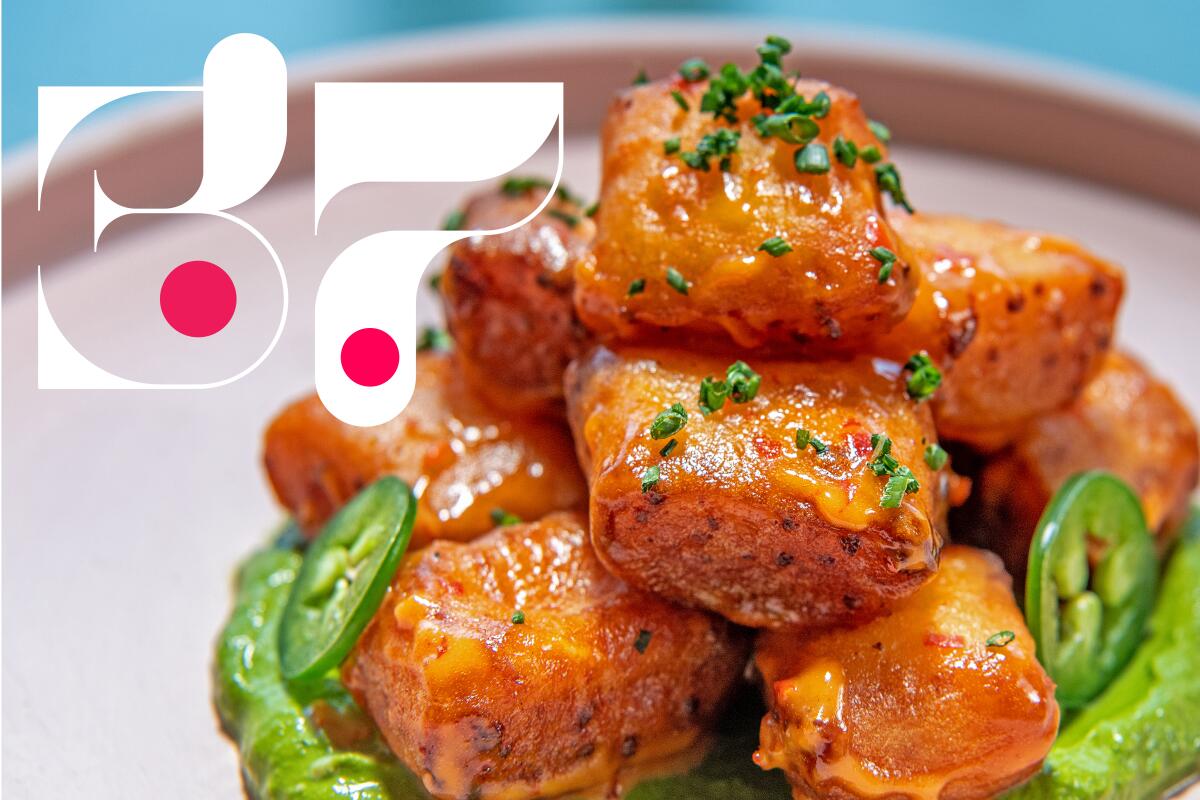
Causita
Causita — an airy room with two-story ceilings, exposed brick and light woods, with a beautifully tiled terrace out back — is part of a three-in-one Silver Lake project by David Rosoff, one of L.A.’s great wine savants, who launched a hospitality group last year. Start at Causita but keep in mind his two other side-by-side ventures at Sunset Triangle Plaza: Rápido, a tiny market great for bread and tinned seafood, and Bar Moruno, a restaurant themed loosely around Spanish bar food that’s fantastic for chef Chris Feldmeier’s tortilla española, martinis and whatever obscure red wine from the Canary Islands Rosoff is crushing on.
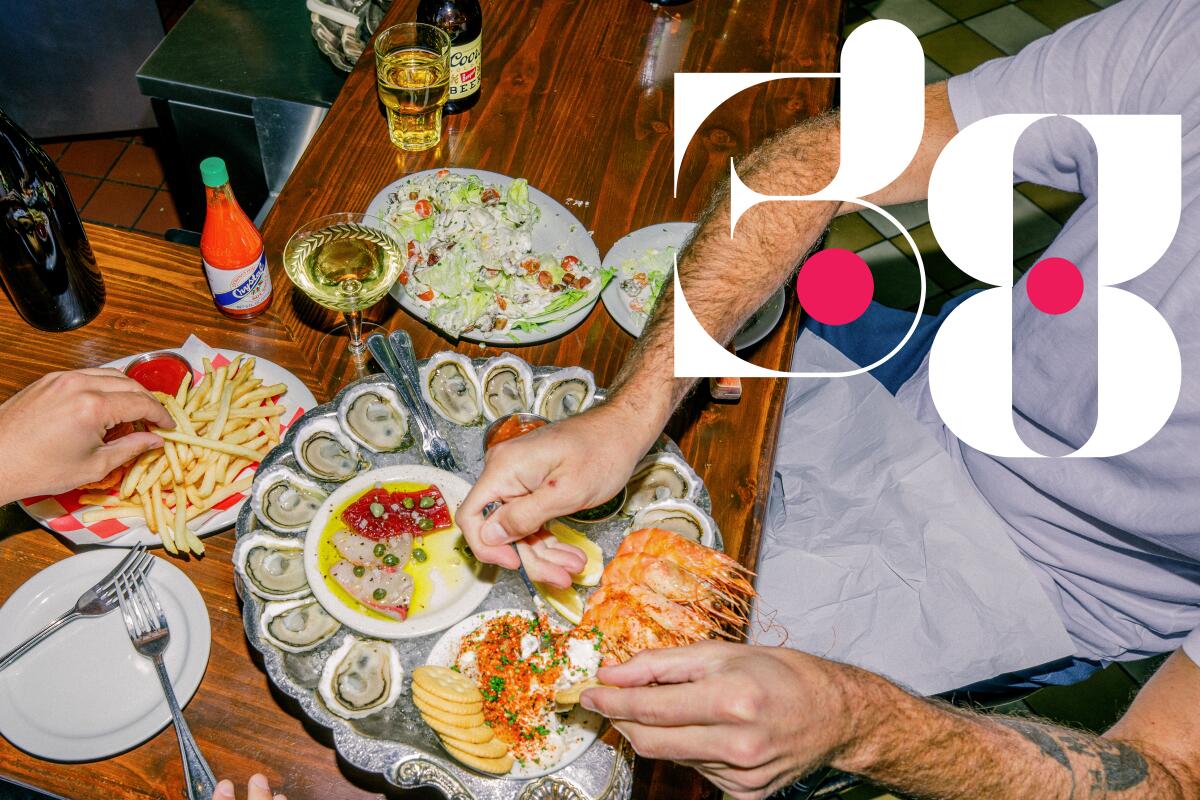
Found Oyster
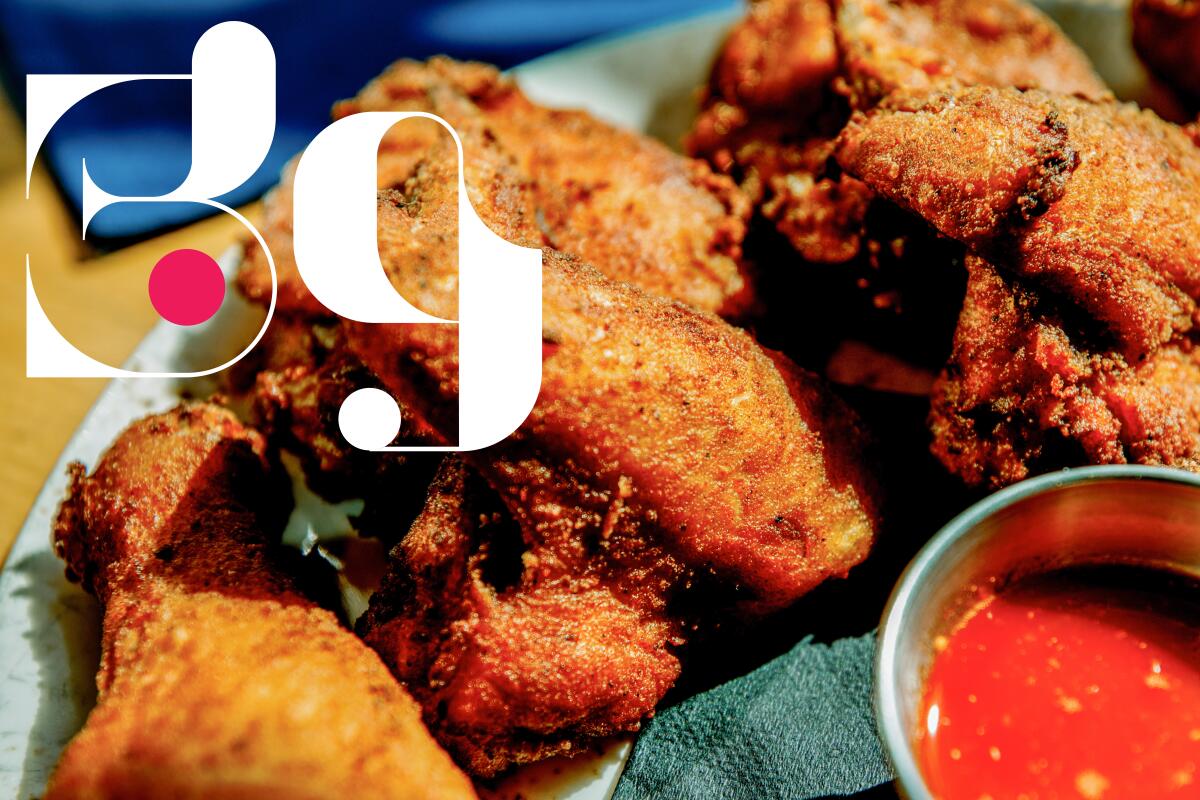
Alta Adams
“California Soul” is also the name of Corbin’s powerful memoir, published this year, about growing up in Watts, surviving the drug economy and finding his way in the kitchen. A highly recommended read.
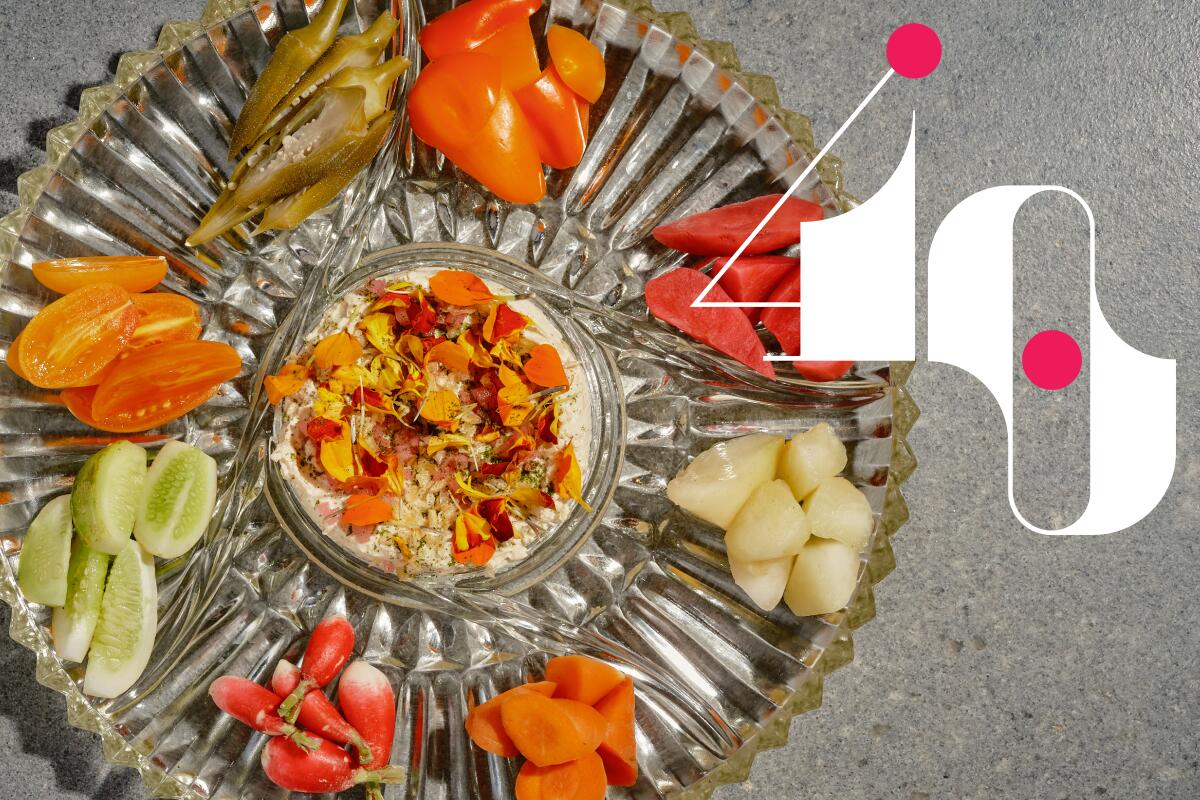
Birdie G’s
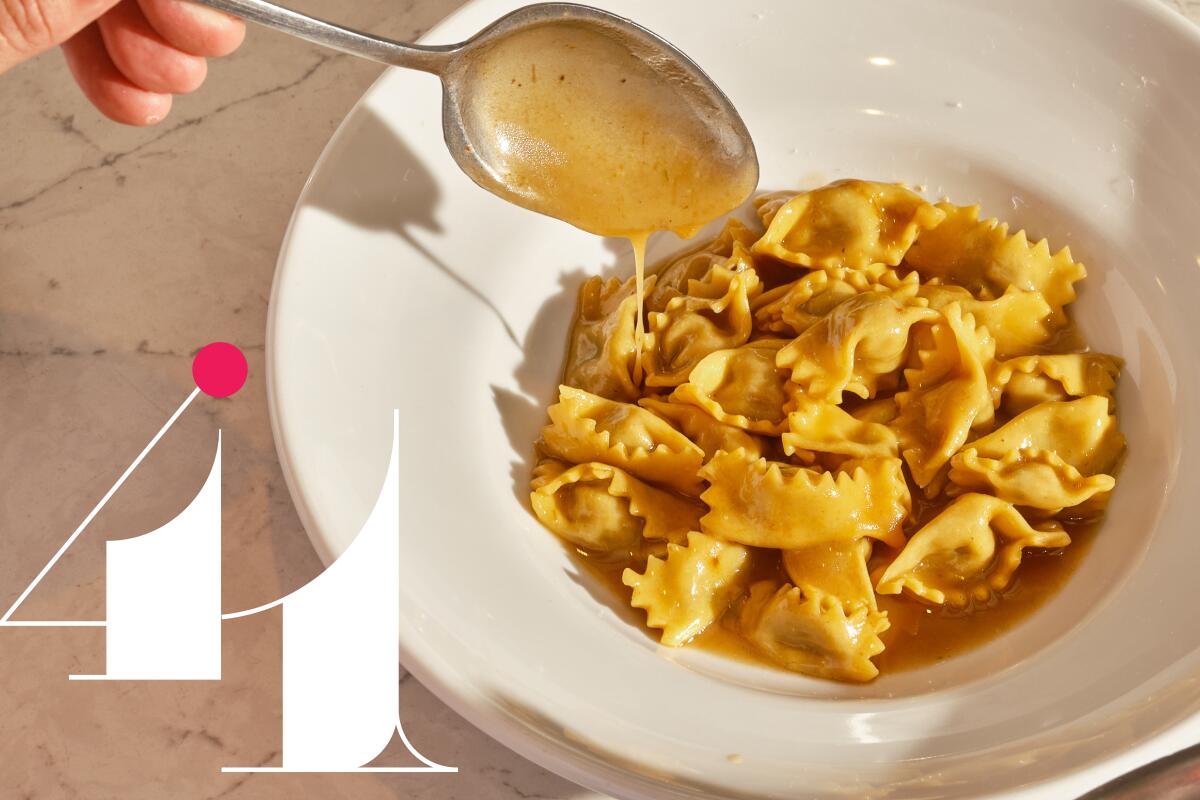
Antico Nuovo
The place is not inexpensive, and it resides in a nondescript strip mall on a stretch of Beverly Boulevard that doesn’t exactly stick in the brain. Point being: If you need to make last-minute reservations for a dinner that leans special occasion, this is an excellent option.
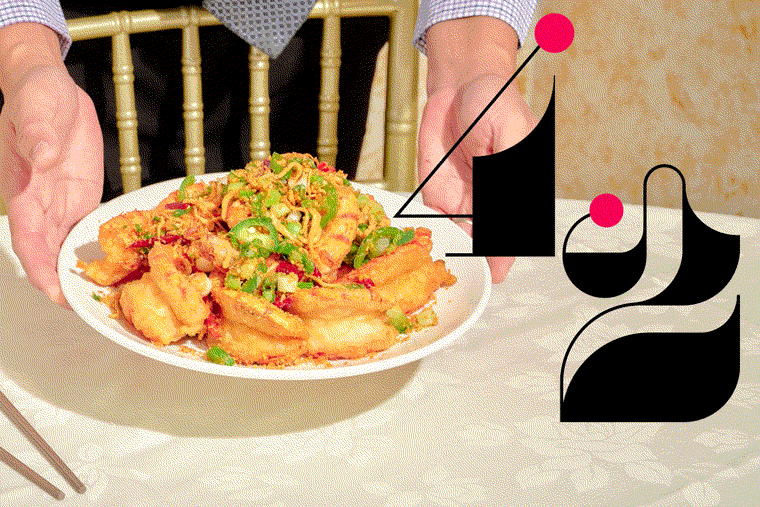
Henry's Cuisine
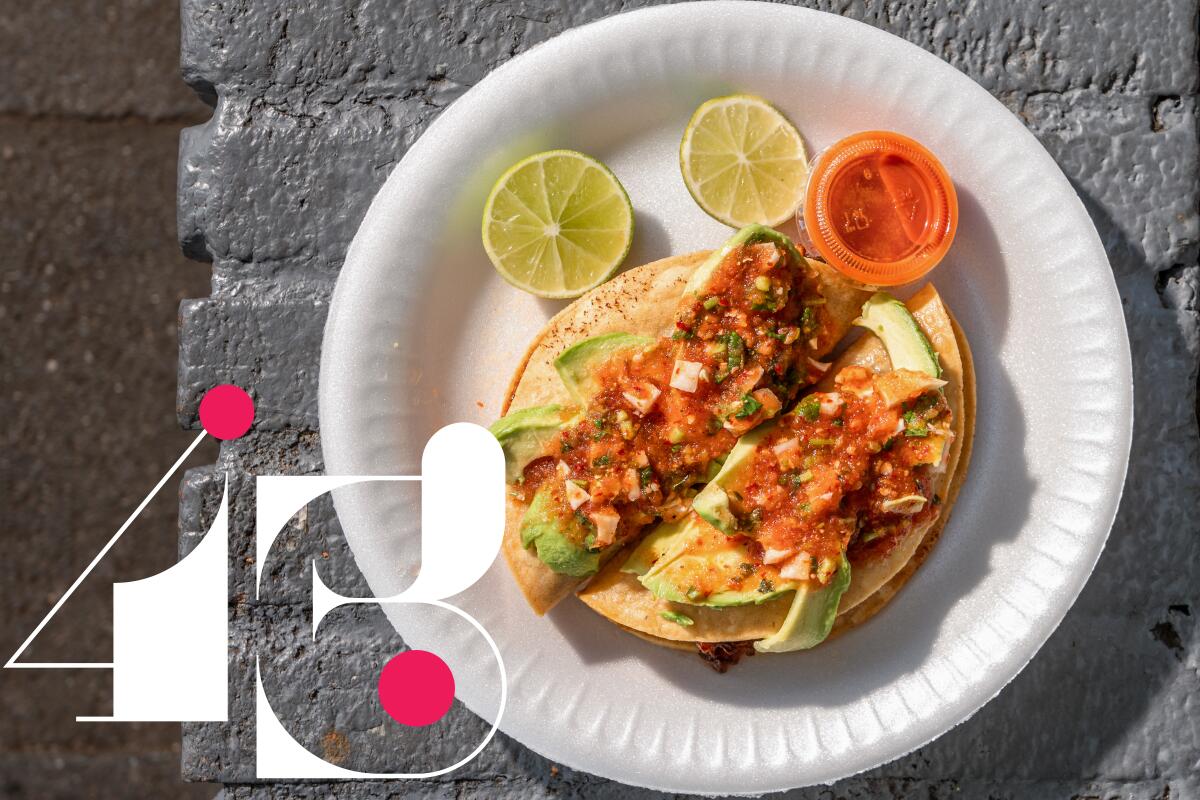
Mariscos Jalisco
I am one in a lineage of restaurant critics declaring Mariscos Jalisco to be a worthy first meal in Los Angeles if you want to understand the city’s culinary culture. I’m still amazed at how many people ask me for taco recommendations and have never heard of the place. Maybe this will help: Ortega operates three additional outposts, including a counter restaurant in Pomona, with the same menu, and a lonchera on the Westside. If none of them quite reaches the summits of the Boyle Heights truck, it still might be the most amazing seafood taco you’ve ever had.
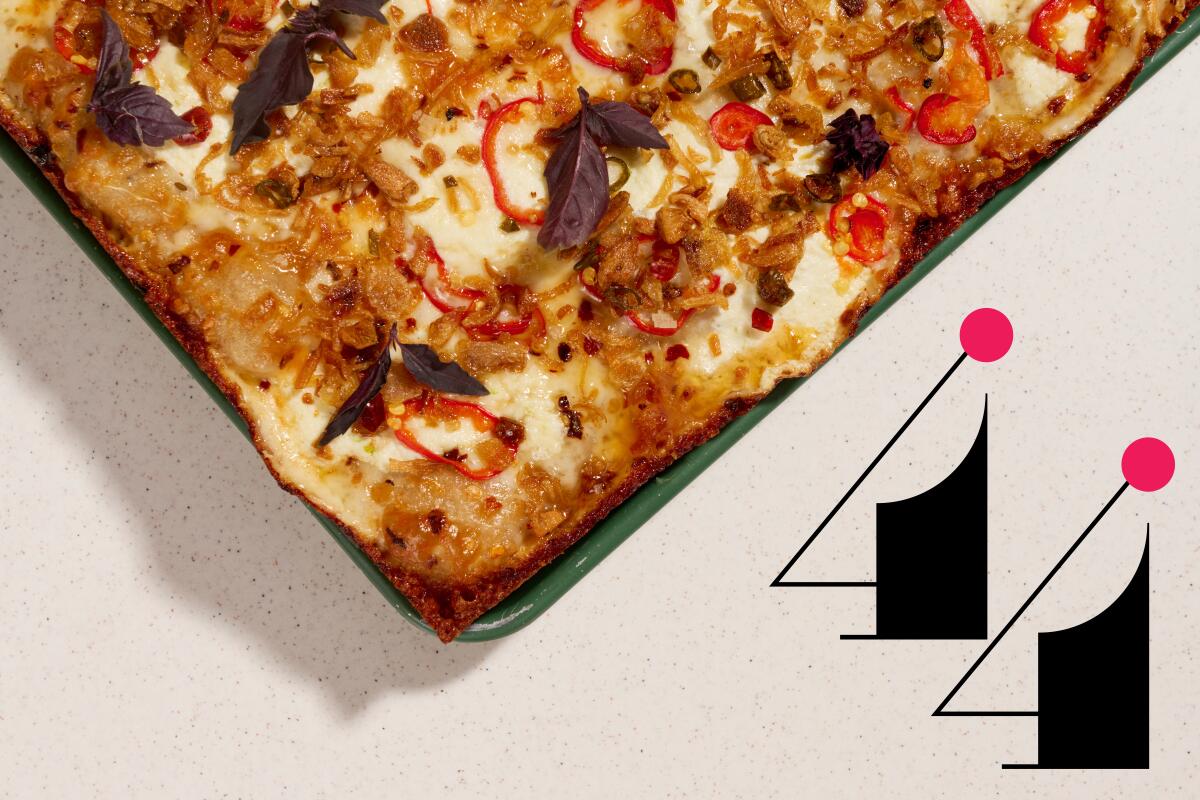
Quarter Sheets Pizza
Over the past year they slowly moved into a magnetically eccentric Echo Park space, selling takeout while building a pizza parlor that ended up looking like an early-’80s rec room, complete with both record and cassette players. Their respective specialties are now even better, and also more unpredictable in their imaginings. Maybe potatoes, pistachio pesto and cured lemon will crown a pie, or perhaps there will be a meatball sub reimagined as a pizza, or sambal goreng tingling under a veil of mozzarella. Ziskin dreams up fantasies like olive oil chiffon with tiers of bay leaf-vanilla custard, passion fruit curd and salted Chantilly. Lately there’s been an incredible butter bean salad dotted with feta. No one can guess what L.A.’s first couple of carbs will devise next, but I feel pulled to show up every week and find out.
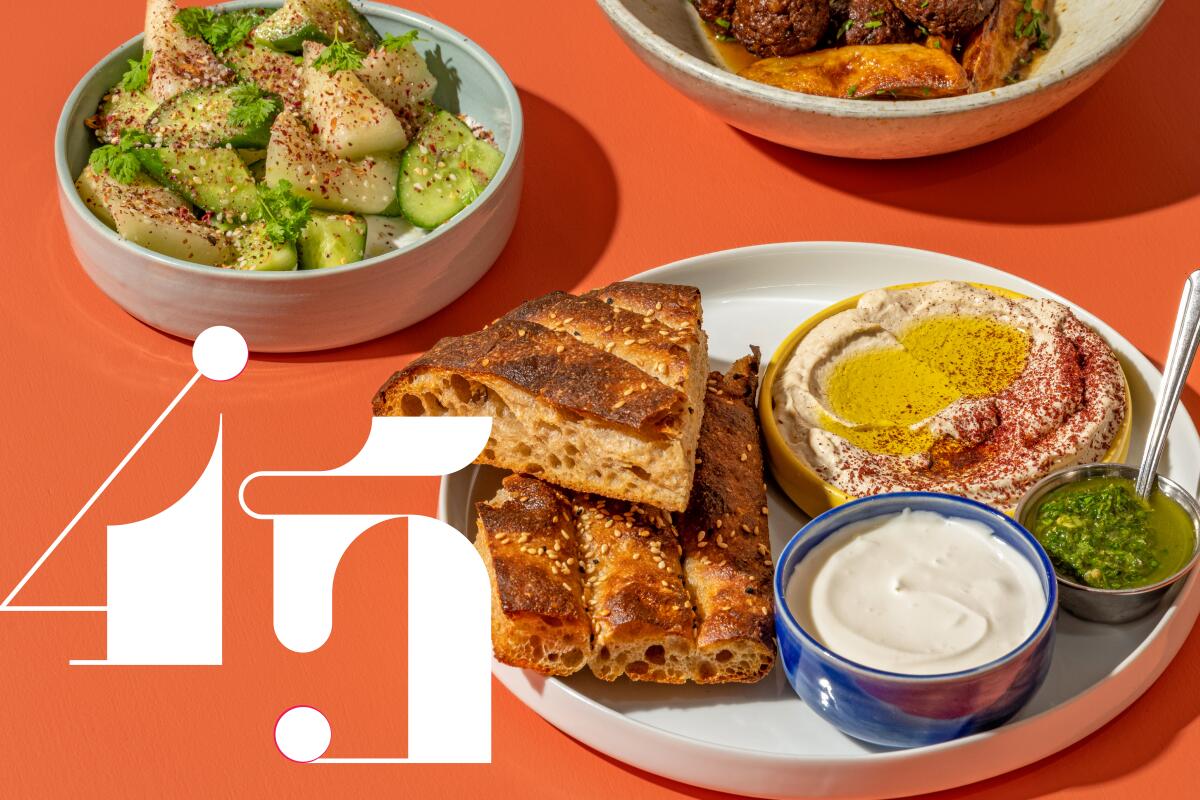
Kismet
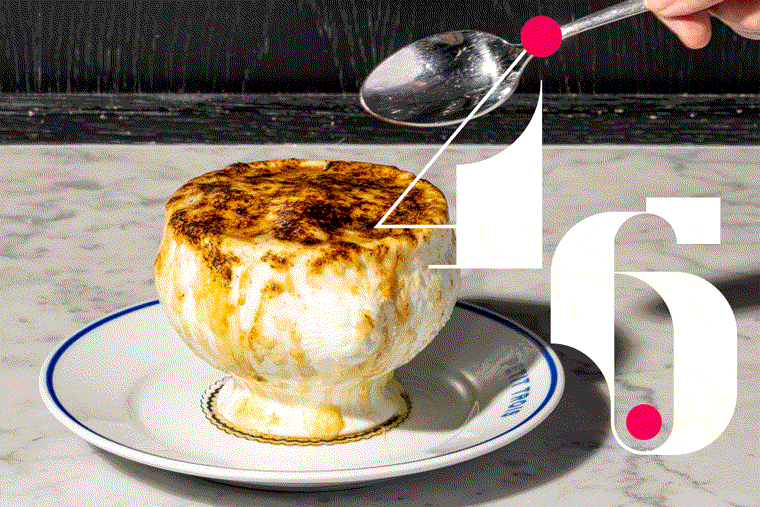
Petit Trois
These days most of us eat on a patio set up in the restaurant’s parking lot. The cooking retains its spirit, though its notions of bar food give way more each year to a conventional restaurant menu. In late summer a magenta slab of duck breast shared its plate with a ripe quarter-moon of peach and a lopsided square of bloomy-rind cheese teetering between solid and liquid. The same entree was served at the restaurant’s larger, brassier Sherman Oaks outpost, and it was a perfect trio. Something about the combination’s indulgent genius made me miss Trois Mec, the closed tasting-menu restaurant in the same strip mall as the original Petit Trois that once rewired ideas about fine dining in America. I still hold out hope for its revival. In the meantime, I’m here for Petit Trois’ evolving synthesis of Lefebvre’s styles.
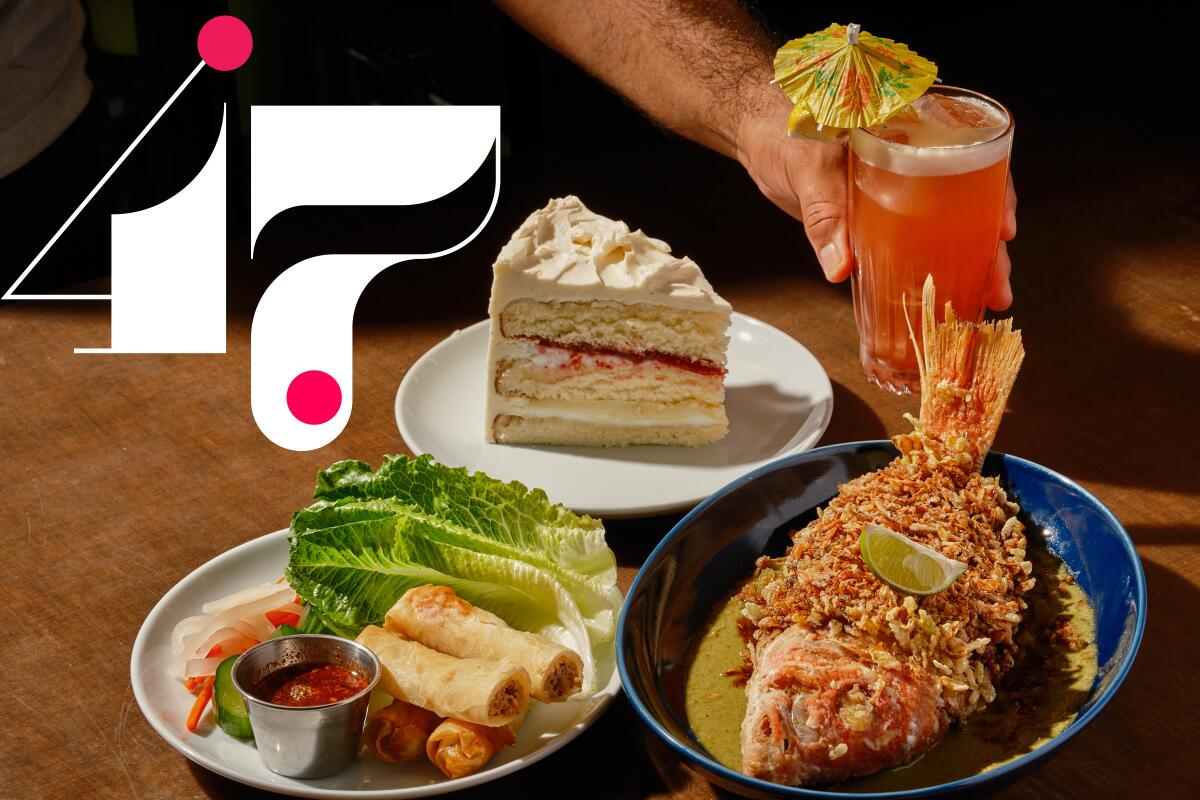
All Day Baby
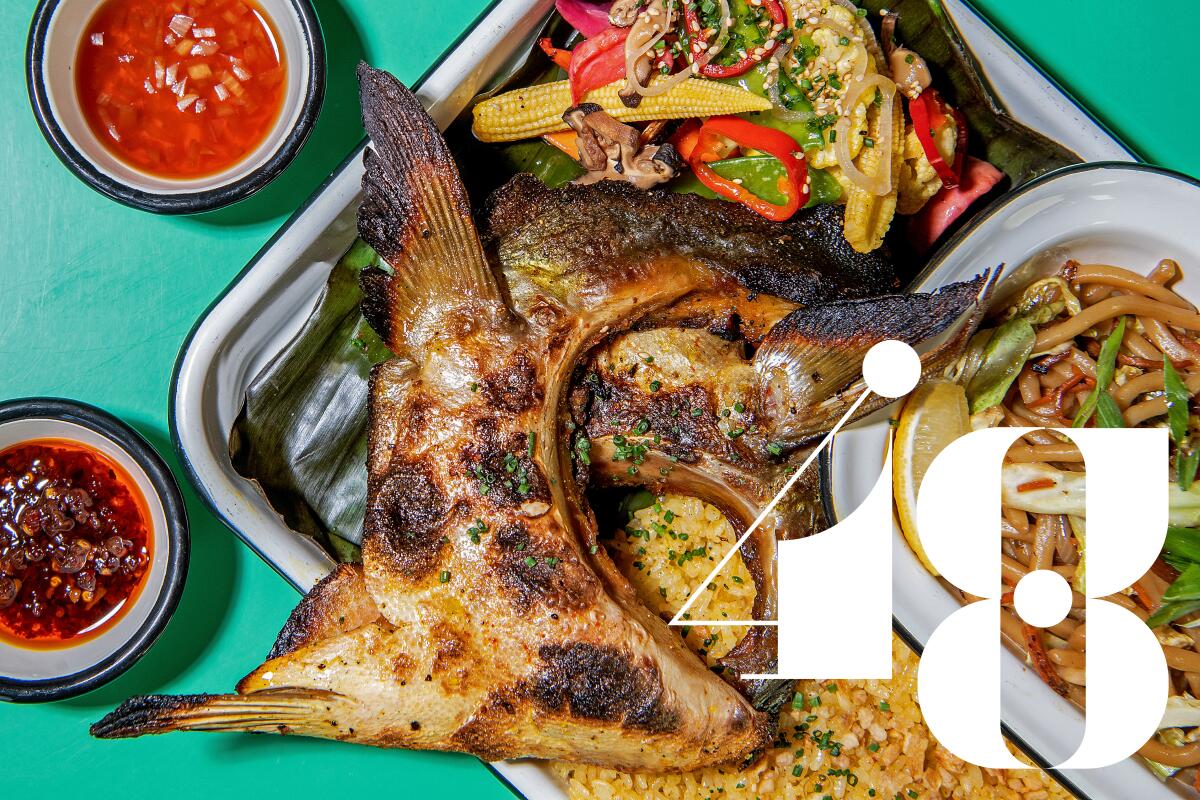
Kuya Lord
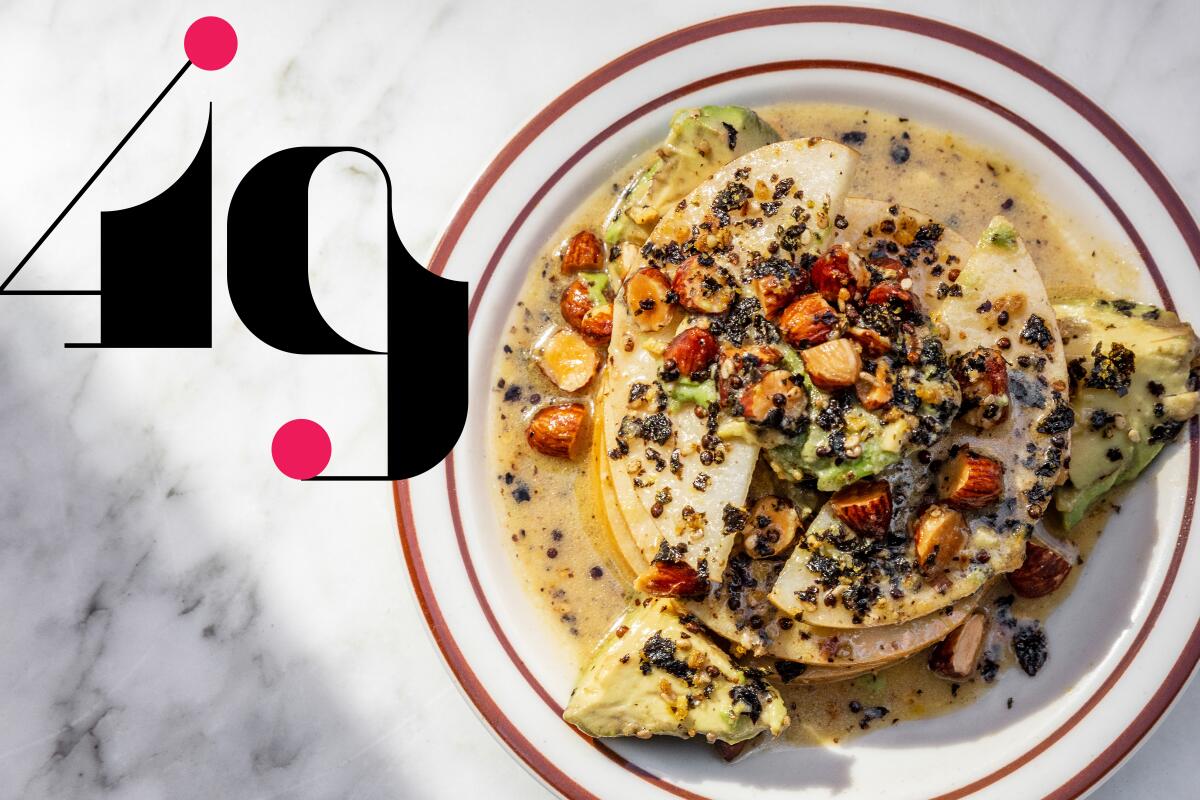
Yangban Society
The flow of Yangban Society’s tiered Arts District space has been a work in progress. Should the restaurant and its separate upstairs market area that the Hongs call the “Super” — where customers purchase beverages separately and maybe shop for Korean snacks — eventually merge into an easier-to-navigate experience? Probably. Most significantly, the food is immediately accomplished and, in its freshness and individualism, beautifully of Los Angeles.
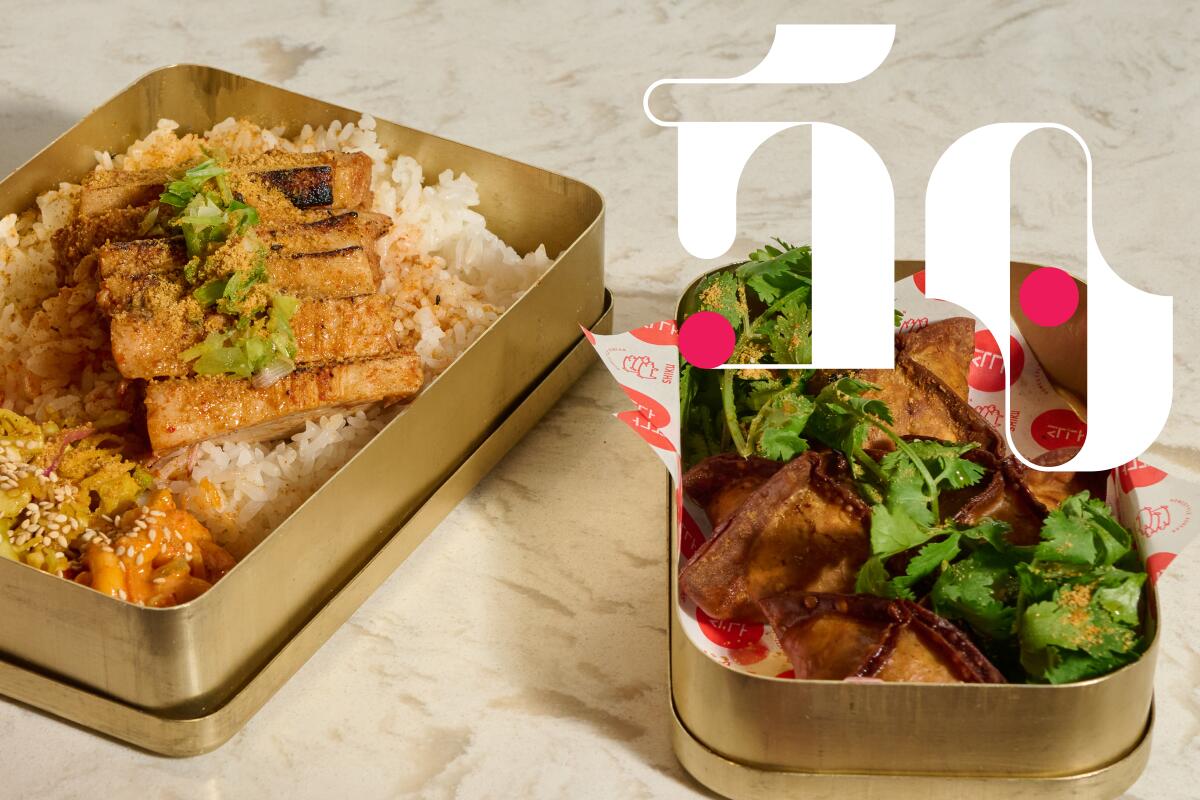
Grand Central Market
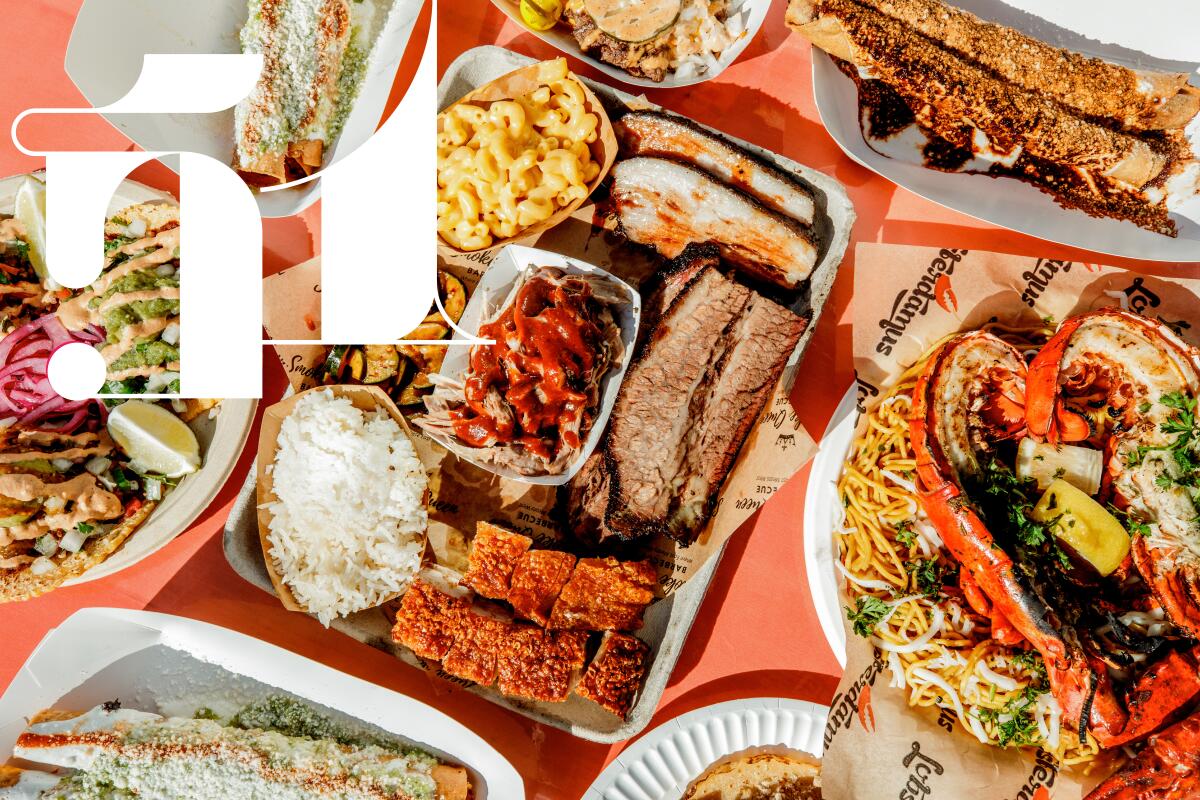
Smorgasburg L.A.
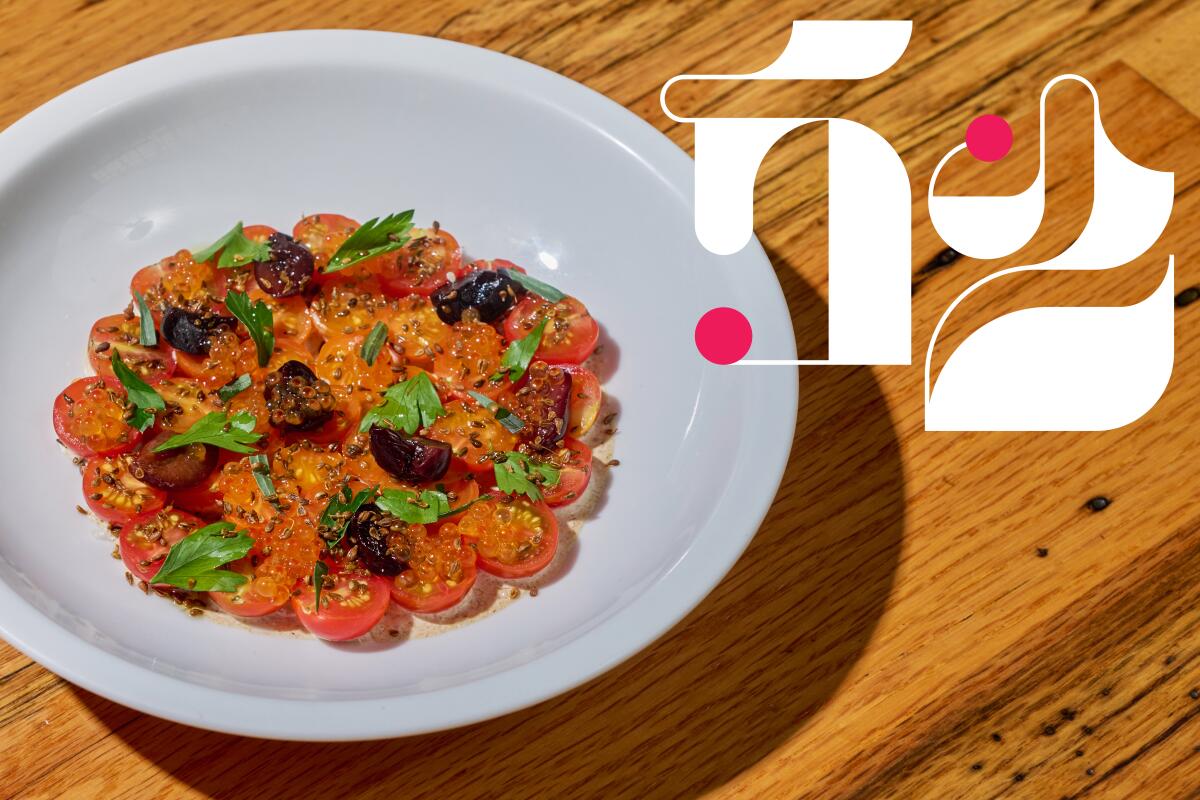
Bestia

Konbi
Back in Echo Park, Akuto and Montgomery relaunched indoor dining at year’s end, renaming the restaurant Konbi Ni. They’re serving breakfast, lunch and dinner at the eight-seat counter; based on a recent Japanese-style preset morning meal involving fish, jeweled fruit and vegetables in various forms, I’m wondering if reservations are about to be as in demand here as for our top-flight sushi bars.
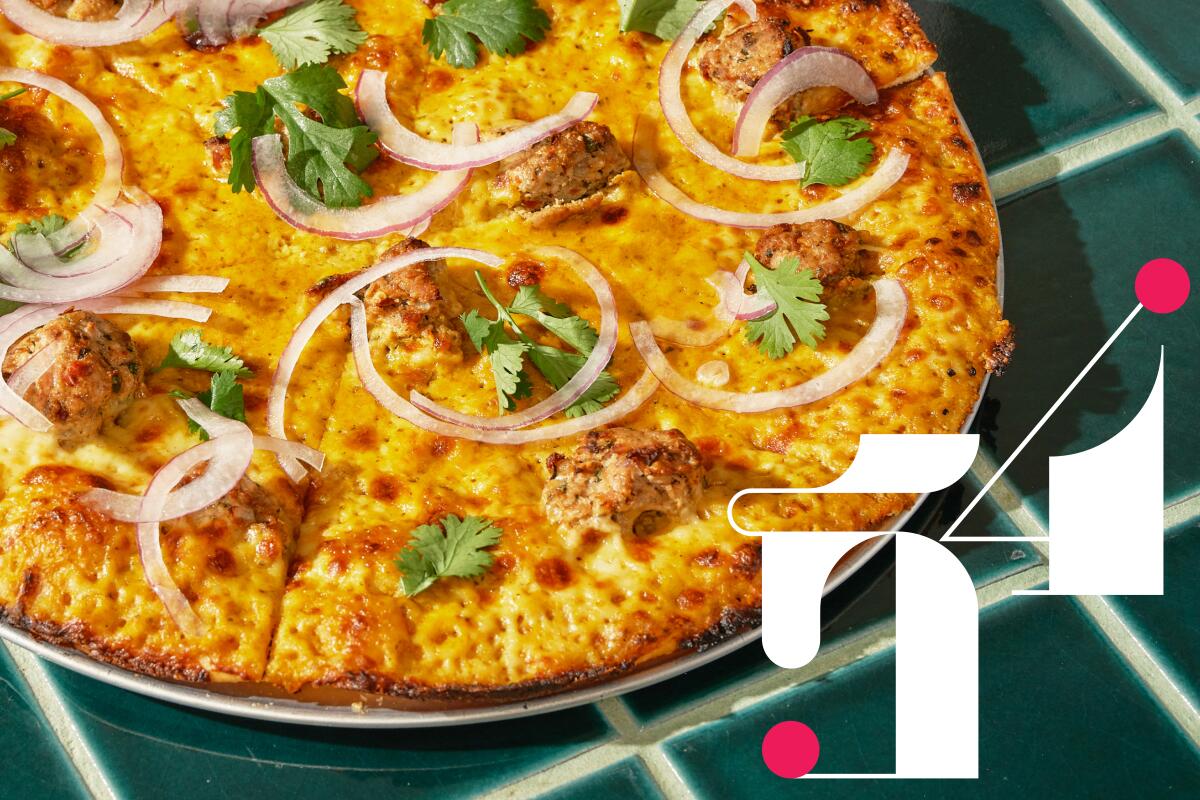
Pijja Palace
In a room that gives off the air of a business-class lounge in a Scandinavian airport, surrounded by 13 screens playing whatever game happens to be on that night, you might start with the “green” wings dressed in a cilantro-mint-chive chutney. The early hit is malai rigatoni, its sauce a gentle mixture of cream and tomato masala carrying the reedy twang of coriander seed. Naran and executive chef Miles Shorey do their best to eschew labels, but I’d couch their pies in the vein of East Coast-style bar or tavern pizzas — thin, chewy-crisp crusts with plenty of sauce and cheese all the way to their blackened edges. Don’t go too crazy with the build-your-own combinations: A relatively mild vindaloo sauce topped with chicken tikka and tandoori onions is plenty.
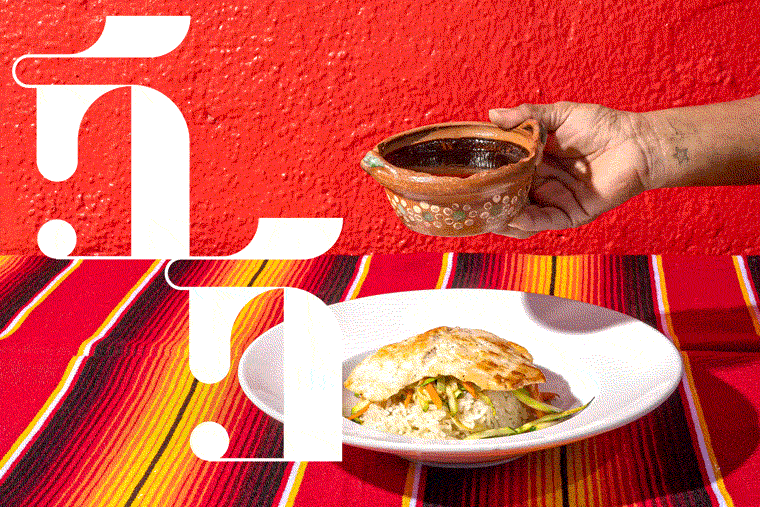
Rocio's Mexican Kitchen
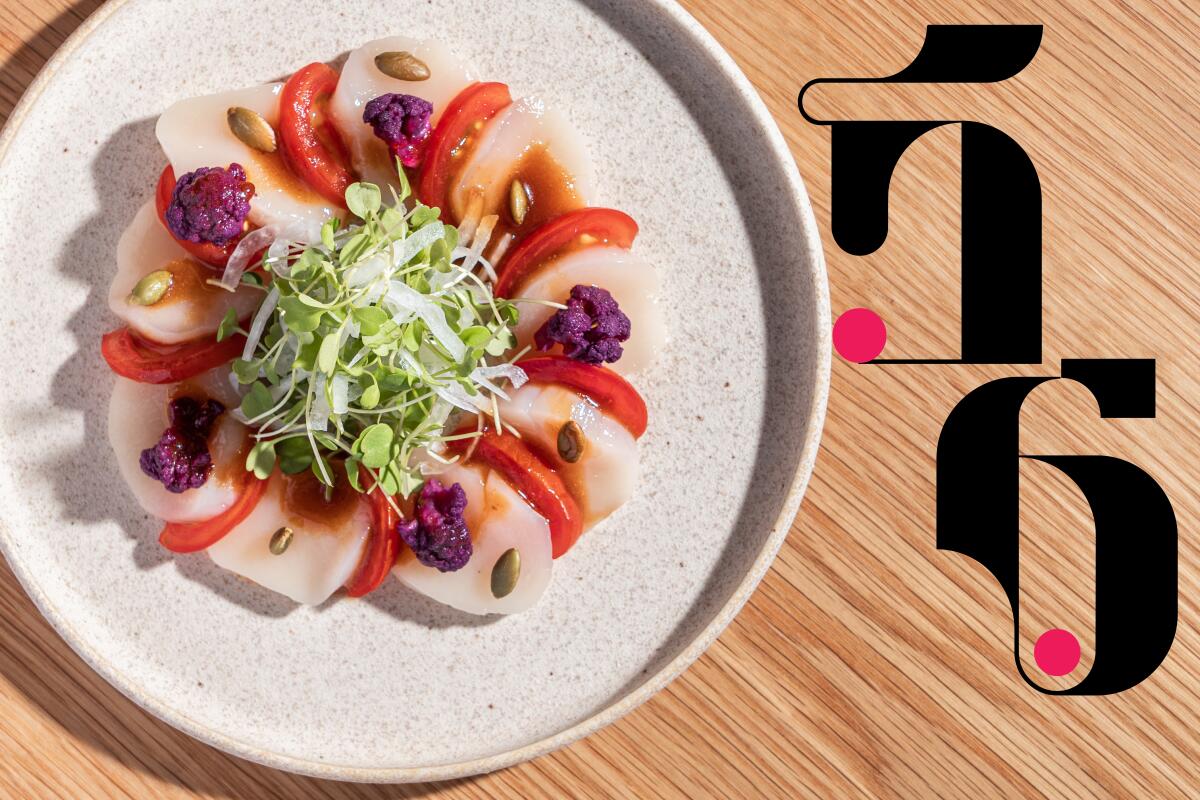
n/soto
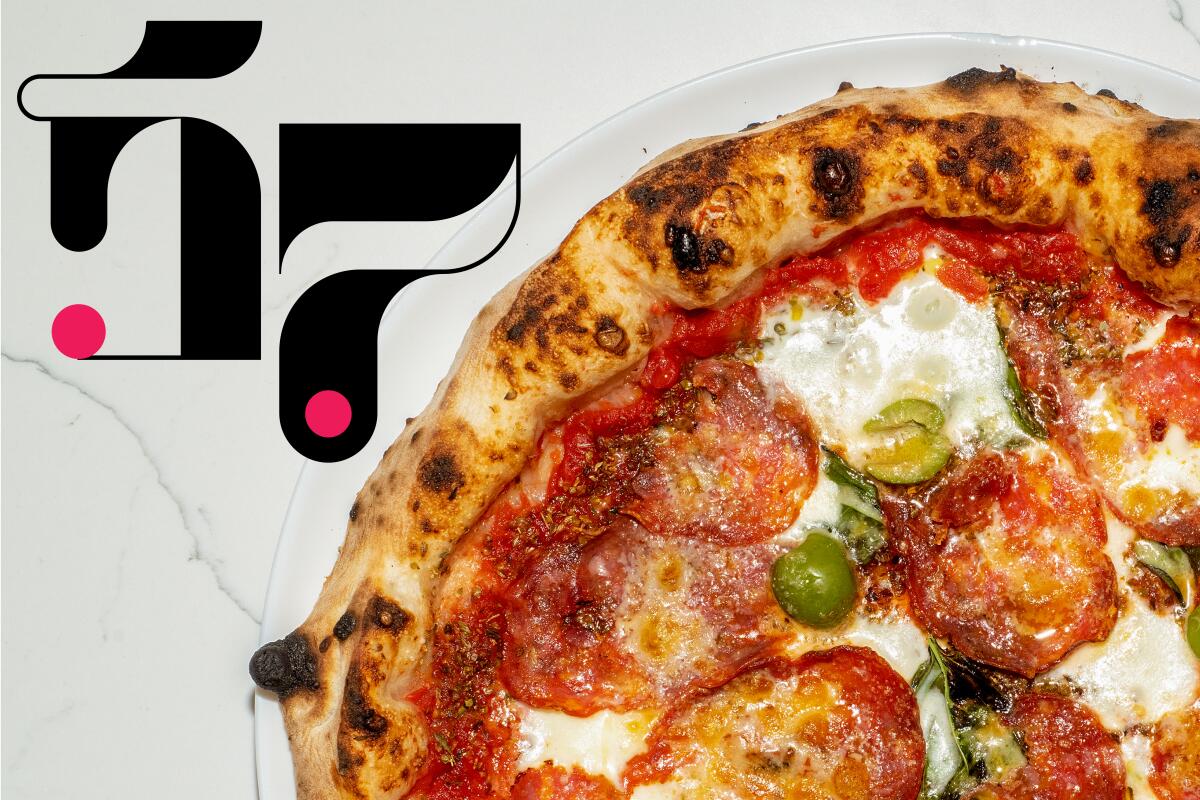
Pizzeria Sei
Reserve as far ahead as you can and expect prime slots to be booked; I’ve made peace with savoring Joo’s handiwork in the middle of the afternoon.
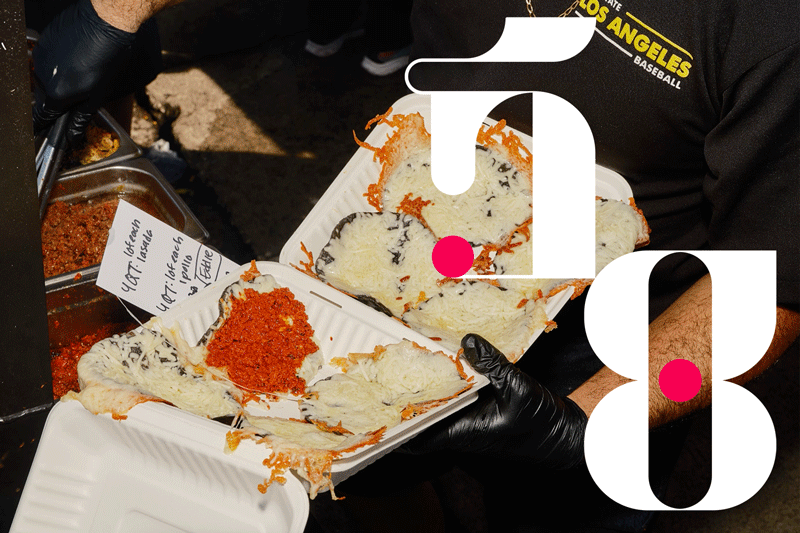
Villa's Tacos
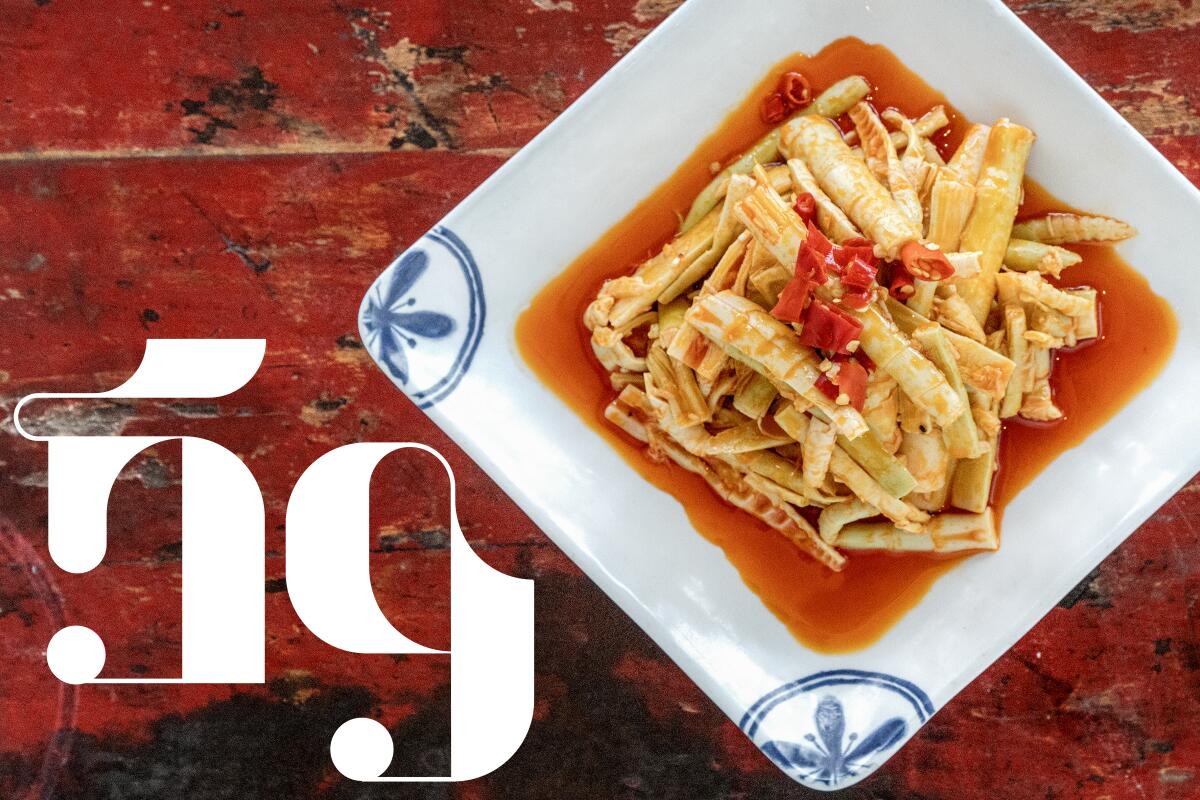
Sichuan Impression
Lynn Liu and Kelly Xiao, both natives of Chengdu, the capital of Sichuan province, opened their first restaurant in Alhambra in 2014. Start with a round of cold dishes — including pickled cucumbers, bamboo shoots and the famous fuqi feipian, or “couple’s dish,” with sliced beef shank and tripe in a broth prominently scented with ginger and star anise — followed by the boiled fish with rattan pepper, which is at once subtle and potent, and the wobbling hill of pork steamed with rice flour and pumpkin.
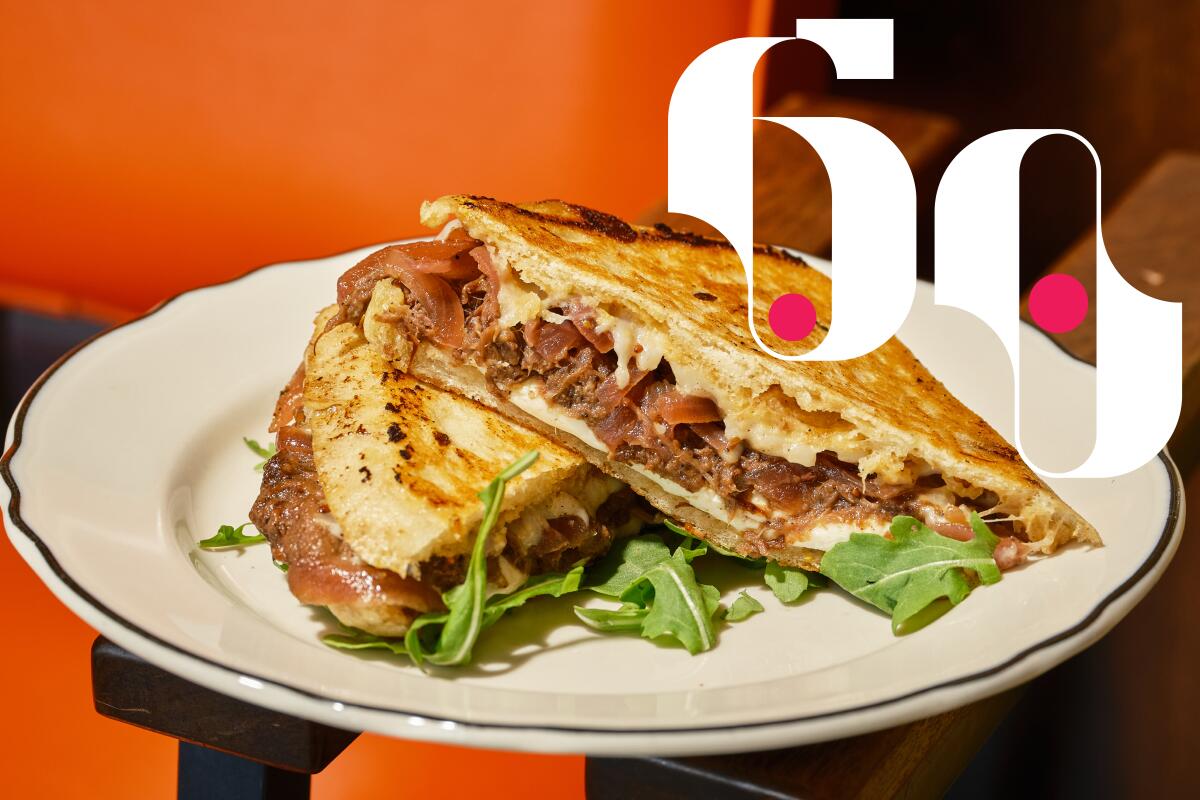
Post & Beam
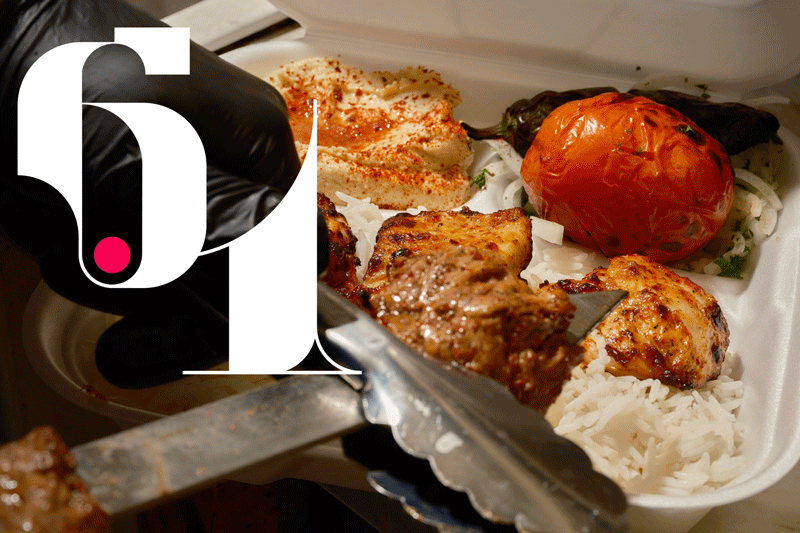
Mini Kabob
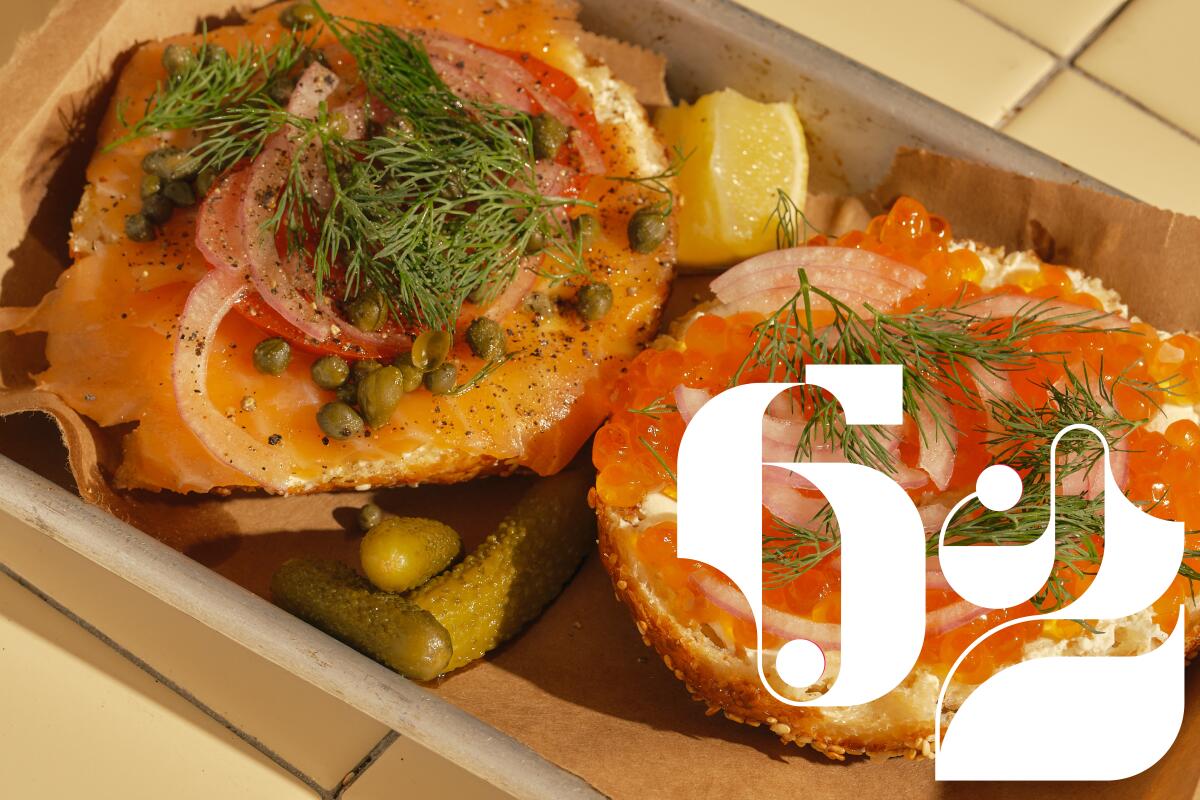
Courage Bagels
Arielle Skye began selling her compact, smoky-crisp, Montreal-inspired bagels from the back of a bicycle nearly six years ago. She expanded to the Silver Lake farmers market, and then in October 2020 she and her now-husband, Chris Moss, moved into the Virgil Village space previously occupied by Super Pan bakery. So Courage Bagels isn’t an overnight success story, but it has blossomed into an undeniable phenomenon. They really are worth the wait, no matter when you show up.
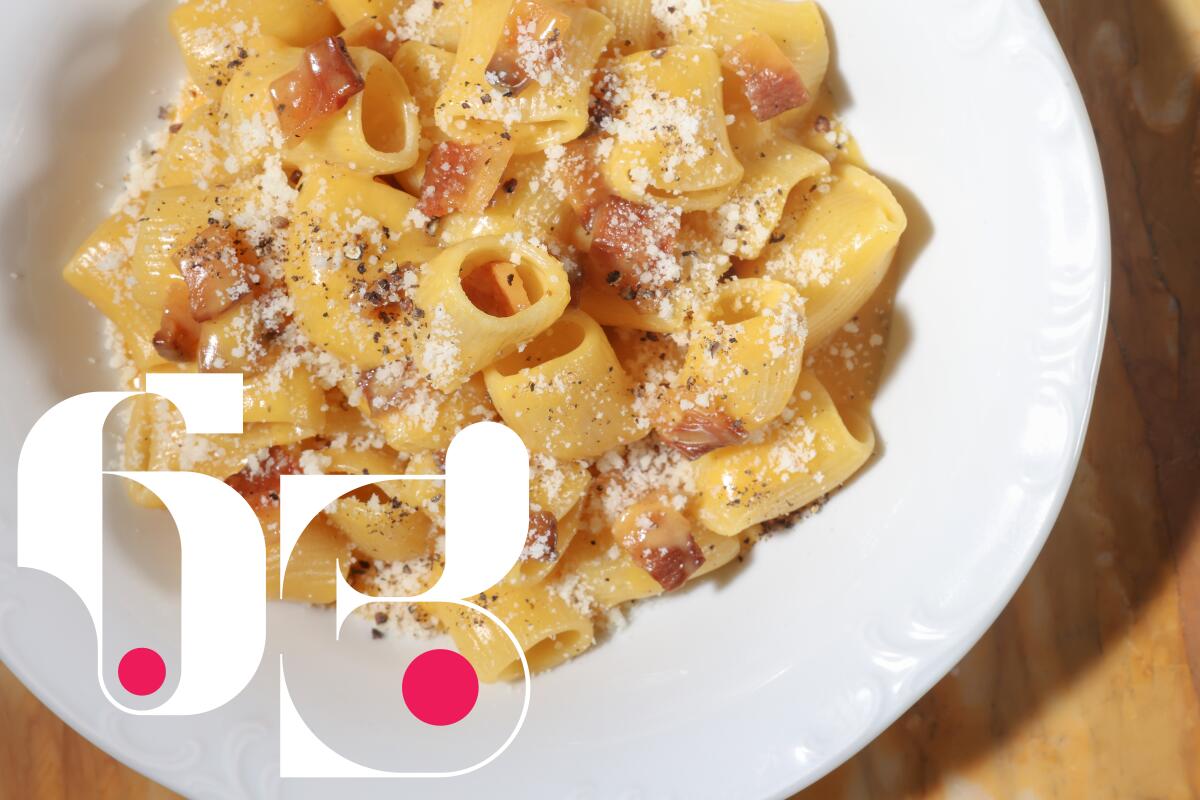
Mother Wolf
I find rewarding answers in his fried squash blossoms; the supplì al telefono stretchy with buffalo mozzarella; a pizza covered with prosciutto and artichokes; and a correct, barnyard-y spaghettone alla gricia, the unjust underdog of the Roman pasta repertoire. A restaurant of such glamorous scale needs a strong third act, and Funke wisely hired Shannon Swindle, one of L.A.’s most gifted pastry pros. Among other seasonal desserts, order the maritozzo, a fluffy sweet bun filled with cream in a shape that resembles Pac-Man with his mouth full, hiding a surprise of ripe, macerated strawberries that lightens the whole affair.
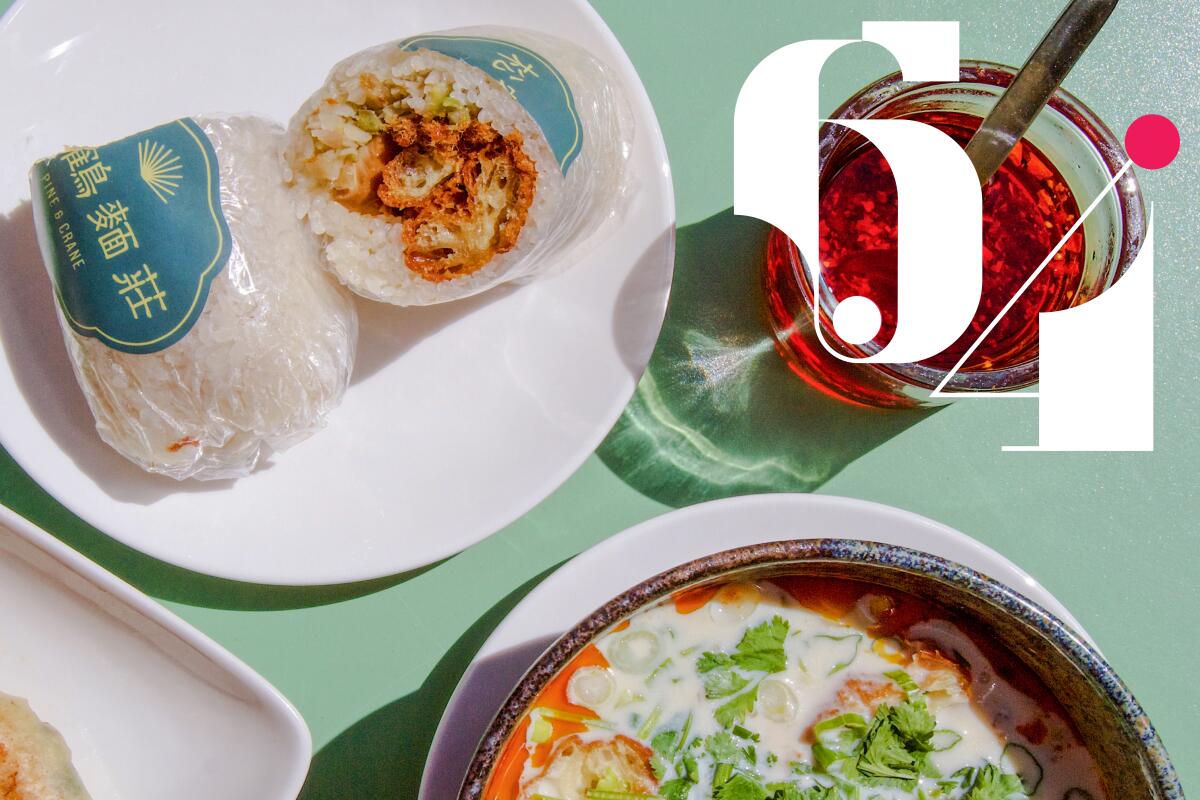
Pine & Crane
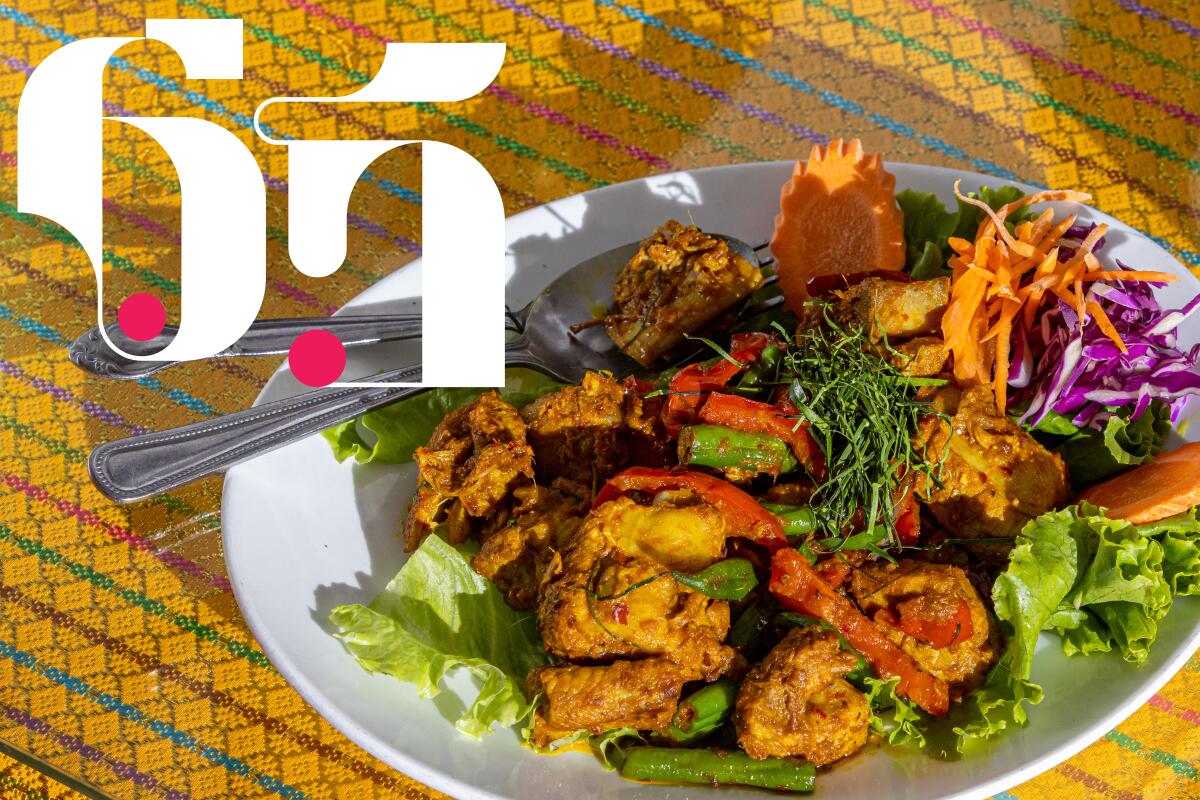
Jitlada
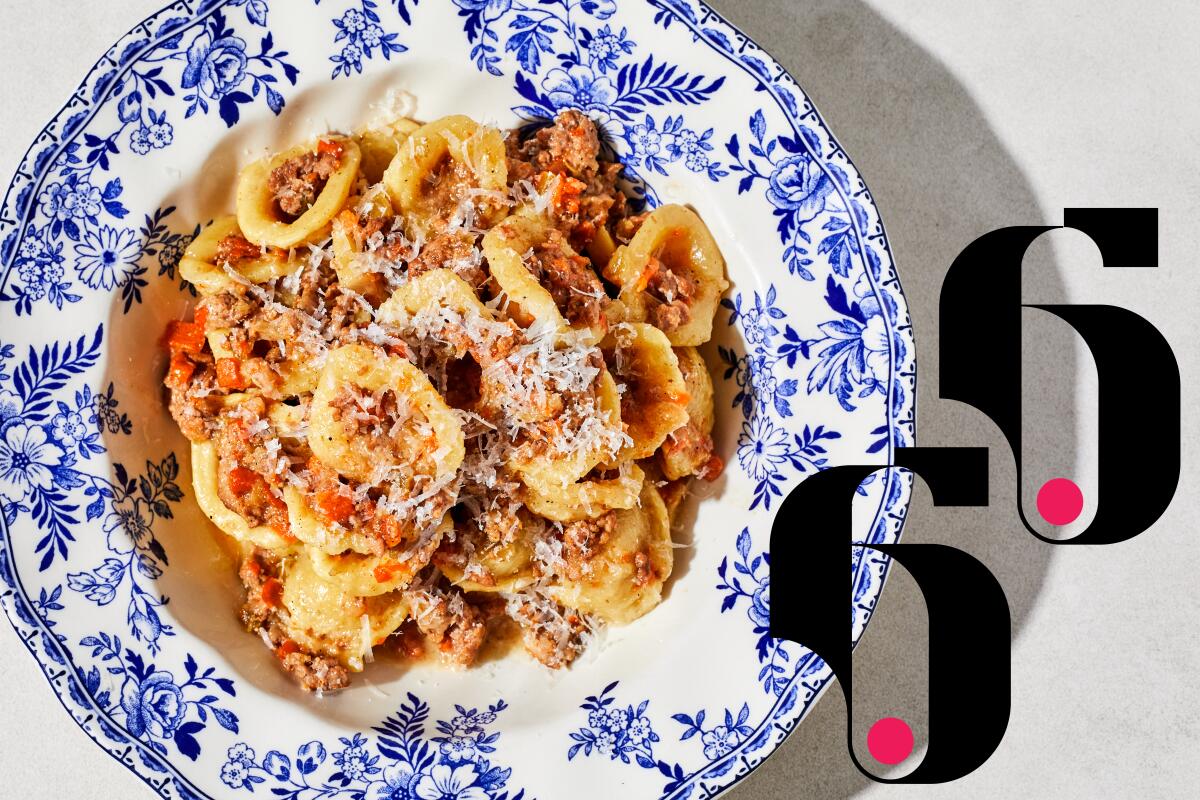
Rossoblu
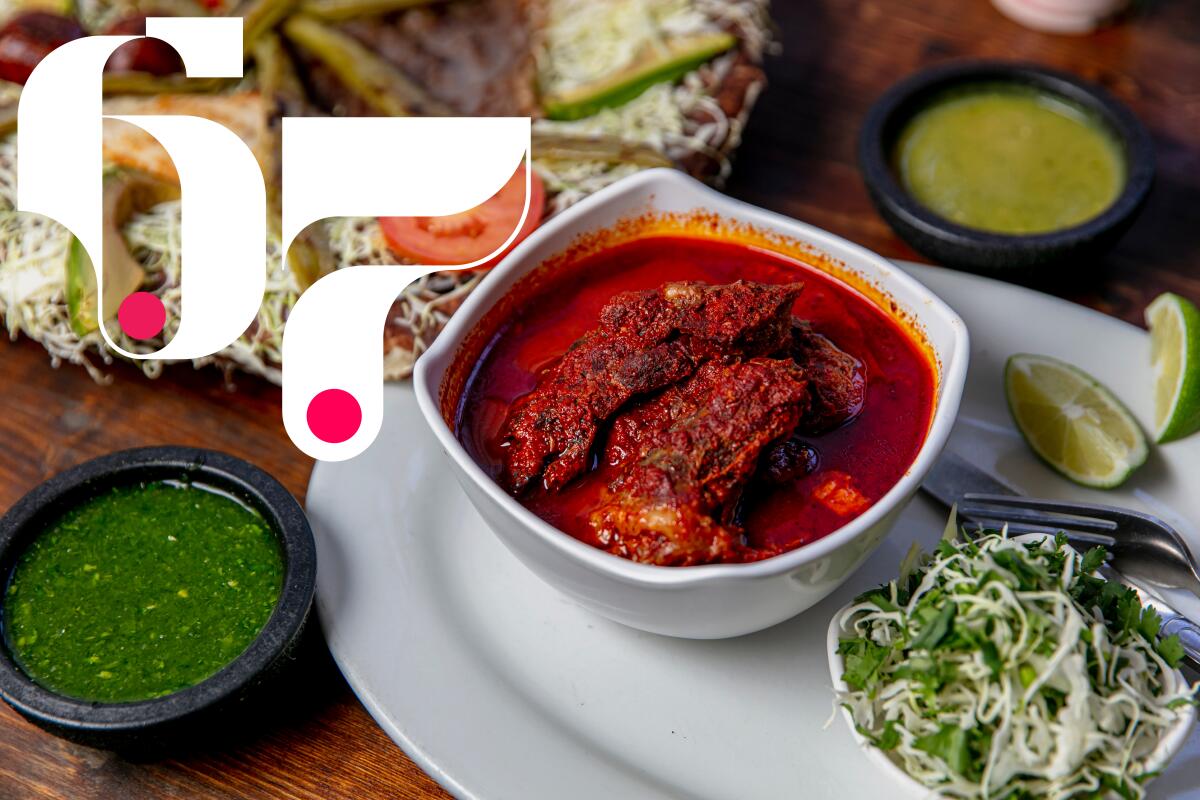
Gish Bac

Northern Thai Food Club
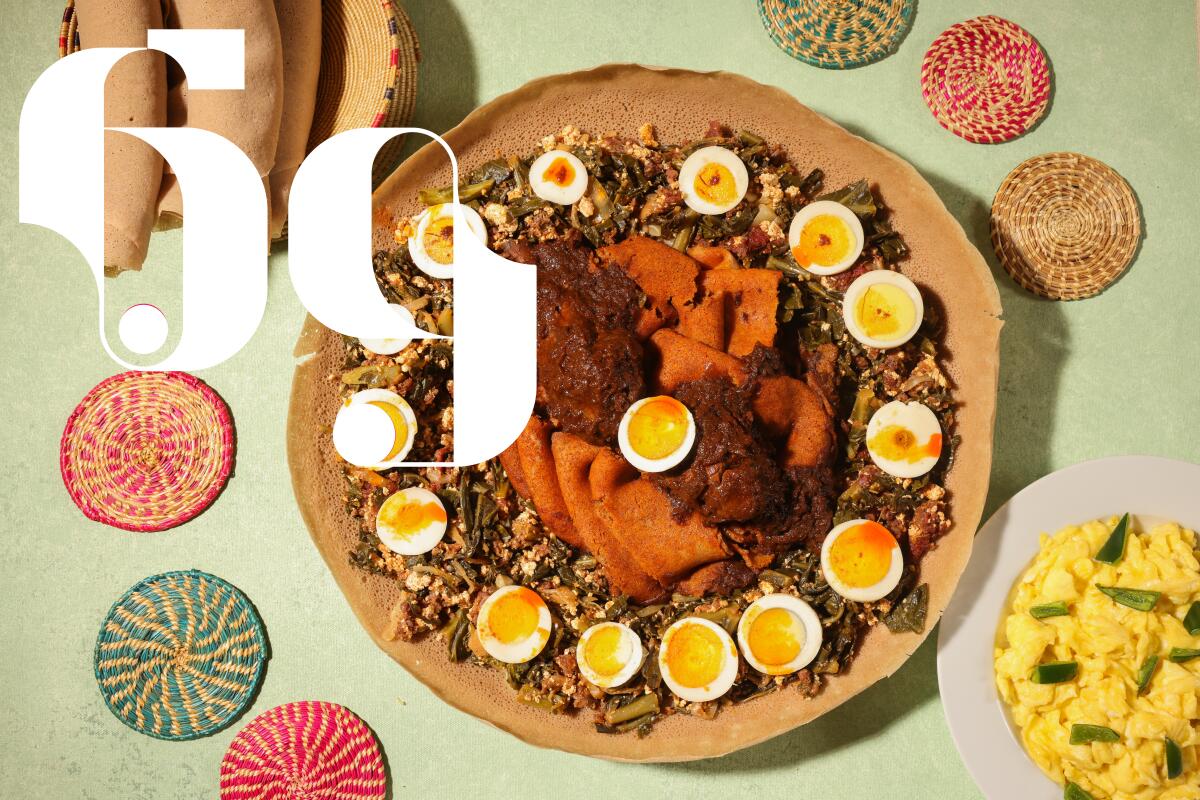
Lalibela
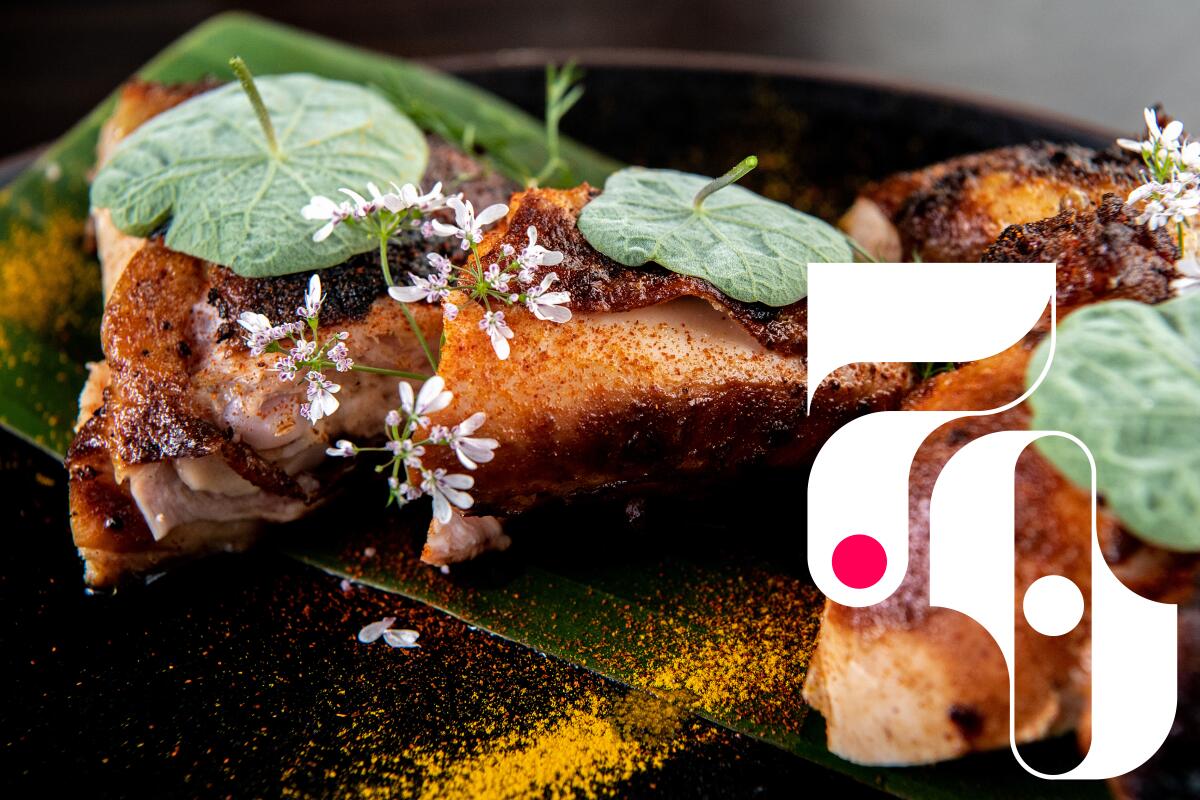
Selva
The quickest route to happiness at Selva is via the bandeja paisa, a one-platter feast synonymous with Colombia. Thick, ruddy slices of steak fan across one edge of the plate. A spiral of other meats and sides — grilled chorizo or morcilla, extra-crisp hunks of pork belly, golden lobes of plantain, smoky beans, white rice, a griddled arepa filled with corn and queso, a fried egg, sliced avocado — ends with a tuft of pickled onions arranged in the center like a bull’s-eye. Colombians tend to enjoy their hot dogs, called super-perros, with toppings as layered as geological strata. For Jurado’s joyride version, a link of taut, paprika-stained Colombian chorizo peeks out from beneath a topsoil of crumbled cotija, charred onions and peppers, jalapeño jam, aioli mixed with salsa verde (a mulchy, punchy Colombian version called ají) and, finally, smashed Lay’s chips dusted with chile powder. This is, as you might imagine, a two-handed, face-planting commitment to polish off.
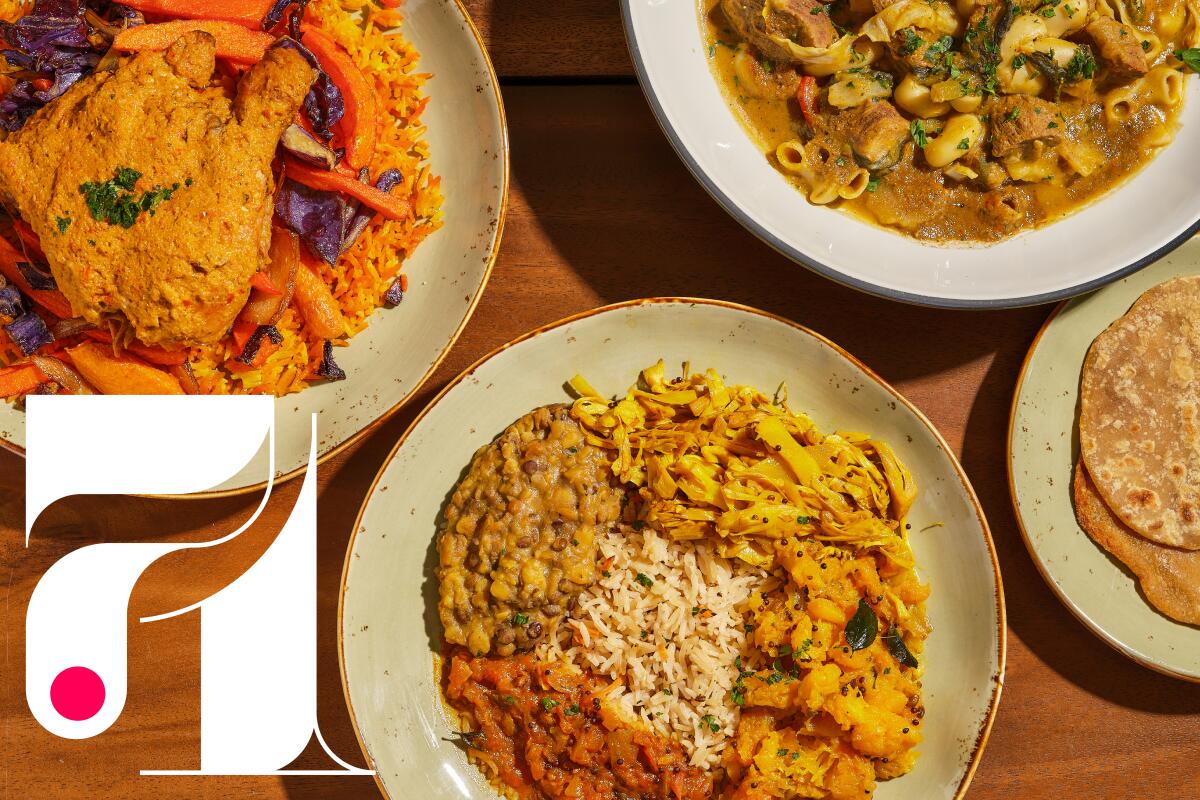
Flavors From Afar
The restaurant is an arm of co-founderMeymuna Hussein-Cattan’sTiyya Foundation, which assists families of refugees, immigrants and displaced Indigenous communities. Nearly half of the profits from Flavors From Afar go to Tiyya’s support programs. To keep up with the featured cuisines, many of which are otherwise uncommon even in L.A.’s vast dining landscape, the plant-filled dining room in Little Ethiopia warrants monthly visits — and an Instagram follow.
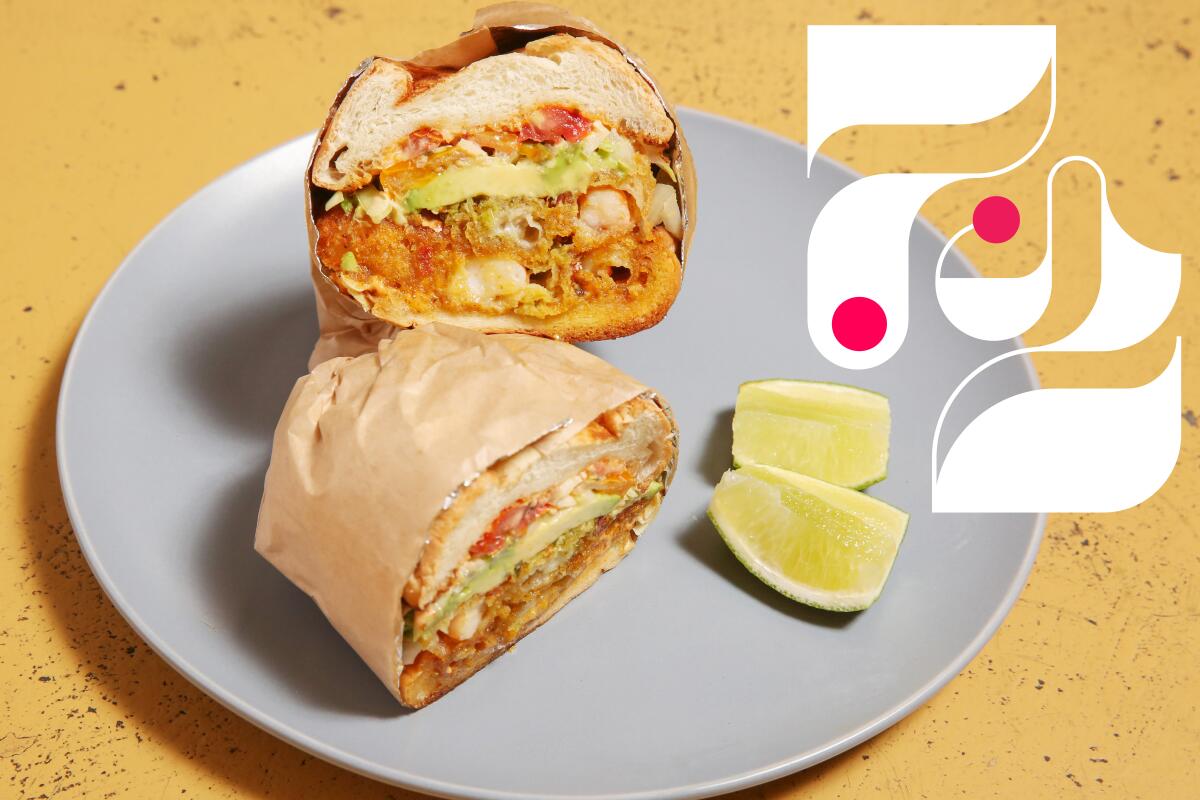
Angry Egret Dinette
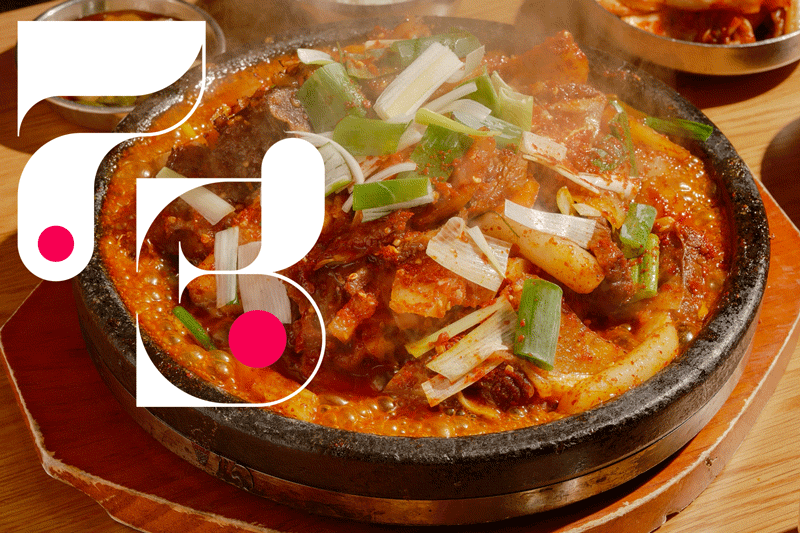
Sun Nong Dan
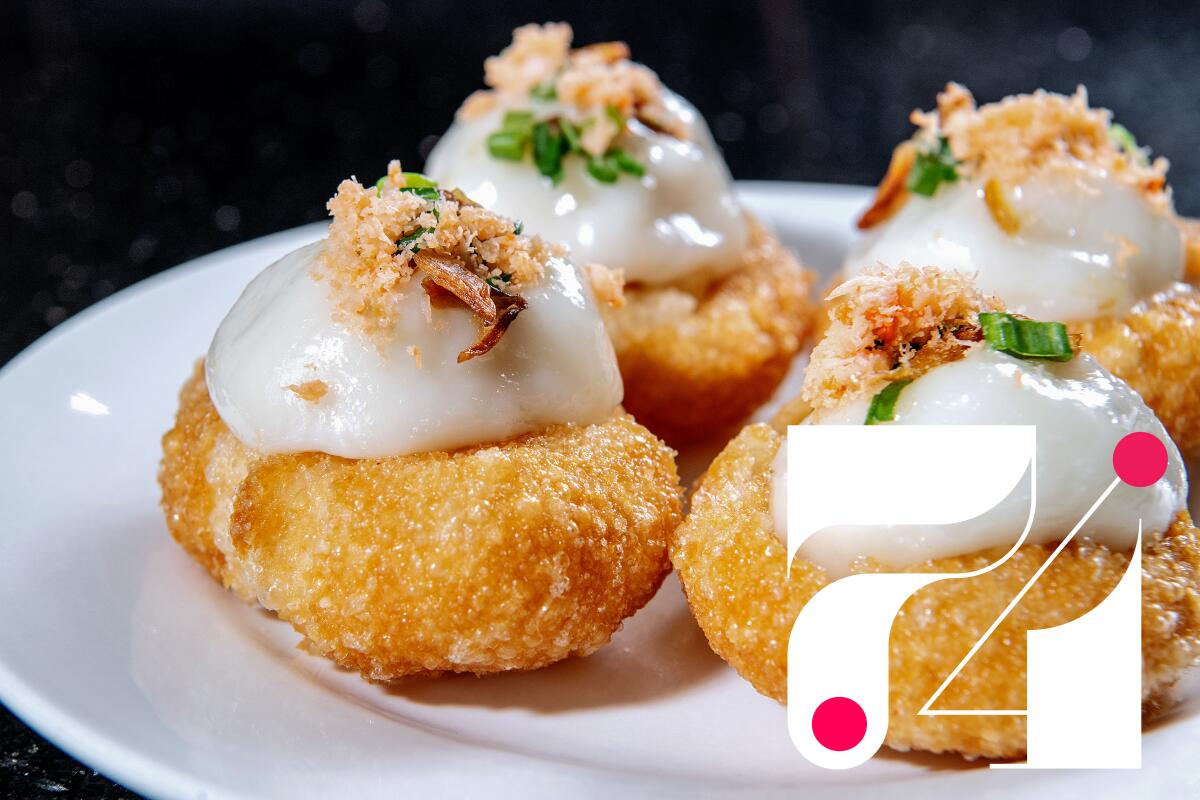
Ngu Binh
Add another to your roster: Ngu Binh in Westminster, where Mai Tran prepares dishes from Thua Thien Hue, a province in central Vietnam famous for its royal cuisine. Bún bò Hue dac biet (spicy noodle soup abundant with several cuts of pork and beef), bánh bèo (slippery rice cakes textured with minced shrimp and crunchy pork skin) and bánh ít kep bánh ram (dumplings of glutinous rice dough filled with shrimp and pork and then set on a disc of lacy fried dough) are excellent immersions into Tran’s regional specialties. A new location in Fountain Valley, alternately referred to as Ngu Binh 2 or V-Land, has an expanded menu of translucent dumplings and tables outfitted with big comfy wicker chairs.
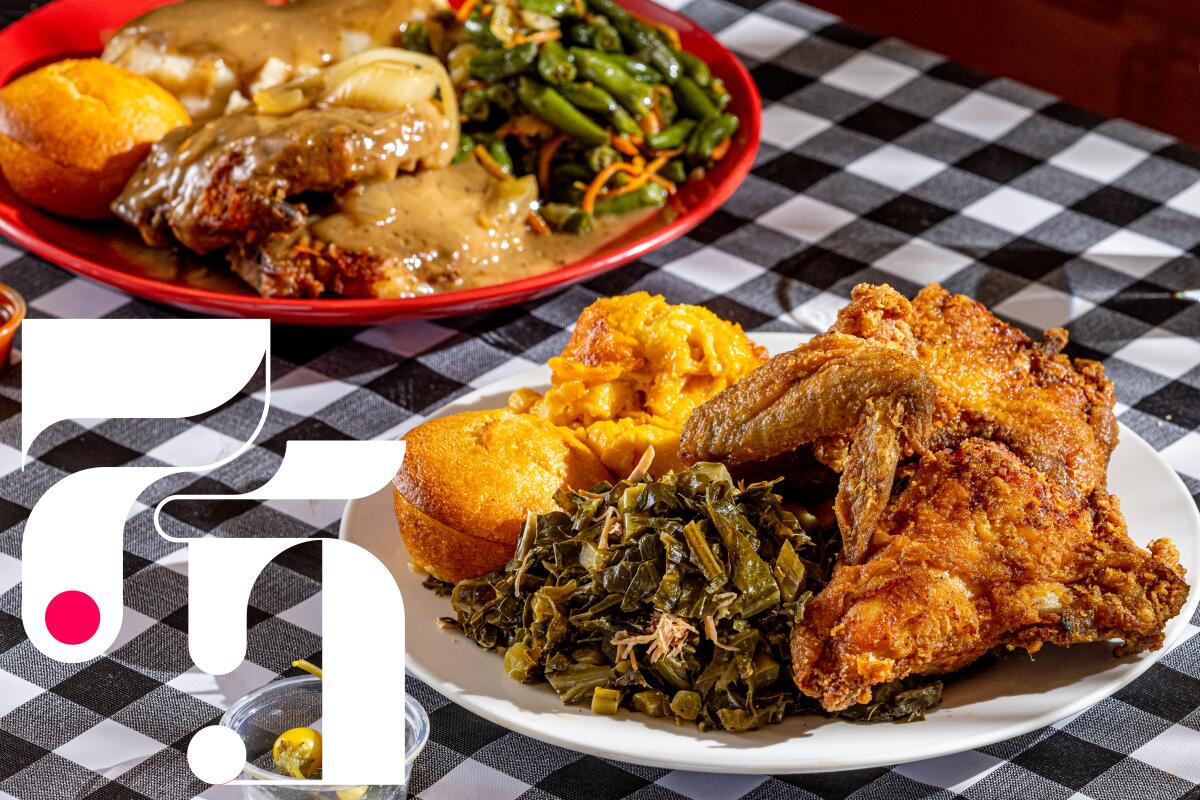
Dulan’s
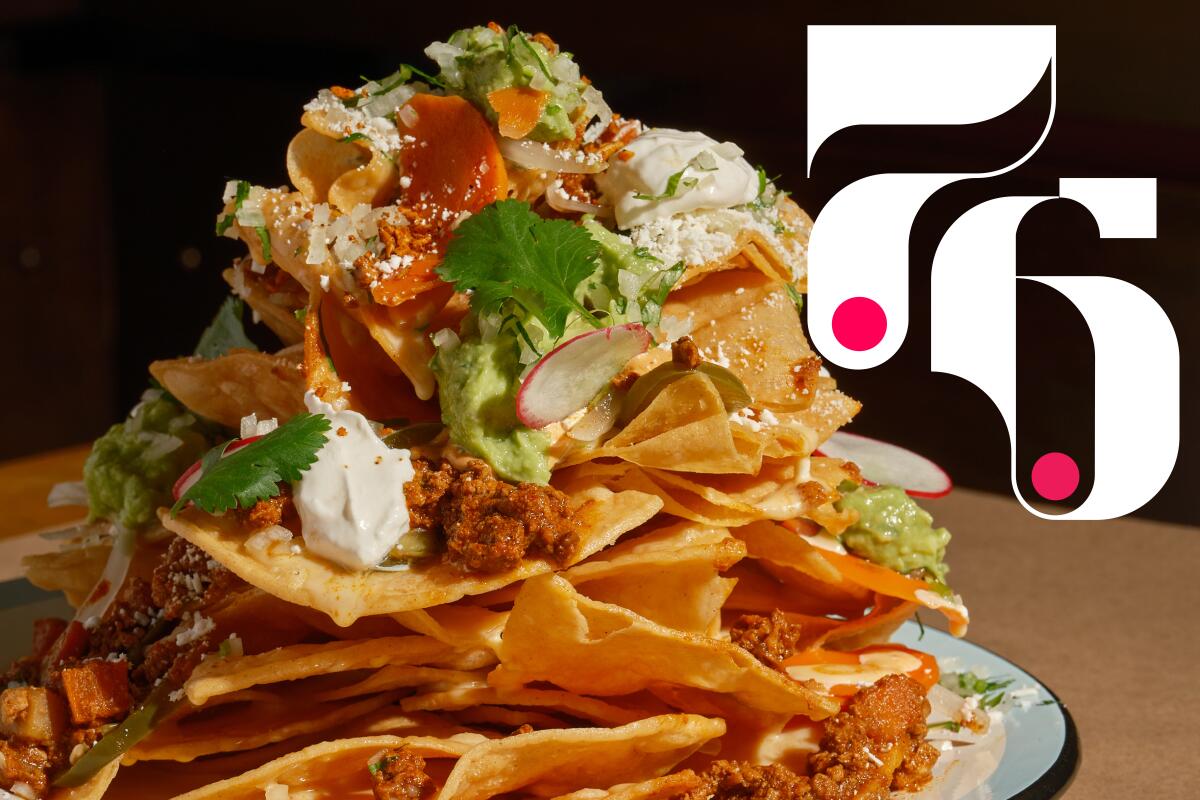
Bar Amá
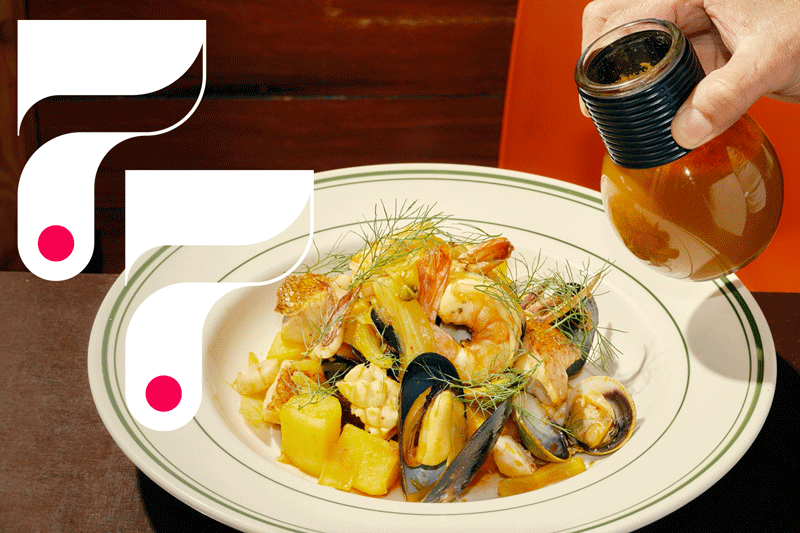
Connie and Ted’s
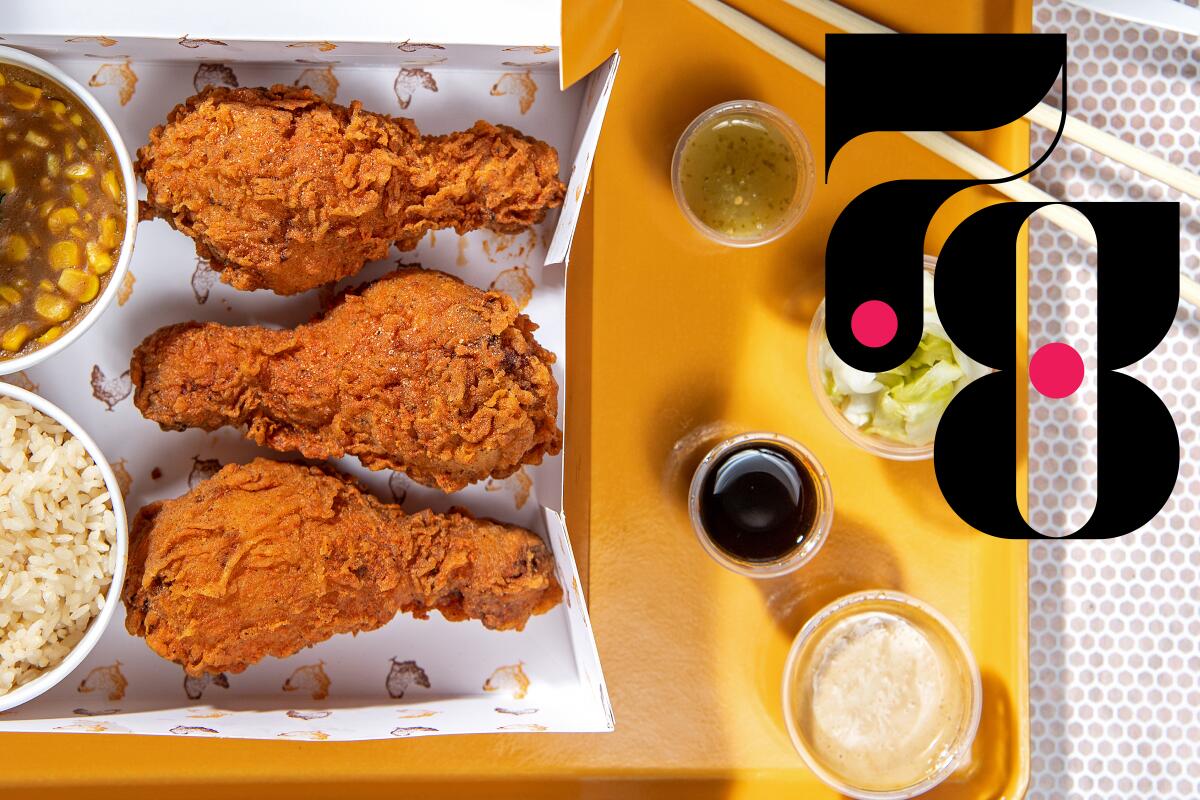
Tokyo Fried Chicken Co.
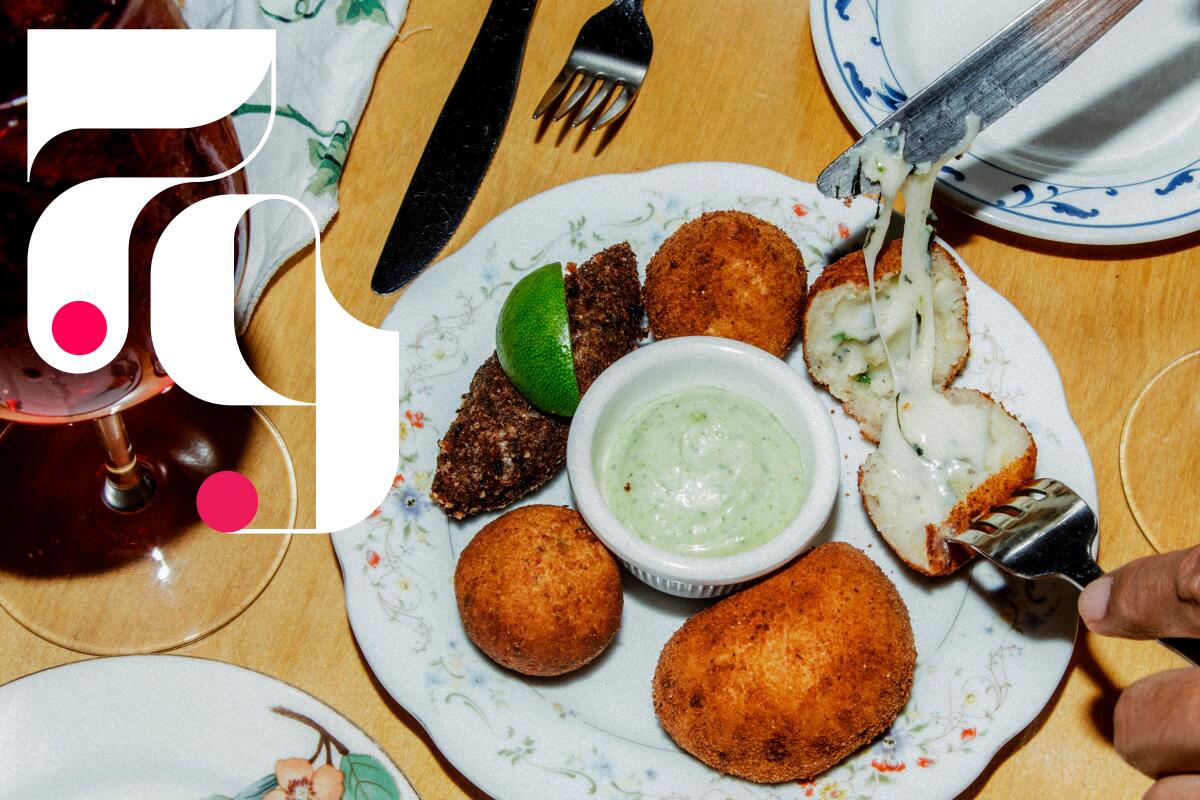
Woodspoon
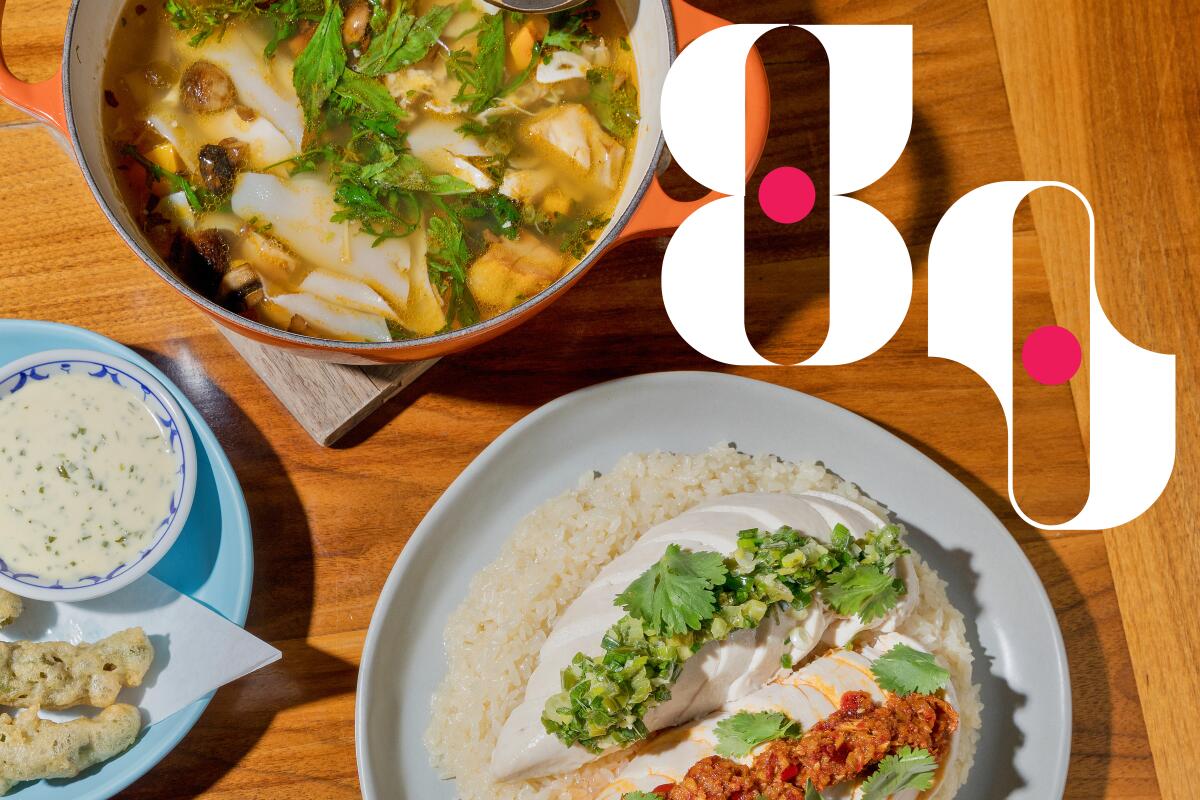
Majordomo
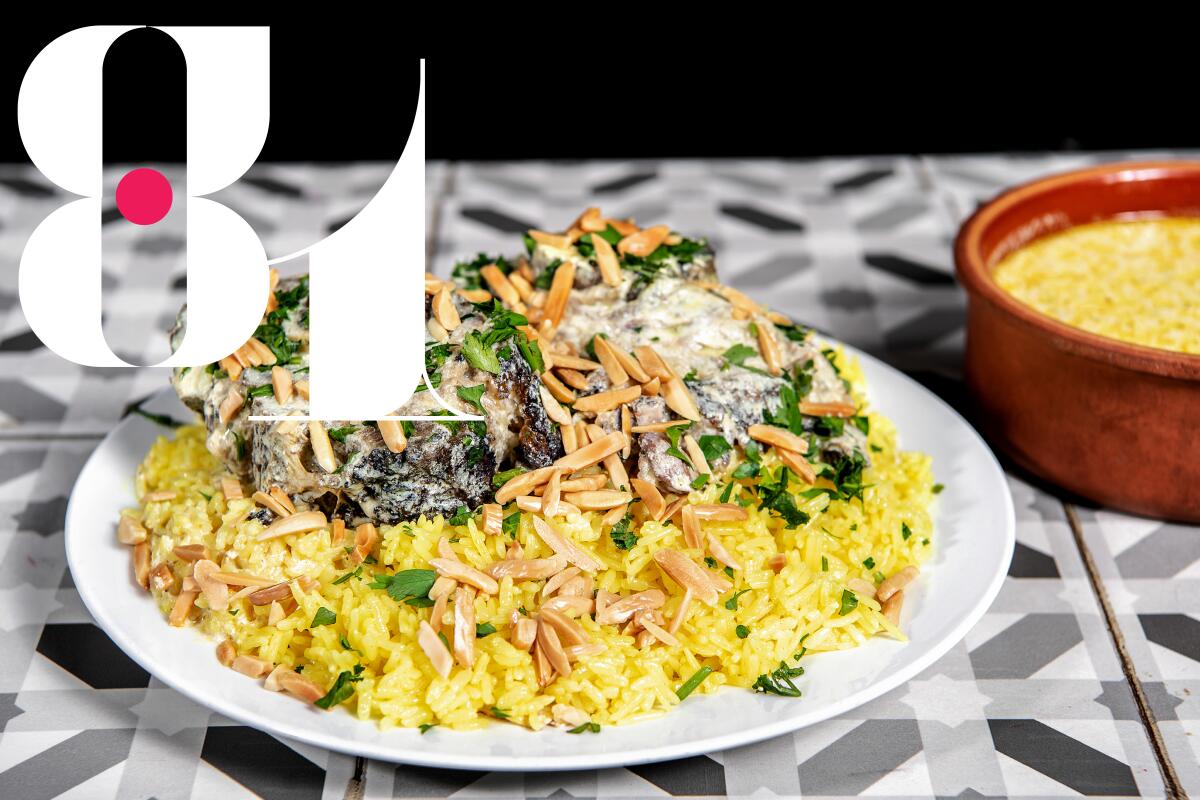
Al Baraka Restaurant
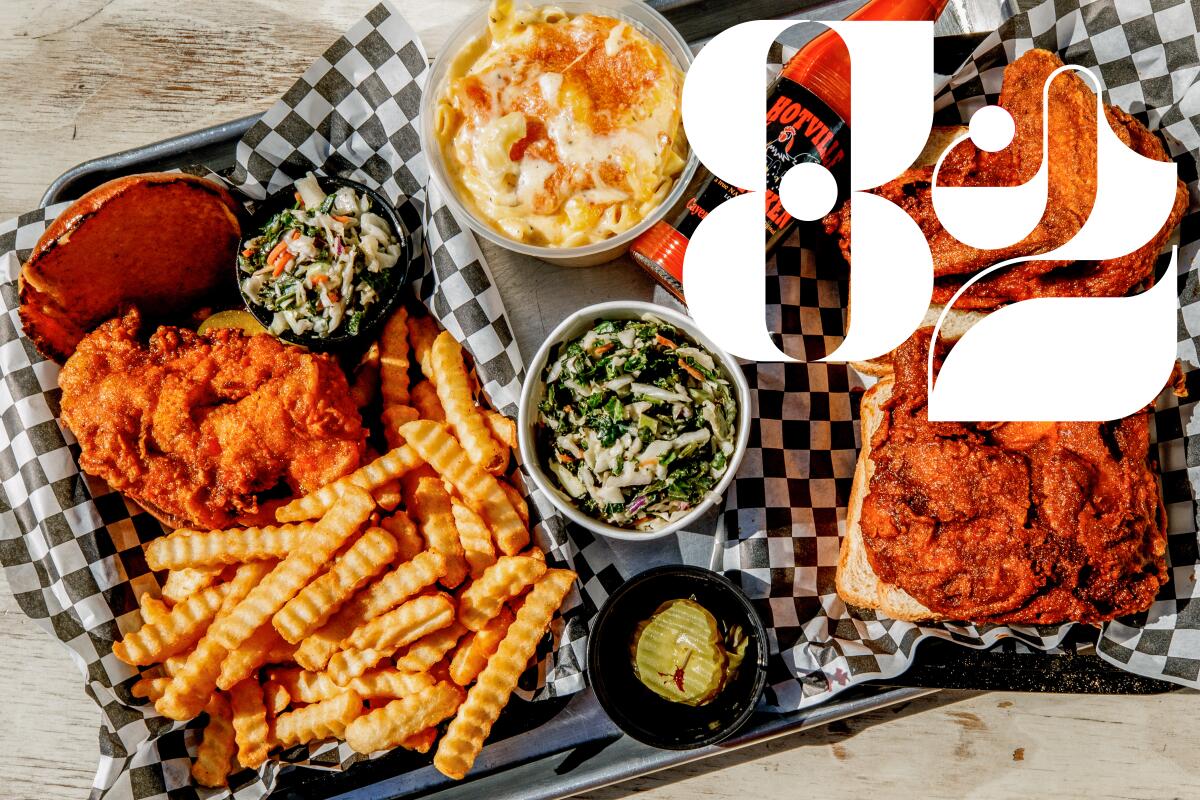
Hotville Chicken

Ipoh Kopitiam
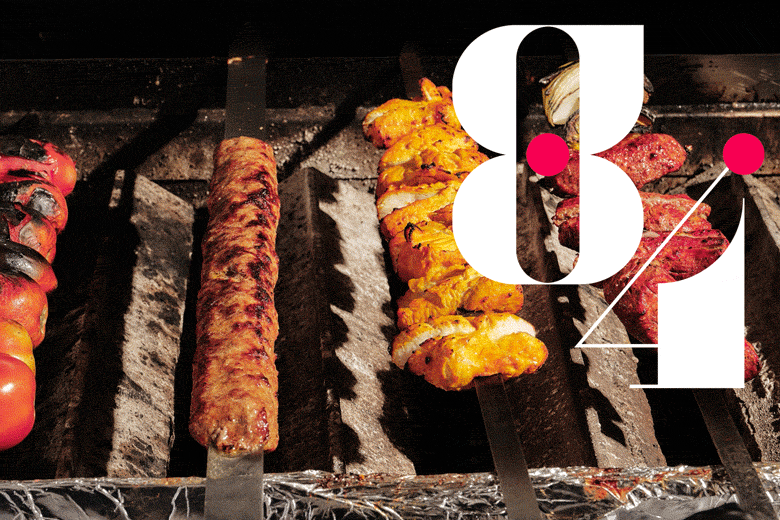
Taste of Tehran
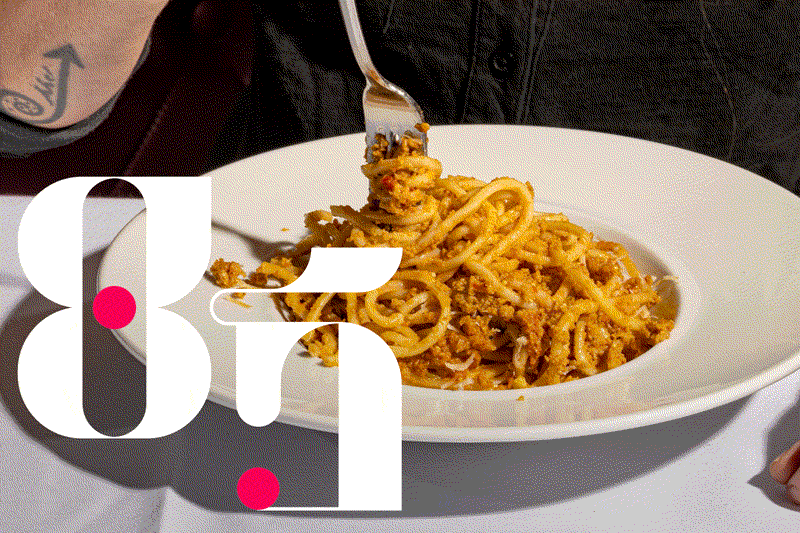
Crossroads Kitchen
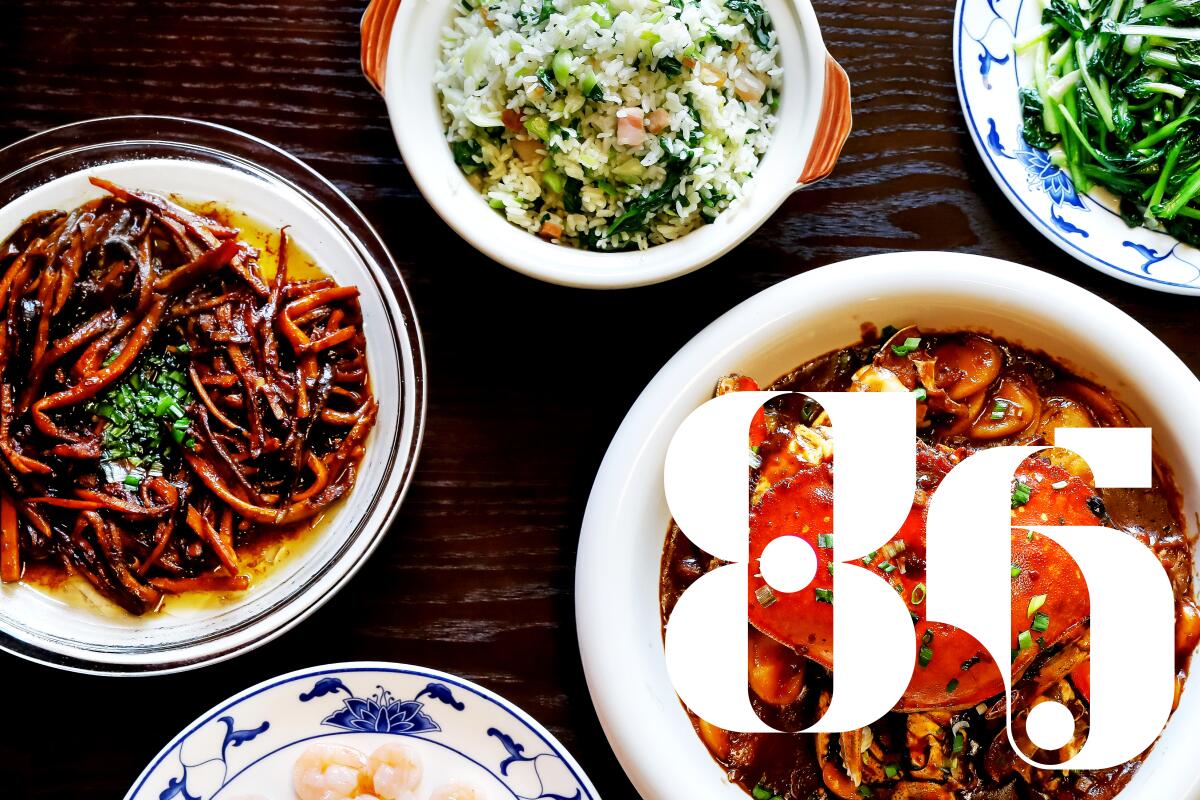
WangJia Restaurant
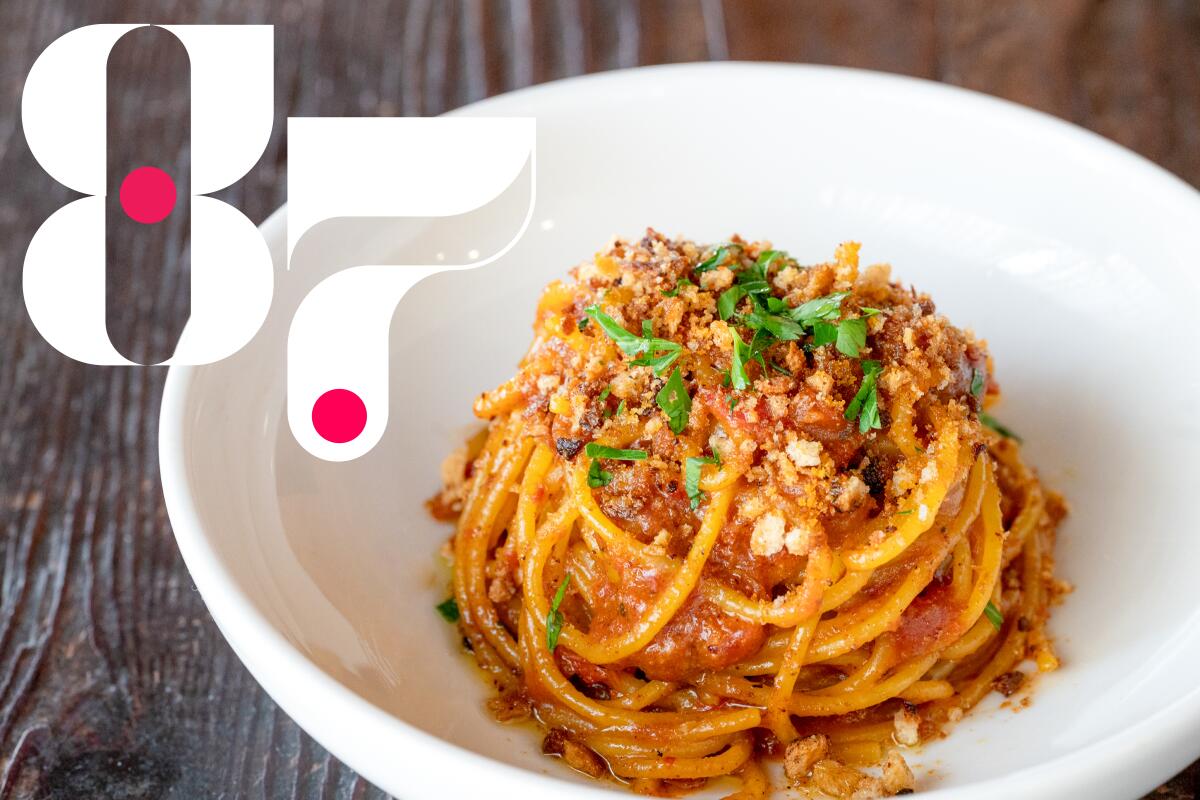
Gjelina

La Pupusa Urban Eatery
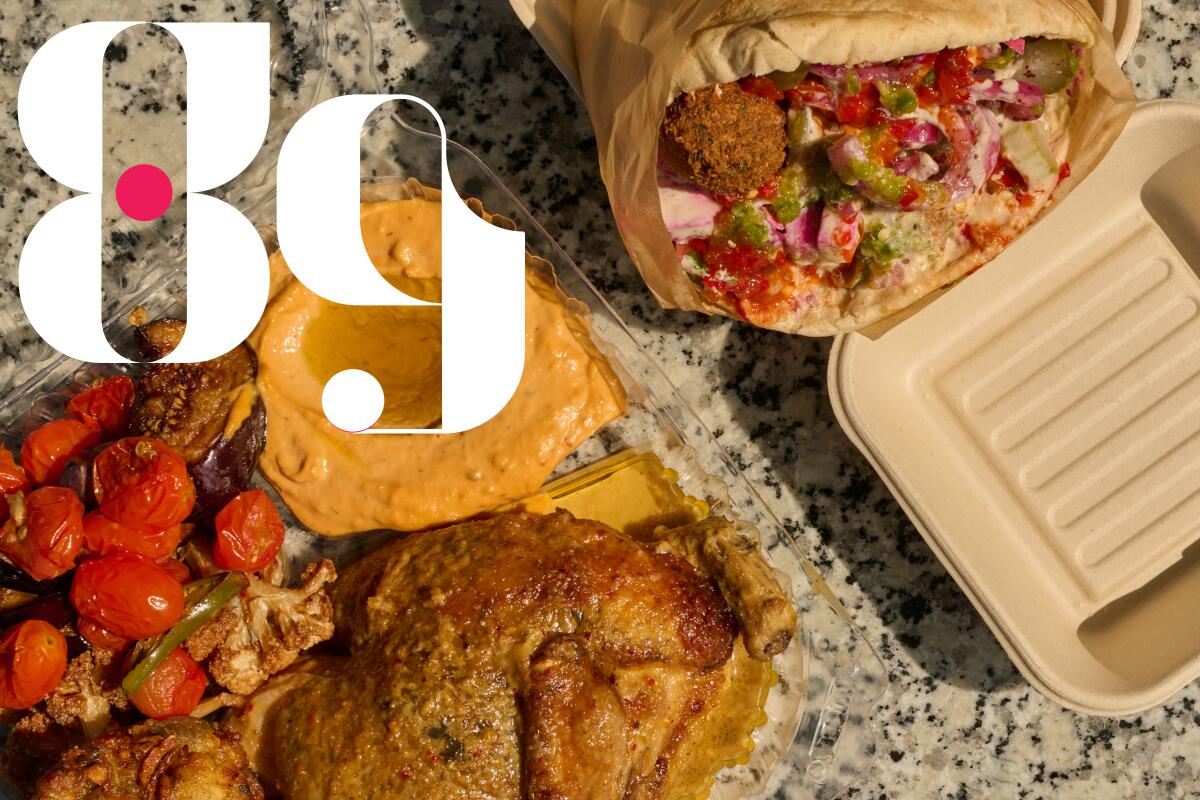
Jerusalem Chicken
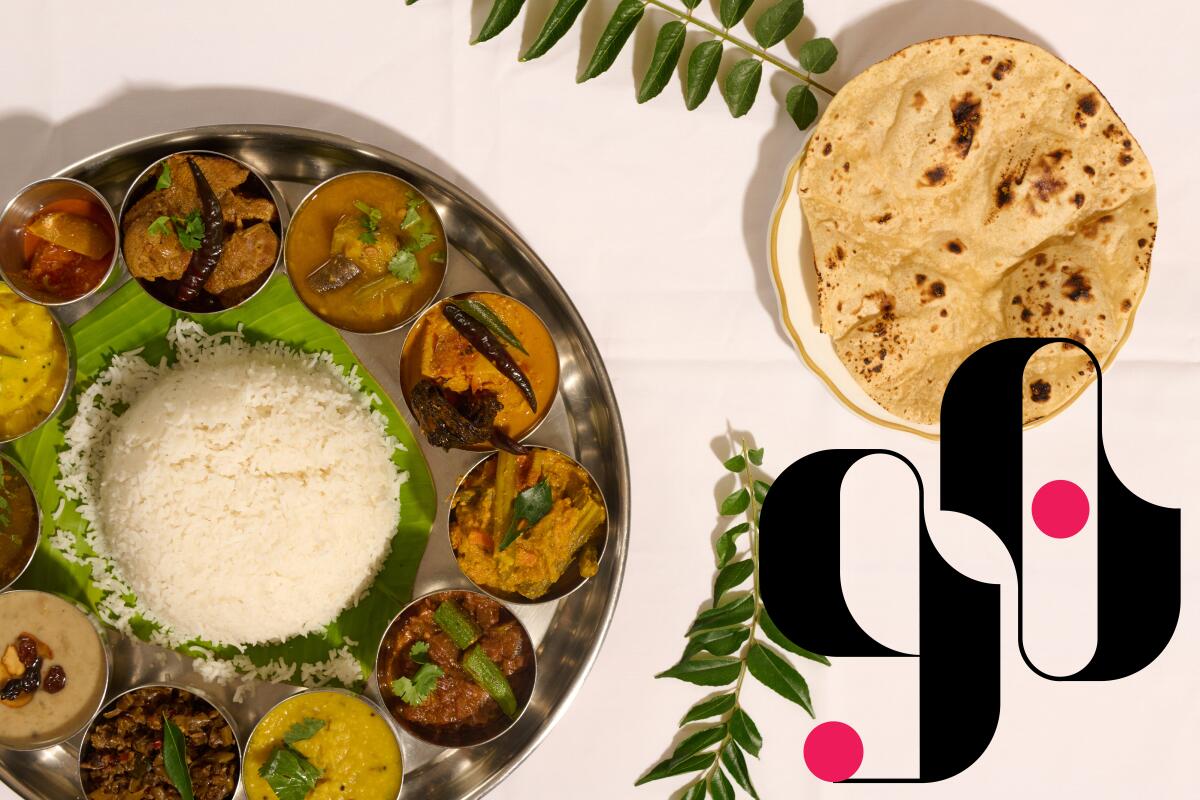
Mayura Indian Restaurant
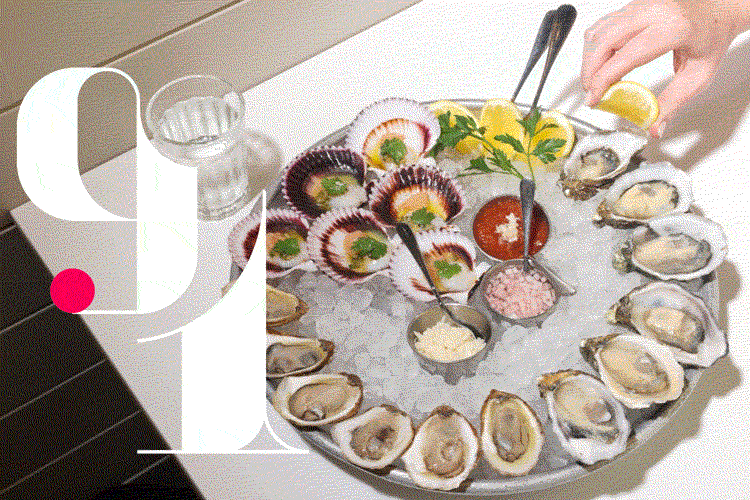
Fishing With Dynamite
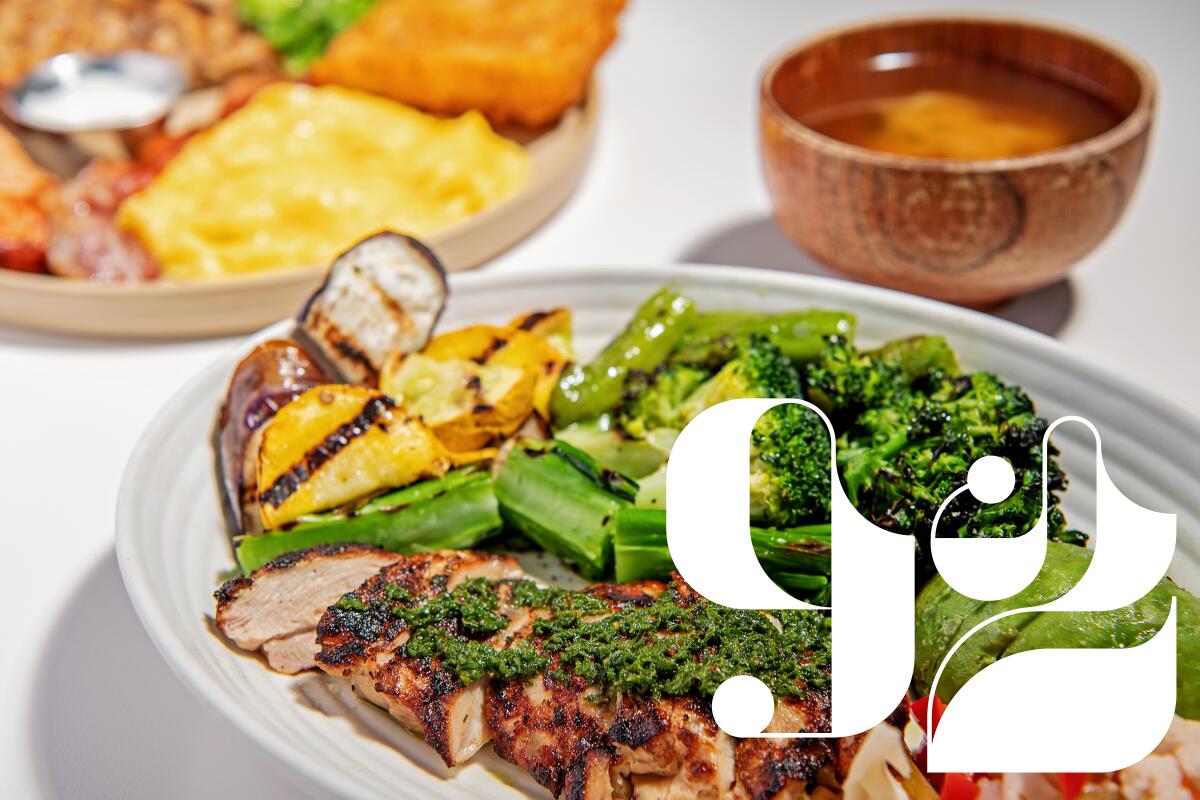
Yang’s Kitchen
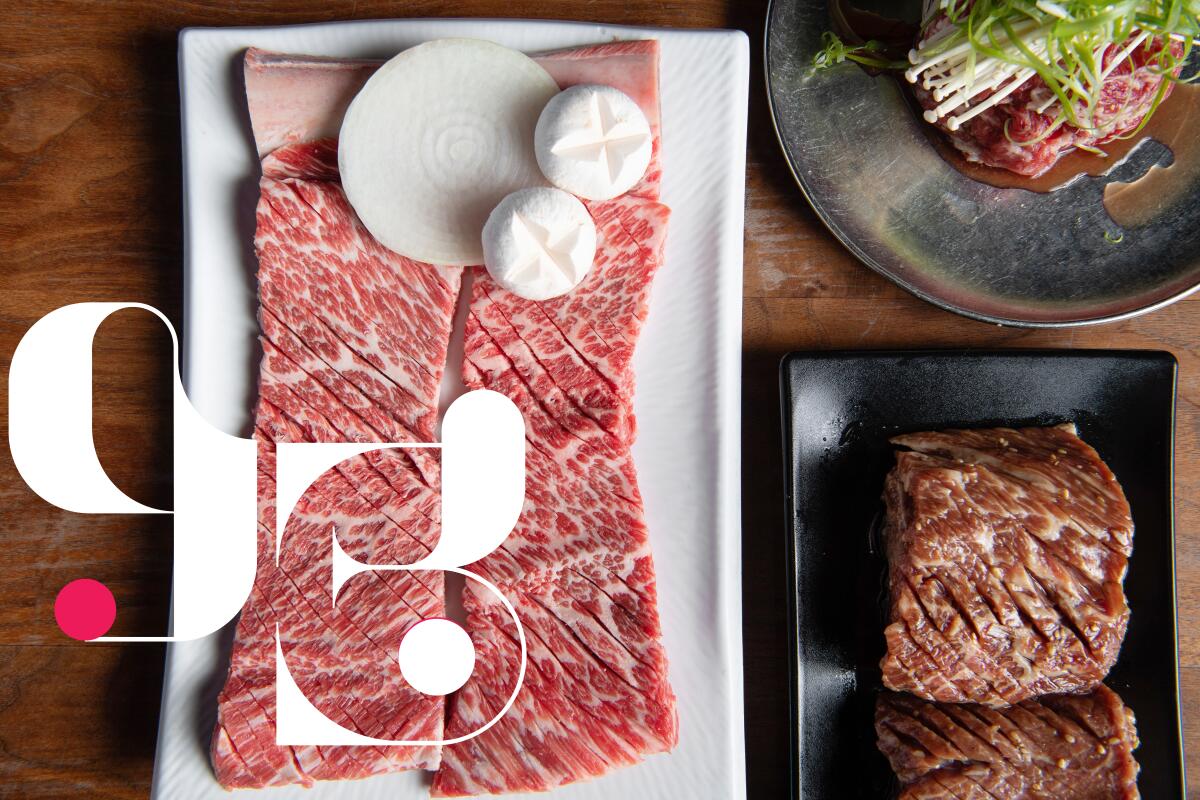
Park’s BBQ
Literally dozens of barbecue houses line the streets of Koreatown. By all means, visit Soot Bull Jeep for the smokiest charcoal-fueled experience; Sun Ha Jang for the duck variations; and one of the latest top-dollar entrants for dry-aged beef. But for overall quality and hospitality, Jenee Kim’s operation is still the place to be.

Elite
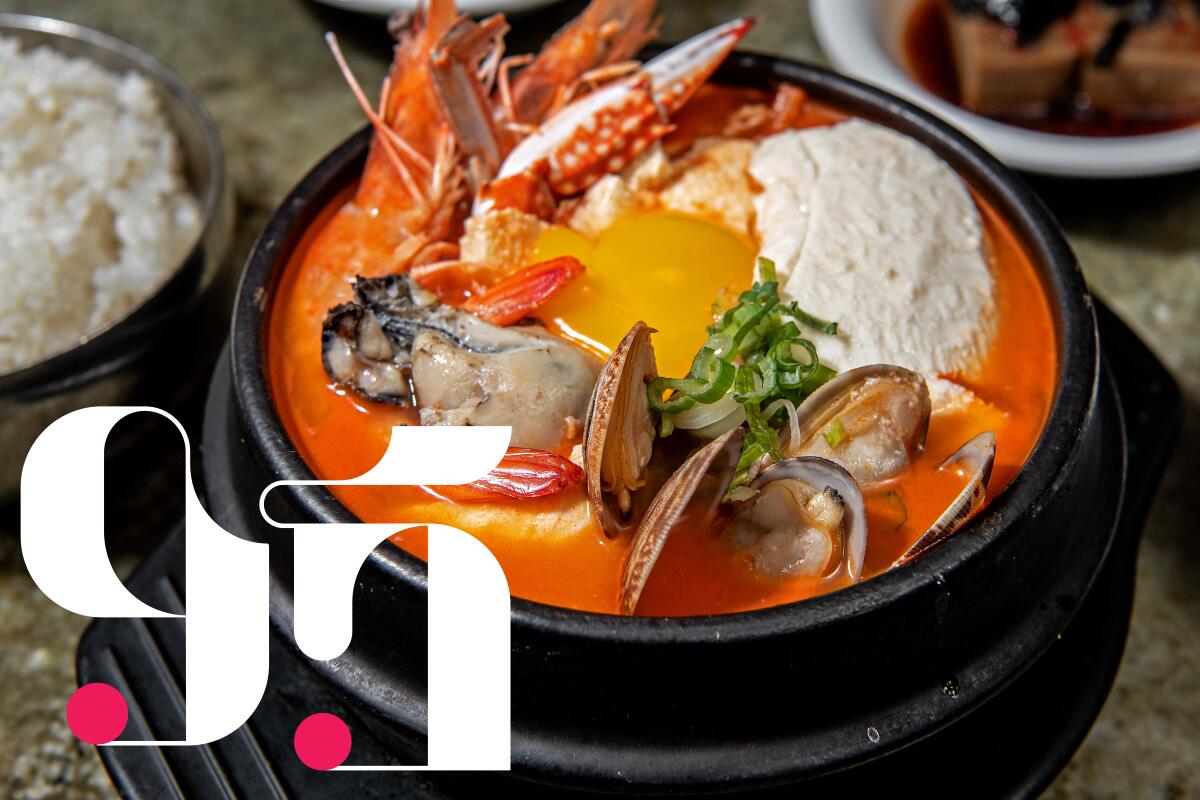
Surawon Tofu House
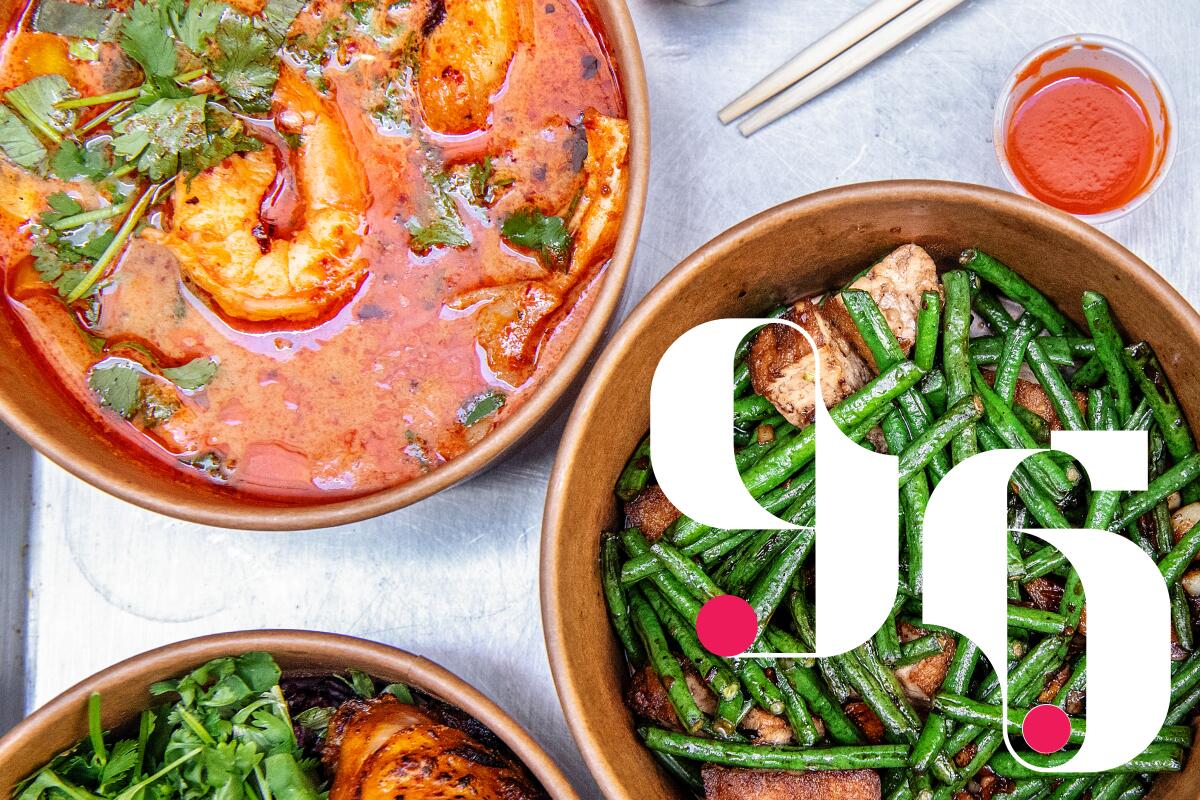
Holy Basil DTLA
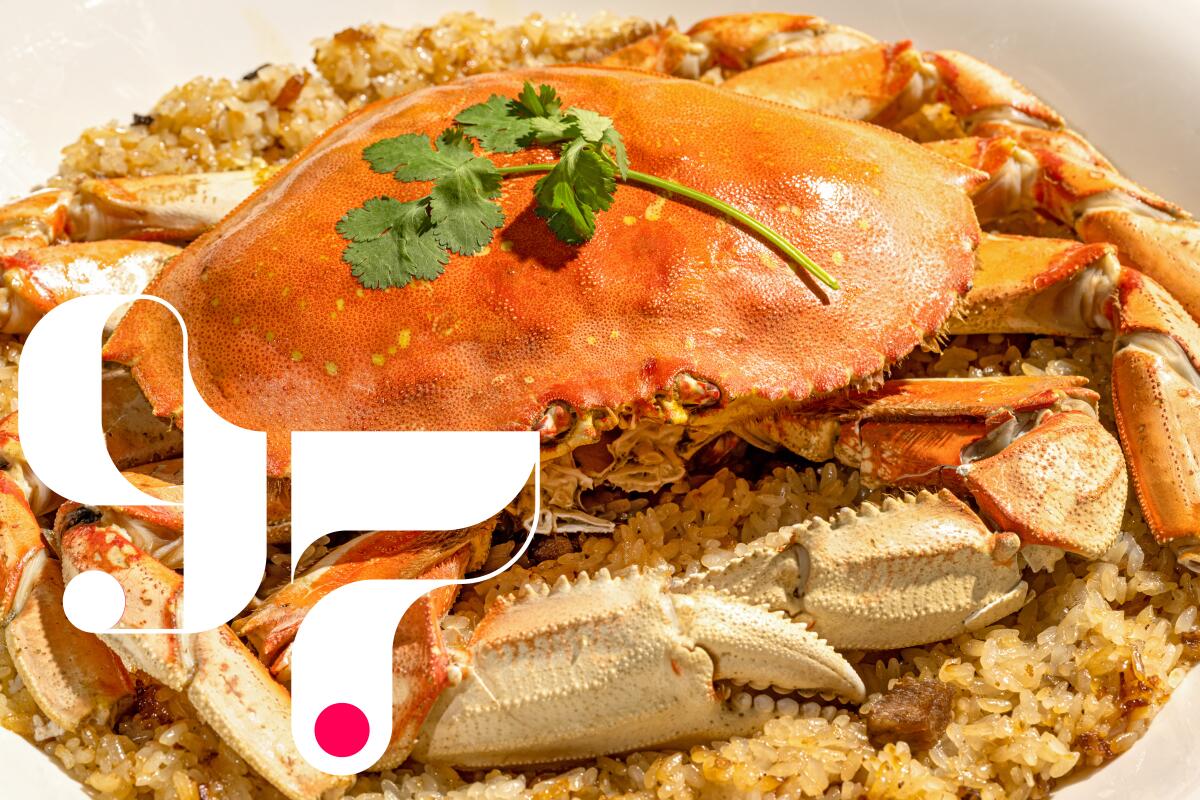
Eat Joy Food
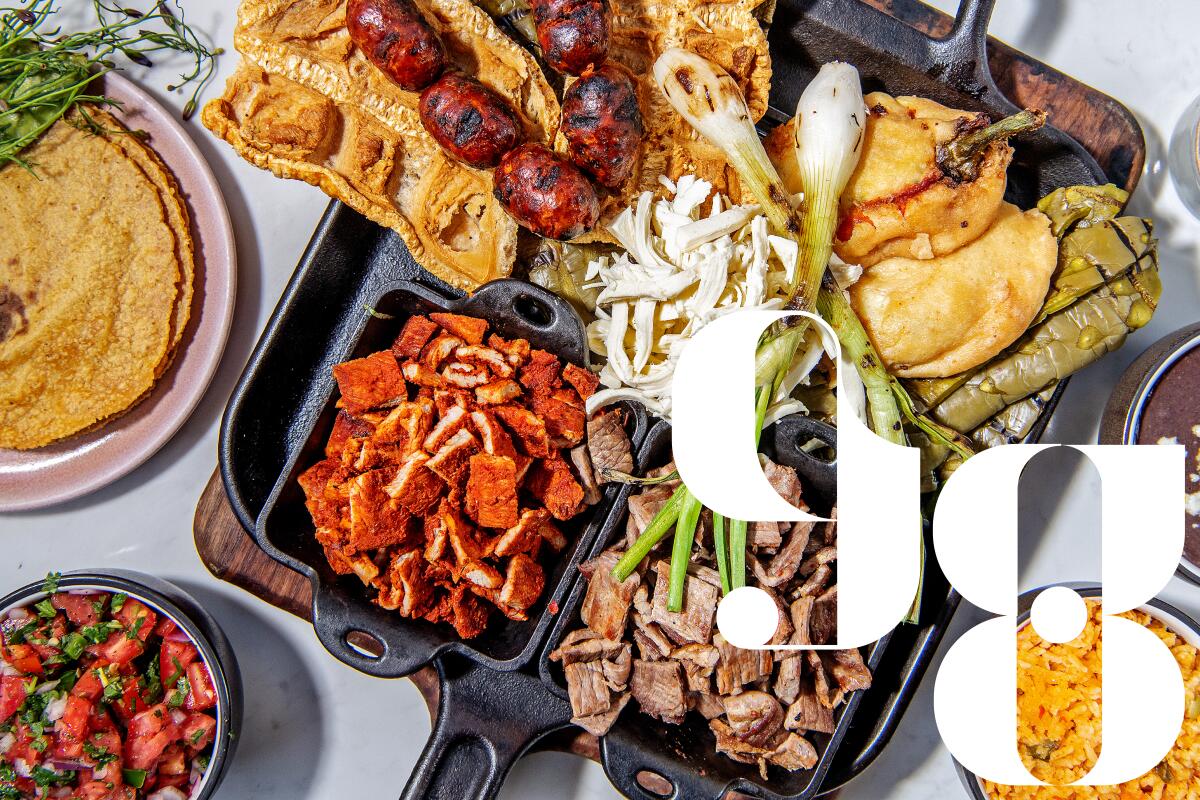
Madre
You’ll need food soon. Start with memelas, satisfying in their thick crunch and filling of black beans and queso fresco. Among moles, home in on the distinctive estofado, with its sharp turns of tomatillo, raisin, almond and green olive. Vasquez’s mother, after whom the restaurant is named and whose recipes serve as inspiration, made it twice a week for her family.
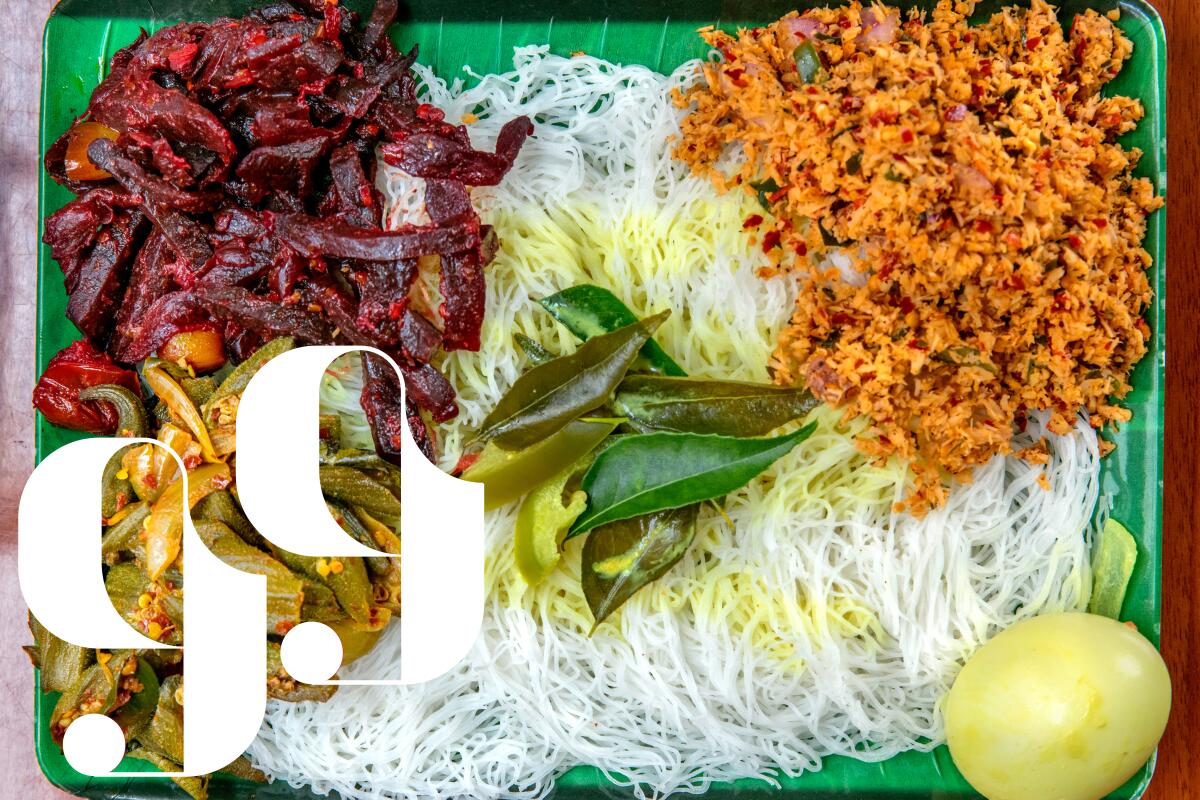
Apey Kade
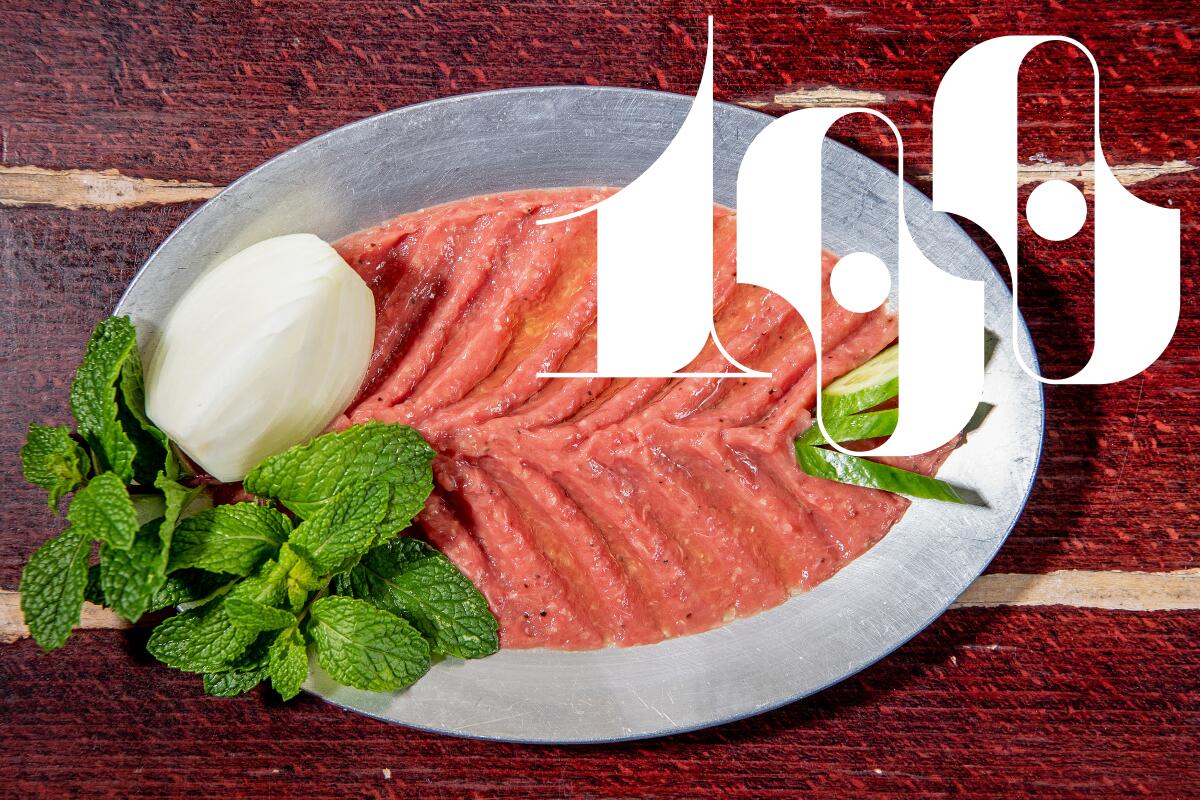
Skaf’s
The same friends taught me a smart, common request for shawarma wraps, which are meant to be modestly sized, densely packed cylinders: Ask for them to be rolled in a single layer of pita, as in one half of a separated pocket. The thin ring of bread is still sturdy enough to contain the ingredients but equalizes the proportions. Crisp-edged chicken shawarma has a slight advantage over its beef counterpart, particularly with extra garlic sauce.
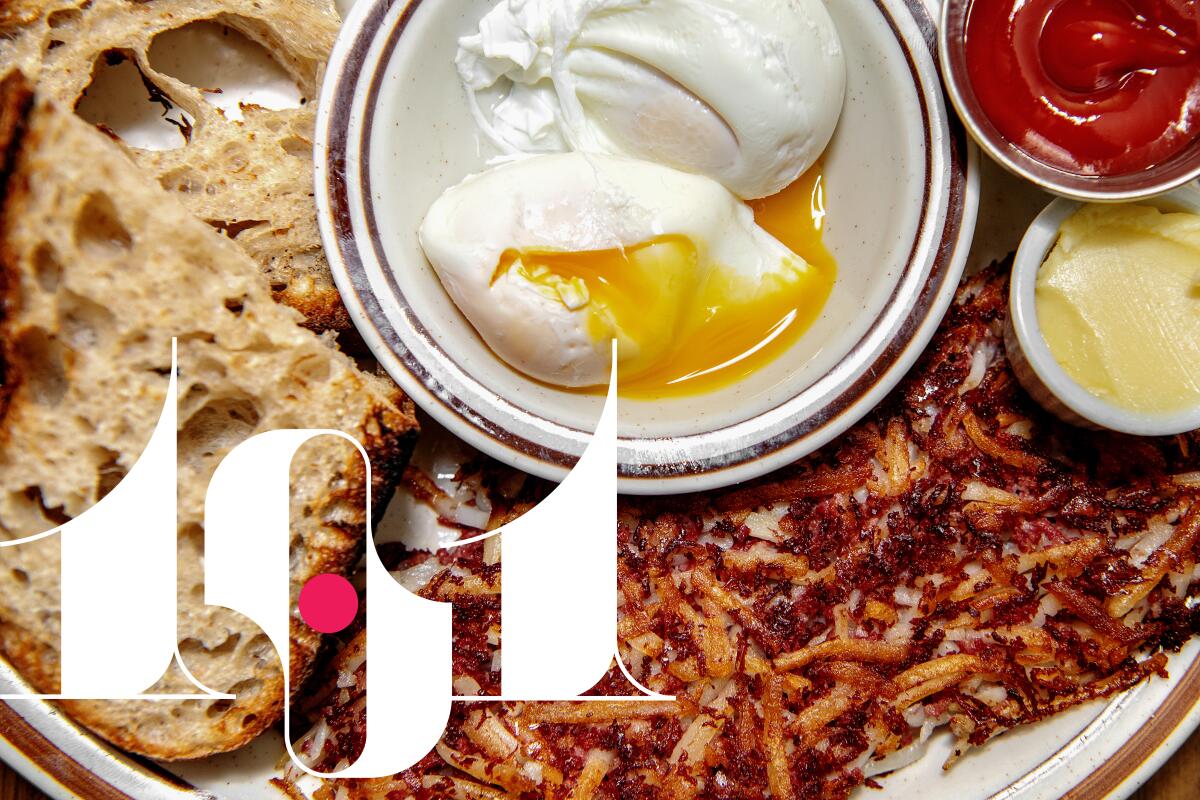
Clark Street Diner
Juan Pablo Garcia, who was chef at the Brentwood outpost of Clark Street Bread, leads the kitchen. The breakfast and lunch diner classics are stealthy good, as in finely tuned and arguably better than they need to be. There’s nowhere in Los Angeles I’d rather eat a three-high stack of blueberry pancakes. Corned beef hash delivers satisfying proportions of crisp-soft spuds, salty wisps of meat and over-easy eggs. The spirit truly reanimating the scene, though, is the staff. Sally Stewart, with her ageless rock ’n’ roll energy (her husband is, in fact, a touring musician), had worked as a server at the 101 and returned. She practices a steely sort of patience when friends change their order three times in 90 seconds. I’m always happy when she walks up to our table.
Eat your way across L.A.
Get our weekly Tasting Notes newsletter for reviews, news and more.
You may occasionally receive promotional content from the Los Angeles Times.

